What’s the GO with RO?
GRAPE PRICES under pressure
GROUNDED IN SUSTAINABILITY
The lowdown on healthy soil
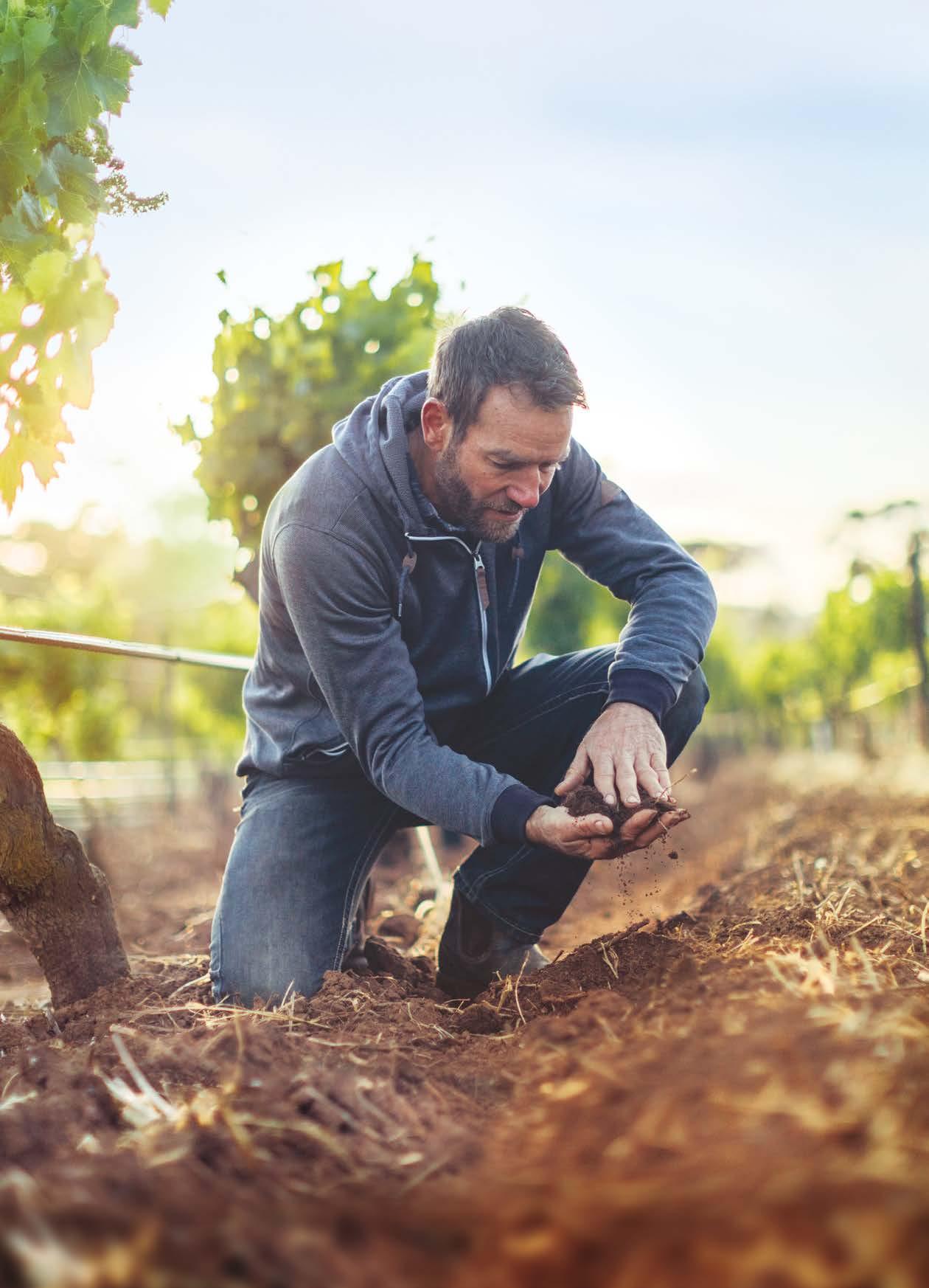
MARCH 2023 2023 ANNUAL THEME: INNOVATION | ISSUE THEME: VINEYARD FOCUS
FULLCOLOR FULLPROTECT ESSENTIAL ANTIOXIDANT

• Specially formulated product containing tannins and yeast polysaccharides.
• This blend maximises and stabilises the colour of red wine while giving a rounder, approachable palate.
• 100% natural product.
• Blend of specific yeast derivatives and antioxidant gallic tannin.
• These work synergistically to protect from oxidative reactions.
• FullProtect enhances aromatics and improves longevity while also enhancing mouthfeel.
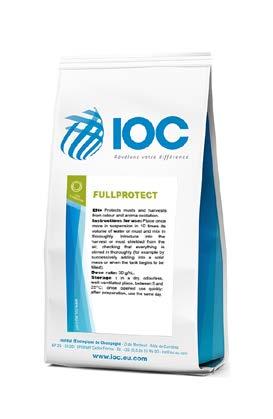
• Pure Gall nut tannin.
• Protects musts and wines from oxidation in difficult conditions.
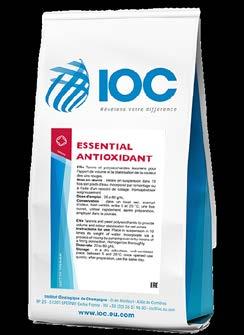
• Improves aromatics and colour.

• Early addition to grapes, must or juice will significantly influence the quality of your resulting wine.
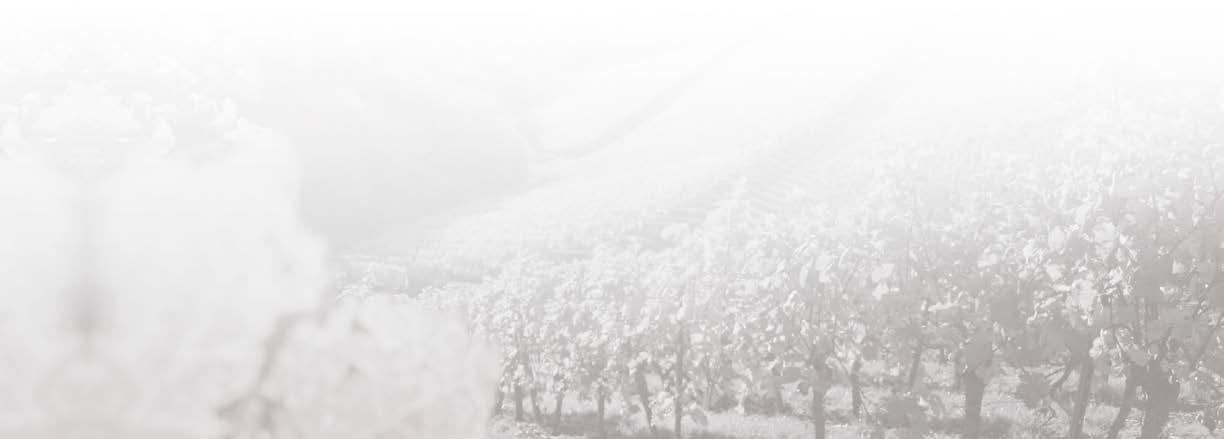
YOUR VINTAGE 2023 TOOLBOX
NEW
The JUCLAS Crossflow respects the organoleptic and structural characteristics of your wine, yet has the ability to process significant volumes on a daily basis. It has the ability to filter juice, sparkling wine and still wines pre-bottling.
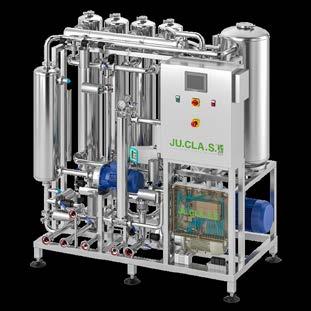
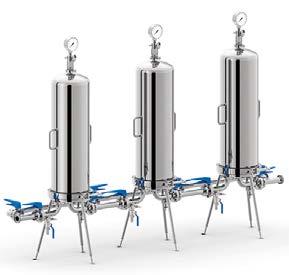
FILTER HOUSINGS



Our filter housings utilise new technological filtration media to ensure quality filtration with a minimal impact on wine. These housings are rated for absolute filtration and are made of AISI 304 stainless steel.

FILTER CARTRIDGES
Our range of filter cartridges includes a wide variety of formats and lengths for existing and new applications. These cartridges are ideal for use with our Alteco filter housings.
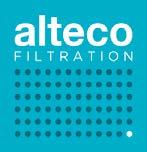
Victoria 59 Banbury Road, Reservoir 03 9462 4777 South Australia 16 Burdon St, Dudley Park 08 8365 0044 New South Wales 2/40 Bradmill Ave, Rutherford 02 4932 4511 Western Australia Unit 5, 1 Ostler Drive, Vasse 08 9755 4433 Tasmania 9 Swanston Park Drive, Waverley 03 6722 5050 New Zealand 3 Estuary Place, Richmond, Nelson +64 9 4412 262 Email us at sales@winequip.com.au WWW.WINEQUIP.COM.AU
FILTRATION OPTIONS FOR ALL PRODUCERS
CROSSFLOW

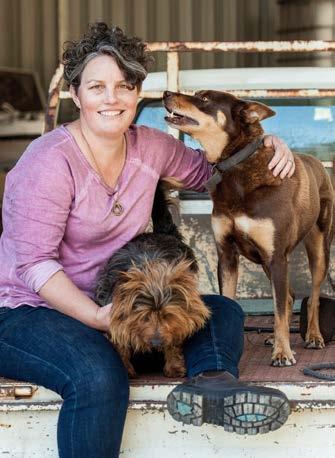

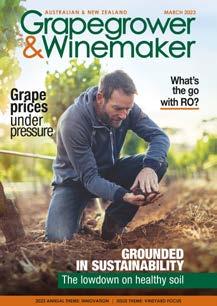
4 Grapegrower & Winemaker www.winetitles.com.au March 2023 – Issue 710 41 65 86
The March 2023 issue
Winemaker
on
with a look at aspects of soil health in particular.
the
COVER:
of Grapegrower &
focusses
the vineyard,
Pictured on
cover
is Kym Kalleske of Kalleske Wines in the Barossa.
MARCH 2023 ISSUE 710 contents REGULARS 7 Winetitles Insights 8 What’s Online 8 In This Issue 12 International briefs 46 Ask the AWRI 89 Producer Profile: Chris Scott 91 Calendar 91 Looking Back 92 Marketplace Classifieds NEWS 9 WISA appoints new executive chair 10 Shaky Bridge Wines names Mike Kush as winemaker and GM 11 Tahbilk honours James Halliday AM with cellar building dedication GRAPEGROWING 14 FEATURE Stressors and facilitators to adoption of sustainable viticulture 20 FEATURE Understanding, measuring and ameliorating soil composition in vineyards 32 Growers beware of infected grafted vines 34 Fungicide resistance: effective management practices for healthy vines and budgets 41 Chenin Blanc Uncorked WINEMAKING 47 Taylors Wines boasts clear benefits of water filtration system 53 FEATURE Reverse osmosis and value adding 56 Amphorae in vogue 61 Behind the Top Drops: Dal Zotto Col Fondo Prosecco 65 Young Gun: Tash Arthur
Photo is courtesy of Wine Australia.
BUSINESS & TECHNOLOGY
70 FEATURE Renewed growth in wine and viticulture degrees provides industry optimism
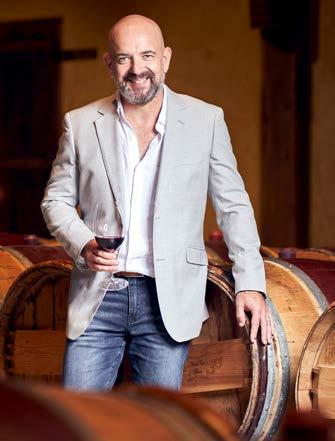
74 Grape price pressures add to growers’ woes
79 Endeavour Group appoints new chief financial officer

SALES & MARKETING
80 FEATURE A glass act
84 The flow of Australia’s rich wine history revealed in forthcoming publication
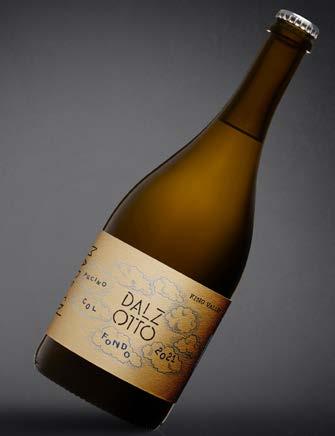 Hans Mick Editor
Hans Mick Editor
Welcome to the March issue of the Grapegrower & Winemaker which has a focus on the vineyard. Speaking of vine rows and fruit, we hear that vintage has been running late in several, though not all, Australian wine regions. However, those that have begun picking fruit have reported excellent quality for the grapes coming off the vines. Vintage 2023 brings with it a continuation of challenges and will raise hard questions regarding the future for individual operators and the industry as a whole. It’s likely to be a pivotal point that could determine the viability and potential longevity of many – but the grape and wine sector has successfully navigated downturns and shocks to the system before, and there’s always the chance that 2023 may surprise us all by offering some unexpected optimism.
Staying grounded for the time being, we explore important aspects of soil health. Firstly, we look closely at the attributes of soil for the adoption of sustainable viticulture (page 14). Then we turn to vineyard wheel traffic and compaction of soil to better understand its composition. We present trial data related to this from page 20. Dr Richard Smart informs us about his concerns about trunk disease and, specifically, the threat posed by infected grafted vines (page 32). With wet conditions having had such an effect on the past growing season for many, writer Simone Madden-Grey provides an overview of effective management practices for Botrytis, powdery mildew and downy mildew with an eye on improving efficiencies and costs (page 34). We also profile South Africa’s favourite variety, Chenin Blanc, in our regular Uncorked feature (page 41).
Heading into the winery, Sonya Logan
examines the technology behind an advanced new water filtration system installed and successfully utilised at Taylors Wines in the Clare Valley (page 47). Meantime, winemaker Paul Le Lacheur uncovers the current status of reverse osmosis in wine filtration (page 53). We head to the other end of the technological scale to uncover a new revival of amphorae, a simple, ancient winemaking tool that’s risen again from the dust like an awakened mummy. Read more about its benefits for modern winemakers from page 56. For Behind the Top Drops we find out the backstory of Dal Zotto Col Fondo Prosecco (page 61), while we meet this month’s Young Gun, Margaret River’s Tash Arthur who’s blazing a renewed trail for fortified wines (page 65).
One of those challenges for growers mentioned earlier has been the increasing pressure on grape prices. There are, of course, well-understood reasons behind this and so we unpack the current state of fruit pricing across several Australian regions (page 74). We also delve into the present state of the education and training sector for viticulture and oenology (page 70). And we ask author Andrew Caillard MW to tell us how his massive (!) forthcoming set on the history of Aussie wine came to be (page 84).
There’s a lot more inside too – I hope you enjoy the read!
March – Issue 710 www.winetitles.com.au Grapegrower & Winemaker 5 89 61 EQDC Find us @winetitles
linkedin.com/company/winetitles-pty-ltd
E @winetitlesmedia D @winetitles Q @winetitlesmedia C
ABOUT Grapegrower & Winemaker
The Australian & New Zealand Grapegrower & Winemaker is a practical, solution-based journal published monthly for the wine & viticulture industry. Packed with grapegrowing and winemaking advice, it also features articles related to business, technology, sales and marketing. It profiles industry professionals, wineries, plus wine and grape varieties and much more.
NATIONAL JOURNAL OF THE WINE INDUSTRY SINCE 1963
Publisher and Chief Executive: Hartley Higgins
General Manager: Robyn Haworth
Editor: Hans Mick h.mick@winetitles.com.au
Associate Editor: Sonya Logan s.logan@winetitles.com.au
Editorial Advisory Board
Denis Gastin, Dr Steve Goodman, Dr Terry Lee, Paul van der Lee, Bob Campbell MW, Prof Dennis Taylor, Dr Mary Retallack and Corrina Wright
Editorial: Harrison Davies h.davies@winetitles.com.au
Advertising Sales: Louise Reid sales@grapeandwine.com.au
Production Sudapa Rattanonda
Creative Services Sudapa Rattanonda
Circulation: subs@winetitles.com.au
Winetitles Media
ABN 85 085 551 980 630 Regency Road, Broadview, South Australia 5083
Phone: (08) 8369 9500 Fax: (08) 8369 9501 info@winetitles.com.au www.winetitles.com.au
E @winetitlesmedia
D @winetitles
Q @winetitlesmedia
C linkedin.com/company/winetitles-pty-ltd
Printing by Lane Print Group, Adelaide ISSN 1446-8212
Printed on FSC Certified Paper, manufactured under the Environmental Management System ISO 14001, using vegetable-based inks from renewable resources.
Grapegrower & Winemaker subscribers represent all industry categories including grape growers, propagationists, wine makers, cellar door, managers, marketers, engineers, suppliers and educators.
Subscribe from as little as $57.75* for 12 issues!
© Contents copyright Winetitles Media 2022 All Rights Reserved.
Print Post Approved PP100004140
Articles published in this issue of Grapegrower & Winemaker may also appear in full or as extracts on our website.
Subscription Prices
Australia:
1 year (12 issues) $83.95 (inc. GST)
2 years (24 issues) $157.50 (inc. GST)
New Zealand, Asia & Pacific:
1 year (12 issues) $119.70 (AUD)
2 years (24 issues) $227.85 (AUD)
All other countries:
1 year (12 issues) $189 (AUD)
2 years (24 issues) $366.45 (AUD)
Students (Aus only):
1 year (12 issues) $68 (inc. GST)

SUBSCRIBE TODAY
or phone
www.winetitles.com.au/gwm
+ 61 8 8369 9500
It’s essential reading for wine industry
I find the whole magazine interesting and it’s always very helpful to all areas of our business. I love reading it every month!
Jacob Stein
“ Available in PRINT & DIGITAL *based on 12 month digital subscription
Director & Chief Winemaker, Robert Stein Winery
Compiled from data supplied by Wine Australia, our regular Winetitles Insights reports feature industry sales and production insights to keep growers and winemakers informed on the latest trends.
AUSTRALIAN WINE EXPORTS - year ended December 2022
AUSTRALIAN WINE EXPORTS - year ended December 2022
Annual export tracker
Monthly export tracker
The value of Australian wine exports decreased by 4% to $1.9 billion and volume increased by 1% to 623 million litres in the year ended December 2022.
Increases in the value of exports to Canada, Thailand, Malaysia and Japan were offset by decreases to the other top 10 destinations.
Annual export tracker
AUSTRALIAN WINE EXPORTS - year ended December 2022
AUSTRALIAN WINE EXPORTS - year ended December 2022
SHARE OF EXPORTS BY CONTAINER TYPE
Annual export tracker
Monthly export tracker
SHARE OF EXPORTS BY CONTAINER TYPE
SHARE OF EXPORTS BY CONTAINER TYPE


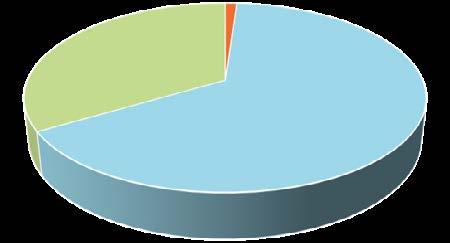












Monthly export tracker
The value of packaged exports decreased by 3 per cent to $1.5 billion and volume decreased by 9 per cent to 216 million litres. Unpackaged wine exports decreased by 6 per cent in value to $488 million and increased by 6.5 per cent in volume to 407 million litres. The average value of unpackaged wine decreased by 12 per cent to $1.20 per litre FOB.
Monthly export tracker
Monthly export tracker
The top five markets by value in the year ended December 2022 were:
• US, down 3 per cent to $390 million
• UK, down 18 per cent to $373 million
• Canada, up 14.5 per cent to $188 million
• Hong Kong, down 13 per cent to $167 million, and
• Singapore, down 20 per cent to $132 million.
EXPORTS BY PRICE POINT AND YEAR ON YEAR CHANGE EXPORTS BY TOP 10 DESTINATIONS AND YEAR ON YEAR CHANGE
EXPORTS BY PRICE POINT AND YEAR ON YEAR CHANGE EXPORTS BY TOP 10 DESTINATIONS AND YEAR ON YEAR CHANGE
EXPORTS BY PRICE POINT AND YEAR ON YEAR CHANGE
EXPORTS BY PRICE POINT AND YEAR ON YEAR CHANGE
EXPORTS BY PRICE POINT AND YEAR ON YEAR CHANGE
COMMENTARY
EXPORTS BY TOP 10 DESTINATIONS AND YEAR ON YEAR CHANGE
EXPORTS BY TOP 10 DESTINATIONS AND YEAR ON YEAR CHANGE
BY TOP 10 DESTINATIONS AND YEAR ON YEAR
The value of Australian wine exports decreased by 4% to $1.9 billion and volume increased by 1% to 623 million litres in the year ended December 2022. Increases in the value of exports to Canada, Thailand, Malaysia and Japan were offset by decreases to the other top 10 destin ations.
The value of packaged exports decreased by 3 per cent to $1.5 billion and volume decreased by 9 per cent to 216 million litre s. Unpackaged wine exports decreased by 6 per cent in value to $488 million and increased by 6.5 per cent in volume to 407 million litres. The average v alue of unpackaged wine decreased by 12 per cent to $1.20 per litre FOB.
The top five markets by value in the year ended December 2022 were:
•US, down 3 per cent to $390 million
•UK, down 18 per cent to $373 million
•Canada, up 14.5
•Hong Kong, down 13 per cent to $167 million, and
•Singapore, down 20 per cent to $132 million.
Source: Wine Australia
COMMENTARY
COMMENTARY
The value of Australian wine exports decreased by 4% to $1.9 billion and volume increased by 1% to 623 million litres in the year ended December 2022. Increases in the value of exports to Canada, Thailand, Malaysia and Japan were offset by decreases to the other top 10 destin ations.
The value of Australian wine exports decreased by 4% to $1.9 billion and volume increased by 1% to 623 million litres in the year ended December 2022. Increases in the value of exports to Canada, Thailand, Malaysia and Japan were offset by decreases to the other top 10 destin ations.
year ended December
Wine Australia providing insights on Australian Wine
$0.0 $0.4 $0.8 $1.2 $1.6 $2.0 $2.4 $2.8 $3.2 $3.6 $4.0 0 100 200 300 400 500 600 700 800 900 Jan-2019 Apr-2019 Jul-2019 Oct-2019 Jan-2020 Apr-2020 Jul-2020 Oct-2020 Jan-2021 Apr-2021 Jul-2021 Oct-2021 Jan-2022 Apr-2022 Jul-2022 Oct-2022 $A (BILLIONS) LITRES (MILLIONS) ROLLING ANNUAL (YEAR ENDING)
Export volume Export value 0 5 10 15 20 25 30 35 40 0 1 2 3 4 5 6 7 8 Jul Aug Sep Oct Nov Dec CUMULATIVE EXPORTS (MILLION CASES) MONTHLY EXPORTS (MILLION CASES)
Mth 2021 Mth 2022 Cum 21 Cum 22 ▲ 2.7% to $623 m ▼ 5.9% to $0 m $500 m $1,000 m $10.00 and above $2.49 and under YE December 2021 YE December 2022 ▼ -3.3% ▼ -17.7% ▼ -5.4% $390 m $373 m $51 m $44 m $0 m $100 m $200 m $300 m $400 m $500 m USA South Korea YE December 2021 YE December 2022 Alternative Packaging 1% Bulk Wine 65% Glass Bottle 34% Volume Alternative Packaging 1% Value EXPORTS BY TOP 10 DESTINATIONS AND YEAR ON YEAR CHANGE volume increased by 1% to 623 million litres in the year ended December 2022. were offset by decreases to the other top 10 destin ations. volume decreased by 9 per cent to 216 million litre s. Unpackaged wine exports 0 5 10 15 20 25 30 35 40 0 1 2 3 4 5 6 7 8 Jul Aug Sep Oct Nov Dec CUMULATIVE EXPORTS (MILLION CASES) MONTHLY EXPORTS (MILLION CASES)
Mth 2021 Mth 2022 Cum 21 Cum 22 m ▼ -3.3% ▼ -17.7% ▼ -5.4% $390 m $373 m $44 m $0 m $100 m $200 m $300 m $400 m $500 m USA UK Canada HK Singapore NZ Thailand Malaysia Japan South Korea YE December 2021 YE December 2022 Alternative Packaging Volume AUSTRALIAN WINE EXPORTS - year ended December 2022 SHARE OF EXPORTS BY CONTAINER TYPE
COMMENTARY The
Australian wine exports
2022. $0.0 $0.4 $0.8 $1.2 $1.6 $2.0 $2.4 $2.8 $3.2 $3.6 $4.0 0 100 200 300 400 500 600 700 800 900 Jan-2019 Apr-2019 Jul-2019 Oct-2019 Jan-2020 Apr-2020 Jul-2020 Oct-2020 Jan-2021 Apr-2021 Jul-2021 Oct-2021 Jan-2022 Apr-2022 Jul-2022 Oct-2022 $A (BILLIONS) LITRES (MILLIONS) ROLLING ANNUAL (YEAR ENDING) Annual export tracker Export volume Export value 0 1 2 3 4 5 6 7 8 Jul Aug Sep Oct Nov Dec MONTHLY EXPORTS (MILLION CASES) Monthly export tracker Mth 2021 Mth 2022 Cum 21 Cum 22 ▲ 2.7% to $623 m ▼ -11.8% to $531 m 5.9% to $457 m $0 m $500 m $1,000 m $10.00 and above $7.50 to $9.99 $5.00 to $7.49 $2.50 to $4.99 $2.49 and under YE December 2021 YE December 2022 ▼ -3.3% ▲ 14.5% ▼ -12.8% ▼ -20% ▼ -9.5% ▲ 118% ▲ 77.6% ▲ 7.7% ▼ -5.4% $390 m $373 m $188 m $167 m $132 m $95 m $62 m $61 m $51 m $44 m $0 m $100 m $200 m $300 m $400 m USA UK Canada HK Singapore NZ Thailand Malaysia Japan South Korea YE December 2021 YE December 2022 Alternative Packaging 1% Bulk Wine 65% Volume Alternative Packaging 1% Bulk Wine 25% Glass Bottle 74% Value AUSTRALIAN WINE EXPORTS - year ended December 2022 EXPORTS BY CONTAINER TYPE BY PRICE POINT AND YEAR ON YEAR CHANGE EXPORTS BY TOP 10 DESTINATIONS AND YEAR ON YEAR CHANGE COMMENTARY of Australian wine exports decreased by 4% to $1.9 billion and volume increased by 1% to 623 million litres in the year ended December 2022. $0.0 $0.4 $0.8 $1.2 $1.6 $2.0 $2.4 $2.8 $3.2 $3.6 $4.0 Apr-2019 Jul-2019 Oct-2019 Jan-2020 Apr-2020 Jul-2020 Oct-2020 Jan-2021 Apr-2021 Jul-2021 Oct-2021 Jan-2022 Apr-2022 Jul-2022 Oct-2022 $A (BILLIONS) ROLLING ANNUAL (YEAR ENDING)
EXPORTS
value of
decreased by 4% to $1.9 billion and volume increased by 1% to 623 million litres in the
Export volume Export value 0 5 10 15 20 25 30 35 40 0 1 2 3 4 5 6 7 8 Jul Aug Sep Oct Nov Dec CUMULATIVE EXPORTS (MILLION CASES) MONTHLY EXPORTS (MILLION CASES)
Mth 2021 Mth 2022 Cum 21 Cum 22 ▲ 2.7% to $623 m ▲ 5.9% to $120 m ▼ -1.7% to $214 m $0 m $500 m $1,000 m above $9.99 $7.49 $4.99 under YE December 2021 YE December 2022 ▼ -3.3% ▼ -17.7% ▲ 14.5% ▼ -12.8% ▼ -20% ▼ -9.5% ▲ 118% ▲ 77.6% ▲ 7.7% ▼ -5.4% $390 m $373 m $188 m $167 m $132 m $95 m $62 m $61 m $51 m $44 m $0 m $100 m $200 m $300 m $400 m $500 m USA UK Canada HK Singapore NZ Thailand Malaysia Japan South Korea YE December 2021 YE December 2022 Alternative Packaging 1% Bulk Wine 65% Glass Bottle 34% Volume Alternative Packaging 1% Bulk Wine 25% Glass Bottle 74% Value
$0.0 $0.4 $0.8 $1.2 $1.6 $2.0 $2.4 $2.8 $3.2 $3.6 $4.0 0 100 200 300 400 500 600 700 800 900 Jan-2019 Apr-2019 Jul-2019 Oct-2019 Jan-2020 Apr-2020 Jul-2020 Oct-2020 Jan-2021 Apr-2021 Jul-2021 Oct-2021 Jan-2022 Apr-2022 Jul-2022 Oct-2022 $A (BILLIONS) LITRES (MILLIONS) ROLLING ANNUAL (YEAR ENDING)
Export volume Export value 0 5 10 15 20 25 30 35 40 0 1 2 3 4 5 6 7 8 Jul Aug Sep Oct Nov Dec CUMULATIVE EXPORTS (MILLION CASES) MONTHLY EXPORTS (MILLION CASES)
Mth 2021 Mth 2022 Cum 21 Cum 22 ▲ 2.7% to $623 m ▲ 5.9% to $120 m ▼ -1.7% to $214 m ▼ -11.8% to $531 m ▼ -5.9% to $457 m $0 m $500 m $1,000 m $10.00 and above $7.50 to $9.99 $5.00 to $7.49 $2.50 to $4.99 $2.49 and under YE December 2021 YE December 2022 ▼ -3.3% ▼ -17.7% ▲ 14.5% ▼ -12.8% ▼ -20% ▼ -9.5% ▲ 118% ▲ 77.6% ▲ 7.7% ▼ -5.4% $390 m $373 m $188 m $167 m $132 m $95 m $62 m $61 m $51 m $44 m $0 m $100 m $200 m $300 m $400 m $500 m USA UK Canada HK Singapore NZ Thailand Malaysia Japan South Korea YE December 2021 YE December 2022 Alternative Packaging 1% Bulk Wine 65% Glass Bottle 34% Volume Alternative Packaging 1% Bulk Wine 25% Glass Bottle 74% Value
$0.0 $0.4 $0.8 $1.2 $1.6 $2.0 $2.4 $2.8 $3.2 $3.6 $4.0 0 100 200 300 400 500 600 700 800 900 Jan-2019 Apr-2019 Jul-2019 Oct-2019 Jan-2020 Apr-2020 Jul-2020 Oct-2020 Jan-2021 Apr-2021 Jul-2021 Oct-2021 Jan-2022 Apr-2022 Jul-2022 Oct-2022 $A (BILLIONS) LITRES (MILLIONS) ROLLING ANNUAL (YEAR ENDING) Annual export tracker Export volume Export value 0 5 10 15 20 25 30 35 40 0 1 2 3 4 5 6 7 8 Jul Aug Sep Oct Nov Dec CUMULATIVE EXPORTS (MILLION CASES) MONTHLY EXPORTS (MILLION CASES)
Mth 2021 Mth 2022 Cum 21 Cum 22 ▲ 2.7% to $623 m ▲ 5.9% to $120 m ▼ -1.7% to $214 m ▼ -11.8% to $531 m ▼ -5.9% to $457 m $0 m $500 m $1,000 m $10.00 and above $7.50 to $9.99 $5.00 to $7.49 $2.50 to $4.99 $2.49 and under YE December 2021 YE December 2022 ▼ -3.3% ▼ -17.7% ▲ 14.5% ▼ -12.8% ▼ -20% ▼ -9.5% ▲ 118% ▲ 77.6% ▲ 7.7% ▼ -5.4% $390 m $373 m $188 m $167 m $132 m $95 m $62 m $61 m $51 m $44 m $0 m $100 m $200 m $300 m $400 m $500 m USA UK Canada HK Singapore NZ Thailand Malaysia Japan South Korea YE December 2021 YE December 2022 Alternative Packaging 1% Bulk Wine 65% Glass Bottle 34% Volume Alternative Packaging 1% Bulk Wine 25% Glass Bottle 74% Value SHARE OF EXPORTS BY CONTAINER TYPE Commentary
what’s ONLINE
Growing popularity of cans helps drive Orora growth
Sustainable packaging provider Orora has reported its first-half results, with a strong performance delivering increases to sales revenue, up 13.9 per cent to $2.26 billion, EBIT up 7.3% to $165.8m and statutory net profit after tax, up 7.8% to $108.1m. Orora operates in multiple markets and strong earnings growth in North America, and a “robust earnings performance” in Australasia helping the company to this strong result. Source: The Shout

NZ vineyards devastated by Cyclone Gabrielle
Vineyards in the key growing regions of Hawke’s Bay and Gisborne have been devastated by flooding caused by Cyclone Gabrielle. NZ Prime Minister Chris Hipkins said: “The severity and the damage that we are seeing has not been experienced in a generation.” It is only the third time a national state of emergency has been declared in New Zealand. Many vines were completely submerged during the cyclone, just weeks before the start of the grape harvest. Source: Drinks Digest
Trials cloning Margaret River
Cabernet Sauvignon
A south west WA winery has cloned one of Margaret River’s most famous red wine varietals in the name of future-proofing the industry against climate challenges. The industry-funded trial has resulted in 14 different clones of Cabernet Sauvignon being grown on a plot of land in the heart of the renowned wine region. The genetic qualities of the plant were carefully selected from Australian and overseas sources to create the clones, which have been propagated and built as part of the ongoing trial.
Source: ABC News
In this issue
“The problem arises due to the use of infected rootstock cuttings. This is not surprising since probably most rootstock cuttings are grown in Australian source areas with shoots from mother vines sprawled on the ground. This is known to cause infection of the shoots which leads to infected cuttings.”
- Richard Smart, page 32
“As soon as we went to the ultra-filtered water supply, everything seemed to improve. We’ve got a [wine] crossflow filter which started washing itself better. The performance of all our [wine] filtration media improved. Our [wine] filtration costs went down, manual handling went down, the amount of environmental waste we were sending to landfill went down.”
- Adam Eggins, page 47
“Like last year, there is strong demand, particularly for the Chardonnay, Sauvignon Blanc and icon reds. More vineyards in the region are now contracting their fruit for a number of years, reducing the grapes for sale on the bulk market. In 2022 the average price per tonne in Margaret River for Cabernet Sauvignon increased 3% to $1,965 and Shiraz increased 8% to $1,419.”

- Amanda Whiteland, page 74
“We are also drawing on help from our wider friends and colleagues from the wine industry and beyond to help with various elements of the project. This has included sending the unedited manuscript to a handful of trusted industry friends, academics and historians for their feedback.”
- Andrew Caillard MW, page 84

8 Grapegrower & Winemaker www.winetitles.com.au March 2023 – Issue 710 Daily Wine News is a snapshot of wine business, research and marketing content gleaned from local and international wine media sources, with a focus on Australian news and content.
BSI
WISA appoints new executive officer
Wine Industry Suppliers Association Inc. (WISA) have appointed Cameron Hills to the position of executive officer.

Following the recent departure of Shirley Fraser from the role, WISA chair Tim Stead was enthusiastic to see what Hills will bring to the position.
“The Management Committee was sad to see Shirley leave the association after having such an enormous impact on the strategic direction, industry relationships and membership engagement of WISA, but we are ready to welcome Cameron and the breadth of experience he will bring to the role,” Stead said.
“Cameron is an experienced EO in the wine industry and beyond. His background is well suited to the role, but equally, his experience outside of the wine industry will bring new ideas and help shape the next era of WISA.”
Hills was most recently employed in a senior role at Royal Agricultural
& Horticultural Society of SA and previously held several executive roles in the wine industry. He has a passion for wine and the people of the wine industry which is evident in his career.
“I am both honoured and excited to have been selected to work with the Wine Industry Suppliers Association,” Hills said.
“The body has demonstrated clear industry leadership and is motivated to build on its progress with a host of future opportunities. I am enthused to be playing a part in the ongoing success of the association and the wine industry.
“I am looking forward to meeting the members of Wine Industry Suppliers Association as well as the affiliated professional organisations that share the association’s values.” Hills was scheduled to commence in the role at WISA on 27 February.
Freshcare Programs for the Wine Industry
We deliver audits that meet the requirements of the Freshcare Australian Wine Industry Standards of Sustainable

March – Issue 710 www.winetitles.com.au Grapegrower & Winemaker 9 news
is a leading food safety certification provider with extensive auditing capacity and the capability to conduct integrated audits for a wide range of food safety standards.
Practice in both Viticulture and Winery that were developed specifically to support the Australian
Industry. Contact us today to begin the Freshcare certification process. W: bsigroup.com/en-au E: info.aus@bsigroup.com P: 1300 730 134 2303_Grapegrower and Winemaker Ad_b.indd 1 3/02/2023 11:25:51 AM
Wine
Cameron Hills
Shaky Bridge Wines names Mike Kush as winemaker and GM
Central Otago based Shaky Bridge has announced Mike Kush as winemaker and general manager to lead the winery and reaffirm its commitment to producing best-in-class Pinot Noir reflecting the best of the region and Alexandra basin.
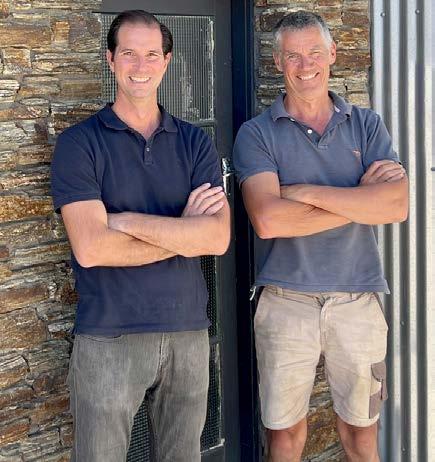
“We are one of the original wineries in Central Otago with my parents Gill and the late Bill Grant planting some of the first vines in the region back in 1973,” said Dave Grant, owner and winemaker at Shaky Bridge.
“Mike, with his range of experiences, passion for the region and commitment to quality, is the perfect person to come on board and lead the winery. He knows the best wines in the world with one foot in the old world and one foot in the new world, and has a vision for where Central Otago and Pinot Noir from the region can go.”
Originally from Chicago in the US, Kush began his winemaking career in Sonoma County and has worked for wineries worldwide, including in New Zealand, Burgundy, Mosel, Argentina, Portugal and South Africa.
He is also the winemaker and owner of Chasing Harvest wines, producing wines in New Zealand and Douro, Portugal.
Kush is a candidate for the Masters of Wine, currently in Stage 2, having passed the four day theory examination and looking to pass the 36-wine blind-tasting practical exam this June. He also teaches Wine Business for Sonoma State University’s Wine Business Institute.
State of UK on-premise sales
On-premise sales have, and continue to be, a reliable resource for wineries to bolster income. The ultimate goal of producers is to find their way on to more menus, meaning more sales.
Wine Business Solutions has released its 2023 study into on-premise sales in the UK as a resource for Australian wine businesses.
The case study is valuable to the Australian industry because around 19% of wine is consumed in the on-premise segment in the UK. Interestingly, 19% is the number in both the US and Australia, when those markets are operating under ‘normal’ conditions demonstrating, perhaps, the extent to which restaurant culture has become globalised.
“We keep hearing that restaurants in the UK are doing it tough. Cost of living pressure is impacting consumer spending. But you wouldn’t necessarily know that given what Brits are spending on wine in the on-premise,” Wine Business Solutions principal Peter McAtamney said.
“According to Wine Business Solutions’ Wine On-Premise UK 2023, the average price of a bottle of wine sold in the UK on-premise is now £44, up 9% and in line with inflation. No real surprise there.”
McAtamney identified rosé and sparkling wine styles as moving trends in the UK, all showing signs of growth throughout the on-premise sector and mirroring trends in Australia and the US. White and red wines both saw price increases to match inflation.
“The average price of a glass of white wine, however, is up by 18% to £8.11 and red is up 19% to £8.36 indicating where the UK on-trade are looking to build back their margins on the back of ‘break out’ style demand,” McAtamney said.
“We saw it in sales figures in off-premise last year and we see it now in UK on-premise listings, Champagne listings are up by 45% on a year ago after having dropped 10% year-on-year to the start of 2022.
“After seemingly having come to the end of its run, rosé listings are up 55% year-
“Although I’ve travelled and worked all over the wine world, I’m here in Central Otago because I believe it can produce truly world-class Pinot Noir,” said Kush. “I’m also very passionate about Alexandra. With its unique soils and being a cooler corner of Central Otago, it
on-year with Provence driving growth.”
Distribution for Australian products in the UK is still in flux, as the country is still the biggest international consumer of Australian wine, however the Australian industry has found a new competitor in what has historically been a very friendly market.
Somewhat mirroring the ‘shop local’ trends in Australia, British origin wines saw a significant increase of on-premise listings in the Wine Business Solutions report.
“One category outshone them all, however, and that was British wine. Listings are up by over 100% year-onyear. This now means that, for the first time, WBS has enough data to make a statistically reliable assessment of British wine as a category,” McAtamney said.
“British sparkling wine is now a bigger category than Cava in the UK on-premise, something that would have been inconceivable a decade ago and which highlights the difference between having a strategy that is driven by value
10 Grapegrower & Winemaker www.winetitles.com.au March 2023 – Issue 710 news
Mike Kush and Dave Grant from Shaky Bridge Winery
Tahbilk honours James Halliday AM with cellar building dedication
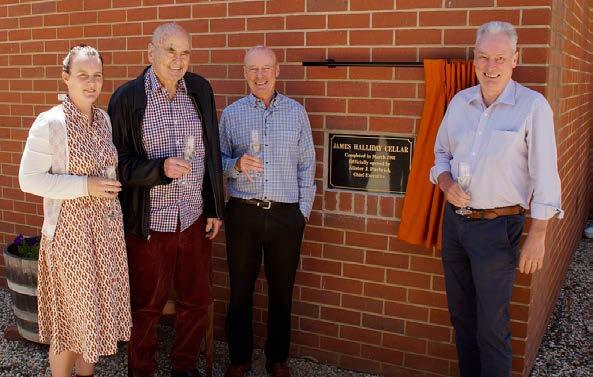
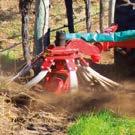
Tahbilk has announced a new member of their Estate ‘family’. Building on a long-held tradition of dedication, fourth generation board member and former CEO, Alister Purbrick, unveiled a cellar on the historic estate dedicated to Australian wine writer James Halliday AM.
A walk around the Estate will reveal many plaques on buildings, honouring longtime, loyal staff members or signifying building openings by Prime Ministers, Federal Ministers and State Premiers. And last month, James Halliday himself was present on the Estate to witness the unveiling of the James Halliday Cellar, in view of family members, staff and colleagues from the wine media fraternity.
“Tahbilk and the Purbrick family have long been friends of mine, and I am humbled by this dedication, even if it suggests I am near the end of my useful life,” Halliday said with his typical self-deprecating and sometimes dark humour.
“My family has agreed that naming one of our buildings after James is so appropriate and a small token of our gratitude for his support of our great
industry, Tahbilk and my family over many years,” Alister Purbrick, who unveiled the plaque with Halliday present, said.

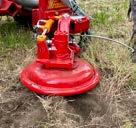
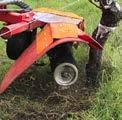
“In keeping with our Estate tradition, we believe that naming a cellar for James provides lasting recognition of his enormous contribution to the wine landscape in Australia and beyond.
“His wine ratings are followed by a global audience of consumers and industry and are an unquestioned measure of wine quality and we look forward to welcoming James back to the Estate to visit any time.”
An Australian wine writer, critic, winemaker, judge and globally recognised authority on all things wine, James Halliday AM is one of the pioneers
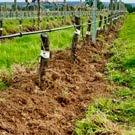
of Australian wine writing, along with his friend and former colleague Len Evans, who had the Estate’s museum named after him during Tahbilk’s 135th anniversary celebrations in 1995.
Since 1979 Halliday has written and co-authored more than 40 books on wine and contributed to international publications including The Oxford Companion to Wine
Creator of the best-selling, annual Halliday Wine Companion and its associated rating system, James’ eponymous website houses over 100,000 tasting notes covering thousands of wineries and has become by far Australia’s most comprehensive wine resource.
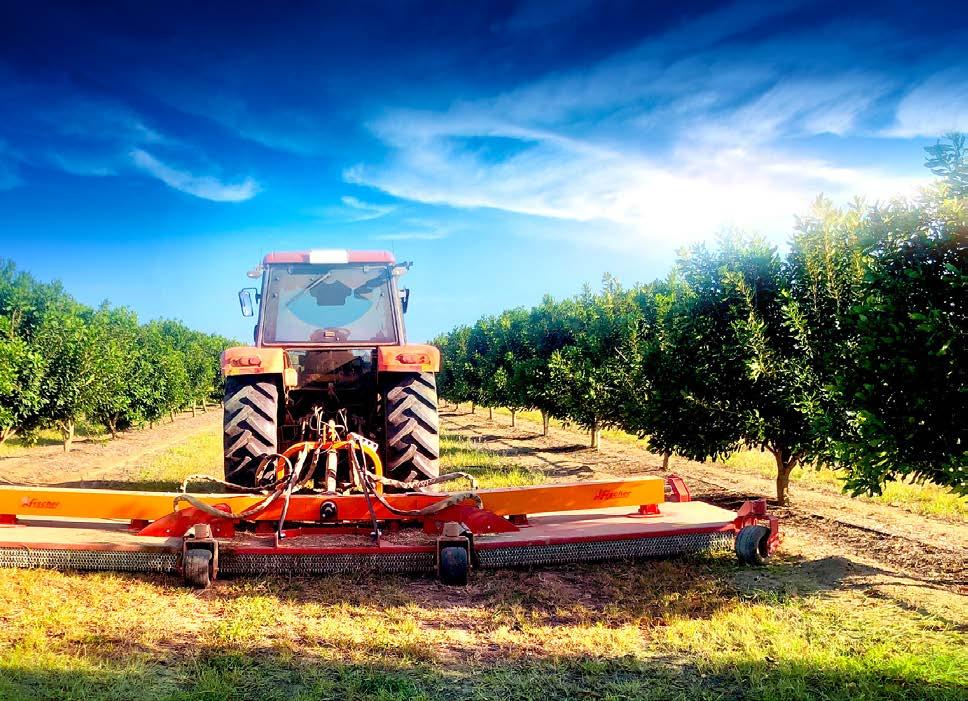
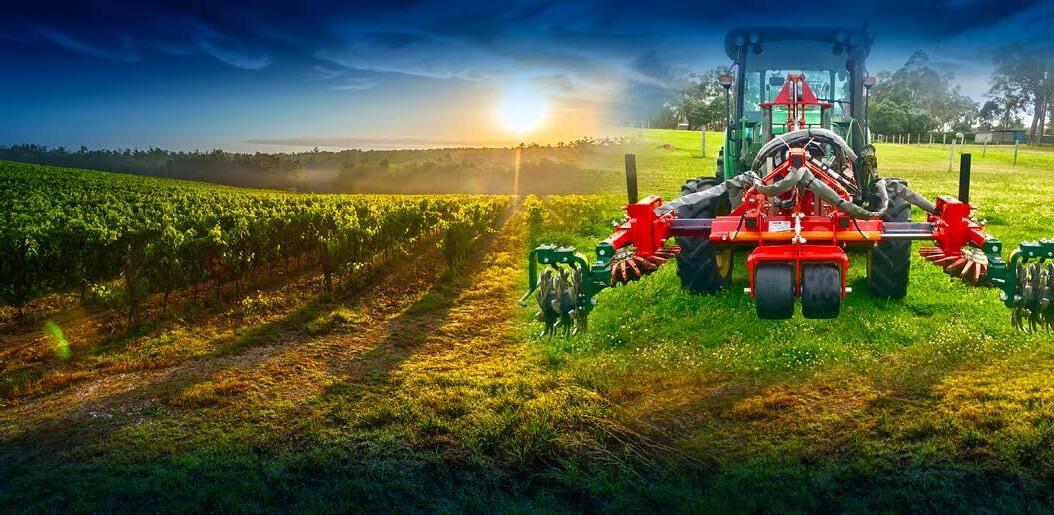
Grapegrower & Winemaker 11 MEET THE
WEEDING
& NEW FISCHER TORNADO Fischer FKT-420 RSO CANE RAKE sales@fischeraustralis.com.au FITS 12 UNIQUE UNDERVINE MANAGEMENT DEVICES
FISCHER FLEX1 FLEX2
SYSTEM
(LR) Hayley Purbrick, James Halliday AM, Alister Purbrick and Mark Purbrick.
Portuguese winemakers call for urgent action over bottle prices

Wine producers in Portugal are calling for urgent action from the government over the rapidly soaring cost of glass bottles, reported the Drinks Business. The National Association of Traders and Exporters of Wines and Spirits (ANCEVE) has asked government officials for “urgent intervention” over escalating glass bottle prices, which according to local reports, are “dramatically” damaging the Portuguese winemaking industry.
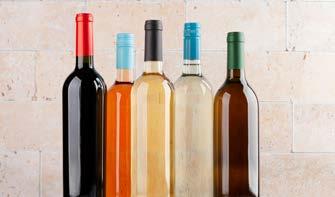
France’s Agriculture Minister reveals support plan for wine industry
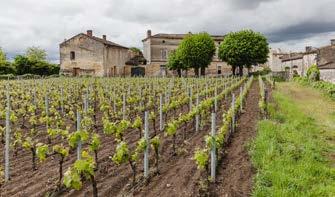
Vitisphere reported that a meeting eagerly awaited by the entire French wine industry took place last month with Agriculture Minister Marc Fesneau. Although there was plenty of talk, it wasn’t just idle talk. The minister confirmed to industry representatives that he agreed to provide funding for short-term distillation measures along with possible funding for structural vine pulls in regions that needed it.
Wildfires in Chile rip through historic vineyards and destroy wineries

Wildfires have destroyed wineries and scorched vineyards in south-central Chile after temperatures reached a record 40°C in mid-February. According to Decanter, more than 20 people died after the wildfires burned down hundreds of homes with three regions – Araucanía, Biobío and Ñuble – declaring a state of emergency. Leoncio Fernández, owner of Leoncio Wines in the Itata Valley, said he was left ‘speechless’ by the destruction to his winery. Another producer, Altos del Valle in the Bío Bío Valley, reported that its winery had been completely destroyed.
California crushed 3.35m tons of winegrapes in 2022
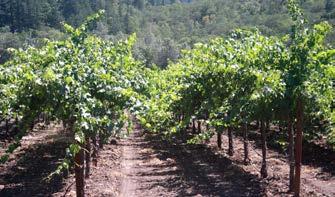
In its preliminary crush report, the California Agricultural Statistics Service says 3.35 million tons of winegrapes were crushed in 2022, down nearly seven per cent compared to 2021 when 3.6 million tons of winegrapes were crushed in California, and around 1.5% less than the total for 2020. It was the third below average California winegrape crop in a row. The 3.35 million ton total is in line with industry expectations and is down slightly from the grape crop forecast of 3.5 million tons that was issued by CASS last August, according to Wine Business
Ireland’s plan for alcohol labels reaches the WTO
Ireland has notified the World Trade Organisation (WTO) of its draft regulations on the labelling of alcoholic beverages. Meininger’s reported that the Assembly of European Winegrowing Regions (AREV) has criticised Ireland’s push for alcohol labelling at a national level and calls for a clear counter-position by the EU. AREV claims that Ireland “is disregarding the EU agreement” by regulating the labelling of alcoholic beverages at a national level and wants to put up warning labels “similar to those on tobacco”.
Japan legalises selfcheckout alcohol sales

Last month, Japanese Minister of Digital Affairs Taro Kono announced that stores would be permitted to sell alcohol and tobacco through self-checkout registers, without a clerk checking the customer’s ID, reported the Drinks Business. Before this new development, if a customer wished to purchase alcohol at a self-checkout in Japan, the store clerk would prompt them to press a button confirming that they are 20-years-old or older (the legal age for the purchase of tobacco or alcohol), they may also have asked to see some form of identification

12 Grapegrower & Winemaker www.winetitles.com.au March 2023 – Issue 710 international briefs
Might alcohol follow tobacco?
 By Richard Smart¹
By Richard Smart¹
Irecently came across modified (2023) guidelines for alcohol consumption in Canada (see www.ccsa.ca). For moderate risk the recommended intake was three to six standard drinks per week, which I found surprisingly low. The guidelines further suggest a low risk for consumption of two drinks a week or less, and increasingly high for seven drinks a week or more. A standard drink is 340ml of beer or a glass of 12% wine, 140 ml. The guidelines were updated from 2011.
Australia has also recently reviewed guidelines in 2020. These are for adults to reduce the risk of harm from alcoholrelated disease: healthy men and women should drink no more than 10 standard drinks a week, and no more than four a day.
I wondered if what is considered as a safe consumption level is now decreasing because of better health statistics and analyses. I further pondered if this tendency may lead to alcohol receiving more government attention, as did tobacco use after health warnings in the 1950s?
Some reactions
Cancer is the leading cause of death in
Canada. However, the fact that alcohol is a carcinogen that can cause at least seven types of cancer is often unknown or overlooked. The most recent available data show that the use of alcohol causes nearly 7,000 cases of cancer deaths each year in Canada, with most cases being breast or colon cancer, followed by cancers of the rectum, mouth and throat, liver, esophagus and larynx. According to the Canadian Cancer Society, drinking less alcohol is among the top 10 behaviours to reduce cancer risk.
The Canadian press (CBC) responded to the recent guidelines announcement, including statements that 25% of drinkers do not know that alcohol can cause cancer. Specialists say that health benefits have been largely debunked but they continue to circulate causing confusion and misunderstanding. The Canadian discussion, as might be expected, involved warning labels on alcohol containers.
Interestingly, in January 2023 the Irish Government declared its intention of warning labels on alcohol containers (“Drinking alcohol causes Liver disease” and “There is a direct link between alcohol and fatal cancers”). Wine is the
second favourite beverage, with those of Chile, Spain and Australia preferred. There have been protests by Italy, Spain and six other EU member states.
In February 2021 the European Commission launched “Europe’s Beating Cancer Plan”, focusing on prevention including alcohol policy solutions. This plan contains a target of 10% reduction in per capita alcohol use by 2025. One measure of the plan involves health warning labelling. In the EU in 2016, cancer was the most common cause of alcohol-related deaths at 29%. Will label health warnings on alcohol become common in Europe? Some argue so.
Conclusion
I have no pretense as to expertise in this area of public health and alcohol. I was however concerned when reading the new Canadian guidelines, and wondering how such guidelines might affect the Australian grape and wine sector in the future. For those interested in the possible tobacco parallel, the history of tobacco use in Australia is interesting reading, see www.tobaccoinaustralia. org.au.
March – Issue 710 www.winetitles.com.au Grapegrower & Winemaker 13 my view
LETTER TO THE
Will alcohol labels follow the example set by tobacco health warnings?
¹Smart Viticulture, Glenroy, Vic. E: vinedoctor@smartvit.com.au
EDITOR
Stressors and facilitators to adoption of sustainable viticulture
A focus on soil health
Suzy Y Rogiers¹, Darren Fahey¹, Maggie Jarrett¹, Matt Adkins¹, and Tintu Baby²
It is impossible to have a healthy and sound society without a proper respect for the soil (P. Maurin)
Our soils are critical for food and fibre production. Soil is not only important for productivity but also provides ecosystem services. Soils hold 25% of our planet’s biodiversity. A healthy soil is able to capture and hold water, to provide an oxygen and nutrient rich environment, to suppress diseases and pests, to neutralise toxins, and to store carbon.
through farming practices. Australian soils are typically low in organic matter and nutrients and are susceptible to erosion.
Soil health is a critical component of the vigneron’s management program. Following careful consideration of genetic material (cultivar, clone and rootstocks) and vineyard architecture at the time of vineyard establishment, the soil health indicators listed in Table 1 can form the basis of an annual vineyard health check, along with canopy and vineyard floor health assessments. Implementing practices that boost soil health is not only good for vines but also good for the surrounding environment, biodiversity, and encourages long-term sustainability for the industry. Appropriate management will reduce the loss of soil through wind or water erosion, slow carbon loss and acidification, improve water infiltration, and reduce the need for pest and weed control.
The soil is composed of physical, chemical and biological properties. There are a number of specific indicators that can provide useful information on the health of a vineyard soil (See Table 1 on page 18). Some of these are attributes of the parent material and difficult to manipulate, while others are malleable
Soil health can be encouraged through appropriate vineyard floor management. The application of mulch undervine can reduce evaporation. However, the chemical composition of mulch and compost will need to be considered to avoid excess levels of potassium and other inorganic elements. The predicted increase in severe temperatures and heatwaves will have a significant influence on vine functioning and fruit quality directly and indirectly through soil and sward/cover crop influences. Allowing volunteer species to grow across the mid-row or planting a cover crop can improve organic matter. Establishing a year-around groundcover both undervine and mid-row can reduce synthetically derived inputs. However, groundcover height will need to be considered to alleviate competition and for disease management. Sheep may be used
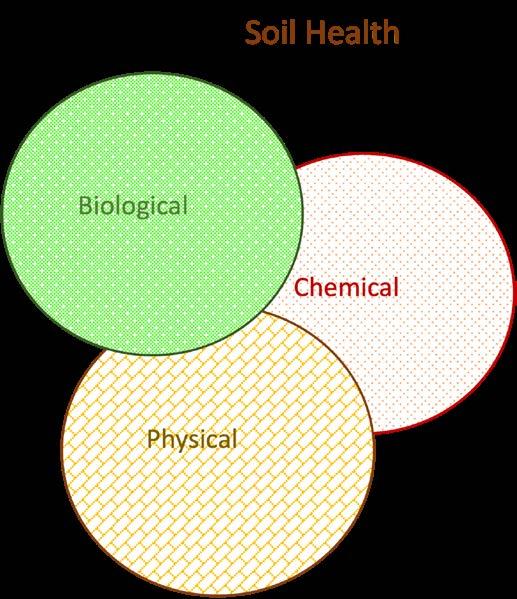
14 Grapegrower & Winemaker www.winetitles.com.au March 2023 – Issue 710 grapegrowing
Fertilisers & Soil Health Sustainability
¹NSW Department of Primary Industries, Orange, NSW ²Gulbali Institute, Charles Sturt University, Wagga Wagga, NSW
Appropriate management will reduce the loss of soil through wind or water erosion, slow carbon loss and acidification, improve water infiltration, and reduce the need for pest and weed control.
to manage these areas during dormancy and even longer periods into the season. In dry regions, this mid-row area can be mown to alleviate competition for water. During wet years, a groundcover will reduce water erosion and the degradation of the surrounding water
quality. High species diversity in and around the vineyard will encourage natural predators such as arthropods and insectivorous birds for pests and diseases. Likewise, reducing herbicide use for the control of weeds will improve biodiversity. The rising costs of fertilisers
and their carbon footprint has created additional incentives to select specific floor management strategies.

Soil protection, restoration and maintenance has been a focus for several decades but recently it has become a
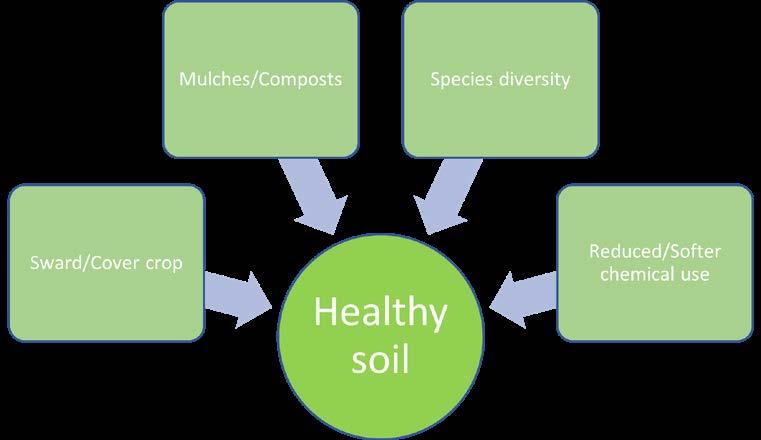
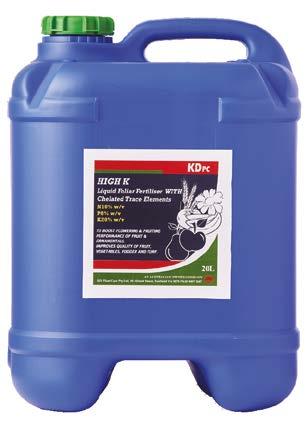
March – Issue 710 www.winetitles.com.au Grapegrower & Winemaker 15 Insecticides, Fungicides, Wetting Agents, Surfactants, Plant Growth Regulators, Herbicides, Disinfectants, Foliar Fertilisers KENDON The Farmer’s Mate Since 1950 Owned by an Aussie Farmer for Aussie Farmers Available at Your Local AG Distributor For chemicals that work, switch to Kendon in the BIG BLUE DRUM.
high potash liquid foliar fertilizer with chelated trace elements.
HIGH K Foliar Fertilizer Boost Your BRIX A
Distributor
Available at Your Local AG
5L,
Pack Sizes: 500ml, 1L,
20L, 200L, 1000L
topic of national significance. How can we encourage the adoption of some of these sustainable solutions so that our healthy soils continue to contribute to productivity, environmental sustainability and economic growth? The likelihood of practice change is dependent on the balance between stressors and facilitators.
Stressors Facilitators
Long-term viability
Cost
Complexity
Confidence
From an economic standpoint, practice change is more likely if financial viability can be assured through increased yield and quality, and/or lower costs of production, and/or increased premiums. None of these factors are guaranteed. The application of sustainable practices
Environmental & social governance
Policies and incentives
Knowledgecapabilityand
can be costly in the short-term, with a lag-time in reaping the on-farm benefits. Nonetheless, it is expected that longterm, quality should increase, and yield should stabilise and be more resilient to environmental stressors such as extreme weather events. A recent survey by our group found that long-term viability was
one major motivator for practice change. A second motivator was ‘doing the right thing’. However responsible agriculture is highly context dependent. Current farm finances, time commitment and skills can outweigh these motivators. While most growers want to protect and improve their soils, the stressors of their immediate situation can tip the balance in favour of the status quo.
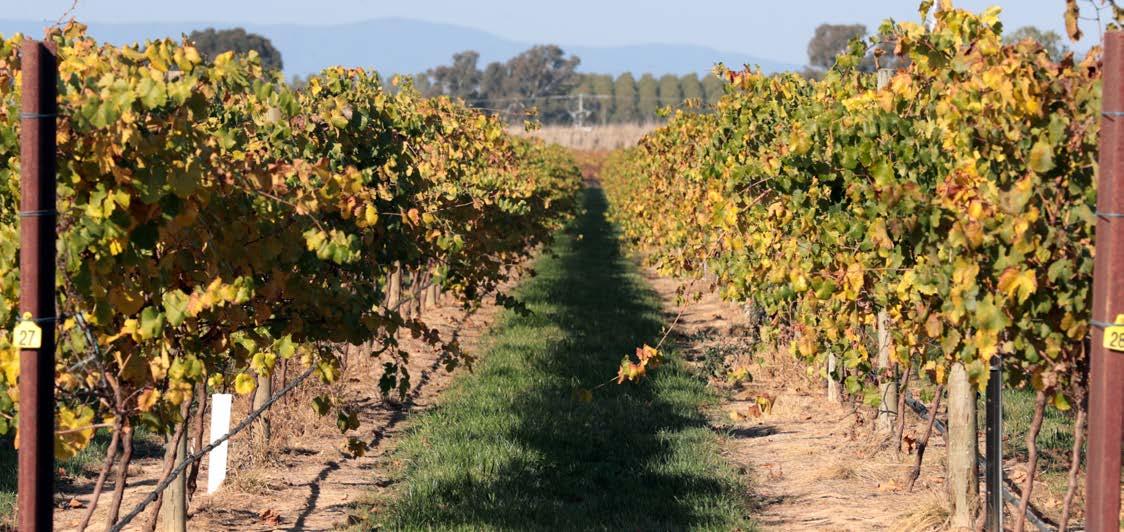
Programs and incentives
In view of this, government programs and incentives may be required to facilitate and promote change. The NSW Government is developing a Sustainable Farming Program to improve both natural assets and agricultural productivity. Farmers can opt-in to an accreditation program to improve biodiversity and soil carbon whilst maintaining productivity. Certification may open markets relating to economic, environmental and social (ESG) values. Likewise, Sustainable Winegrowing Australia (SWA) is aimed at moving individuals and industry to a certification to demonstrate better practice and continual improvement in sustainability. Market access is a strong driver for change. The perception of our wine industry’s dedication to
16 Grapegrower & Winemaker www.winetitles.com.au March 2023 – Issue 710
grapegrowing
The predicted increase in severe temperatures and heatwaves will have a significant influence on vine functioning and fruit quality directly and indirectly through soil and sward/cover crop influences.
Extend your roots well beyond their natural range with EndoPrime® . With high performing mycorrhizae strains and a bio stimulant included, EndoPrime vastly increases the foraging ability of your roots while boosting crop productivity.
Goes where roots can’t.
KEY AREAS ENDOPRIME HAS BEEN SHOWN TO IMPACT:
• Crop yield
• Root and shoot biomass
• N, P, K and trace element uptake
• Water uptake during moisture stress
• Improved soil structure
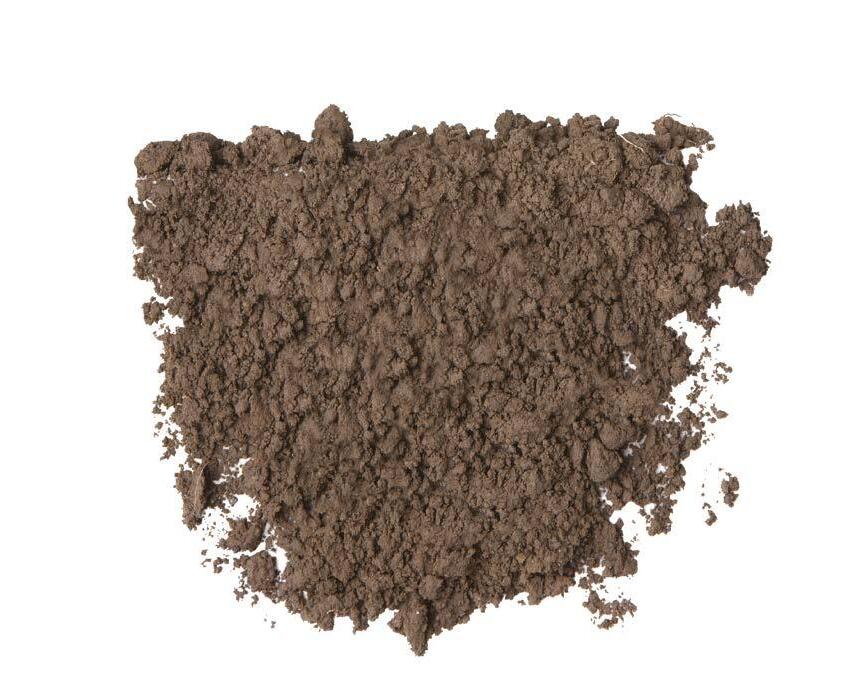
• Plant performance in variable soil environments
• Soil health
• Australian Organic Certified
• Compatible with drip irrigation systems
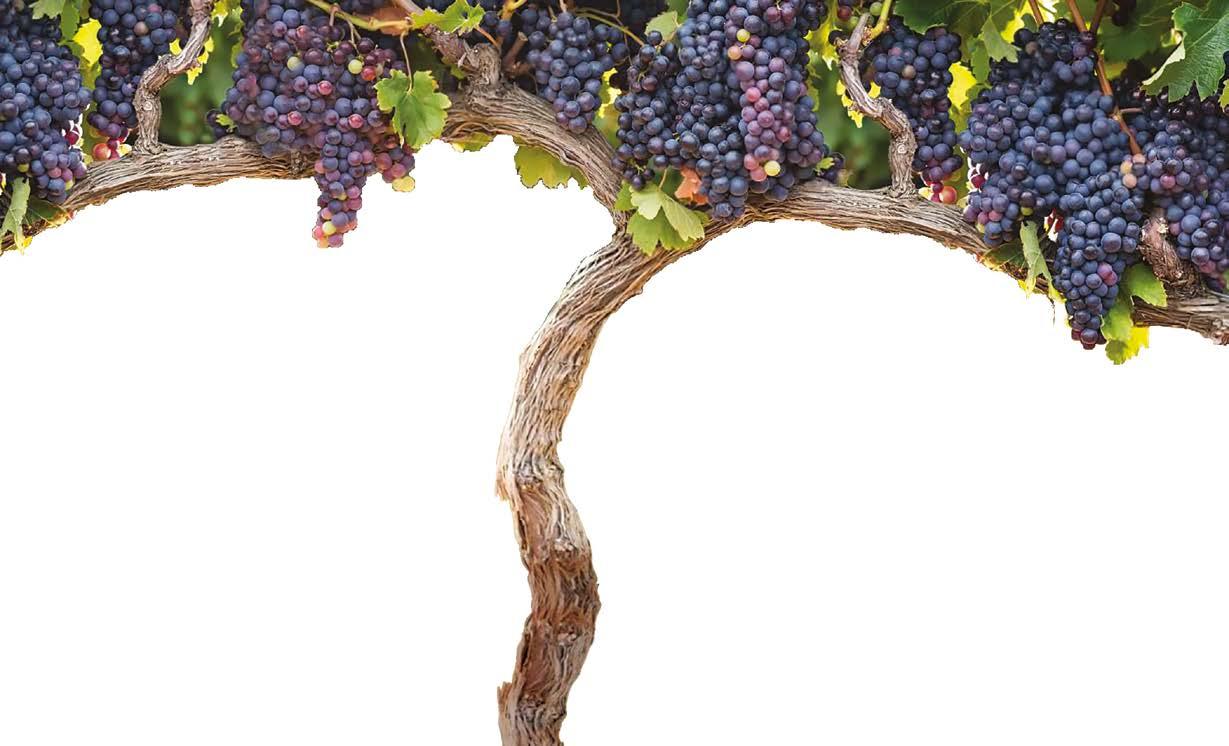
www.sumitomo-chem.com.au ® EndoPrime is the registered trademark of Sumitomo Chemical Australia.
Table 1: Indicators for Vineyard Soil Health
BIOLOGICAL
Soil organic matter (SOM) - The benefits of SOM are numerous. It is suggested that once organic matter has been addressed the other indicators listed below are more likely to fall into place. For instance, SOM facilitates root growth through lowered bulk density and thus vines are more likely to find new sources of nutrients.
Soil biological quantity and diversity - Soils contain an array of insects, worms and microorganisms. Microbes are the powerhouse of biological processes in the soil and release nutrients from crop residues
Pests and diseases under control.
CHEMICAL
Nutrients - Grapevines, like all plants, require adequate quantities of the essential nutrients to achieve their full potential. Nutrients in deficient or excess quantities can be harmful to growth and development.
pH - The soil’s pH is a measure of the hydrogen ions in the soil solution and influences the availability of nutrients. Soils with a pH less than 5.5 (5.0 CaCl2) can be detrimental to nutrient uptake and may cause aluminium toxicity.
Cation Exchange CapacityCEC is a measure of the negative charges within the soil that can adsorb cations such as Ca2+, Mg2+ and K+. CEC influences soil structure stability and nutrient availability.
Electrical conductivity (EC)High salt stunts plant growth. Salinity can be an issue if irrigation water has a high EC.
Toxins - The application of foliar products may alter the chemistry of the soil once they are washed to the vineyard floor by rain. Some may increase the water repelling nature of the soil.
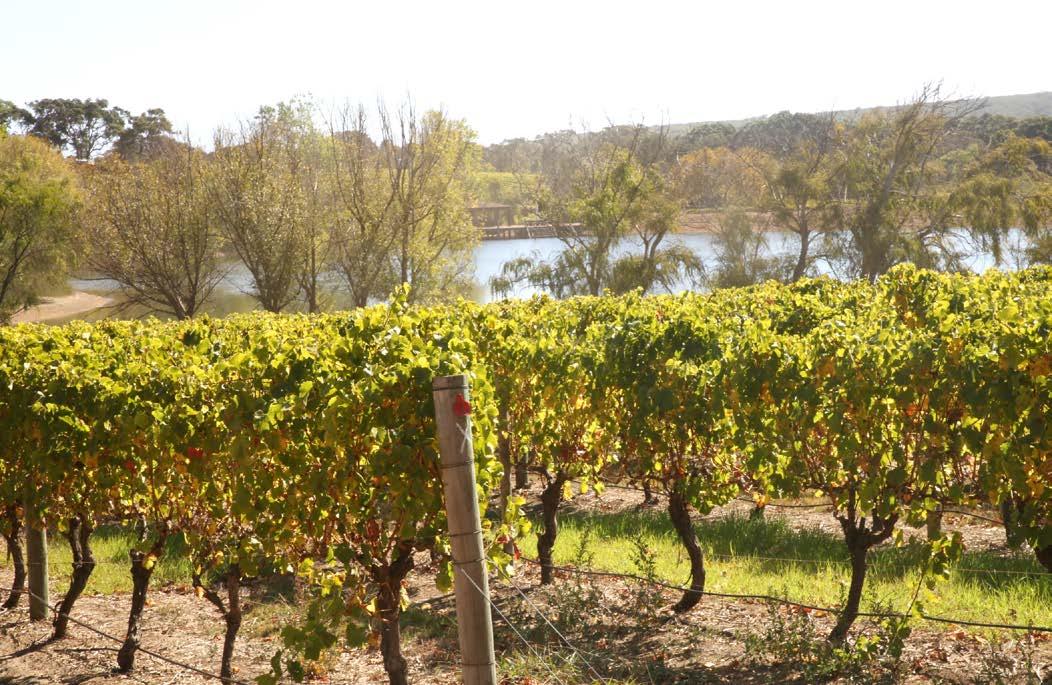
PHYSICAL
Aggregation - the aggregation of soil particles improves soil structure affecting aeration, permeability and nutrient cycling
Porosity - A soil with good porosity allows vine roots to penetrate into new regions and seek out nutrient, oxygen and water sources.
Bulk Density - Soils with high bulk density may deter this root exploration. Subsurface compaction leads to greater bulk denisty
Moisture - Water infiltration, retention and drainage affect soil moisture
18 Grapegrower & Winemaker www.winetitles.com.au March 2023 – Issue 710 grapegrowing
1 1 1 2 3 4 2 3 4 5 2 3
environmental governance by importing countries and their consumers is critical to ensuring markets. New Zealand’s FTA with Europe includes the need for ‘efficient use of natural resources and agricultural inputs, including reducing use and risk of agrichemicals’. Australia has committed to net zero targets and there will be a need to reduce fertiliser use in the coming years. Improving soil health and changing management practices will enable this transition.
Knowledge and capability are two significant barriers to change. Raising stakeholder awareness of the critical role soils play for our ESG wellbeing is a starting point. From a wine industry perspective, building a region-specific knowledge package on how to conserve and improve soil health will increase grower confidence to try new strategies. This can only be achieved through research. The sharing of expertise and knowledge through successful reallife demonstration sites, workshops or online portals and networks will
facilitate information transfer, improve confidence and drive practice change. This is well illustrated in the National EcoVineyards Program which aims to increase the land area dedicated to enhancing functional diversity and to increase the use of cover cops and soil remediation practices. It provides regional-specific options, an online information portal and demonstration vineyards across nine regions.
Soil health is significant to addressing key challenges such as climate change and food security. For the viticulture industry, a healthy soil will support plant resilience, improve productivity and environmental outcomes. The stressors and facilitators to practice change are complex and context dependent, and it is likely that the rate of change will be spread along a spectrum. That said, awareness and willingness to protect our soils will go a long way to encourage the long-term viability of the viticulture industry.
HERBICIDE
THE ORGANIC CHOICE FOR FAST WEED CONTROL
Beloukha is a non-selective, bio-degradable, broad-spectrum, foliar applied herbicide that acts exclusively on contact, attaching and destroying the cell membrane of the plant epidermis causing rapid tissue dehydration.
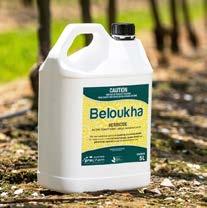
Features
680g/L Nonanoic Acid
Rate: 6 – 8L of product/100L of water
Applied in 200 to 300L of water/Hectare
Fast acting with visible effects on green plant tissue
Derived from natural occurring substances sourced from Sunflowers
Biodegradable
Many use patterns
Extra use patterns
Available in 1L, 5L, 20L, 200L & 1000L packs
Benefits
Highest load Nonanoic Acid on the market
Lower use rates per treated hectare
Rate range to give more flexibility
More treated hectares per spray vat
Less time wasted filling spray tank with water
Lower rates of product per hectare
Most weeds show effects within hours of applications
Derived from plants to kill weeds
Breaks down into carbon dioxide and water
Orchards
Paths, driveways, around sheds, gardens, amenity horticulture areas, protected cropping situations, around nursery stock
Spot spraying in lawns and turf
A pack size for every situation
For more information please call: 1800 777 068 or email: info@grochem.com.au grochem.com
March – Issue 710 www.winetitles.com.au Grapegrower & Winemaker 19
While most growers want to protect and improve their soils, the stressors of their immediate situation can tip the balance in favour of the status quo.
®
Understanding, measuring and ameliorating soil compaction in vineyards
By Tony Proffitt¹ and Lee Haselgrove²
Due to the way that many vineyards have been managed since planting, there is generally some degree of wheel traffic compaction within 0.5-1m of the vines. If we assume that there is minimal root activity past the wheel compaction zone, the potential soil volume available to vines planted at a row spacing of 3m is reduced to about a third. At narrower row spacings where the same wheel base tractors are used, the potential soil volume is reduced even further. Since roots are vital for grapevine growth and production, an inadequate root system, and in particular a lack of feeder roots, could severely limit a vine’s ability to access soil water and nutrient reserves.
Significant work has, and continues to be done, on managing and improving overall soil health in vineyards across the country. However, in recent years there has been an emphasis on soil biology and less on soil physical and chemical constraints to vine growth. One of the main reasons for this is that, as an industry, we know a considerable amount about soil physical and chemical constraints and how they can be managed.
Soil compaction studies in vineyards are not new. In the mid-1990s, Philip Myburgh travelled extensively with researchers and industry leaders to many Australian grape growing regions. The main conclusions (detailed in Mybugh et al. 1996) were as follows:
• Poor vine performance (yield and/ or fruit quality) was associated with restricted root development.
• The restriction to root development was generally caused by hard, dense layers, with the degree of soil hardness (strength) being measured
using a soil penetrometer.
• Root growth was restricted if the soil had a strength/penetration resistance <2 MPa measured at/close to field capacity water content.
As many vineyards in Western Australia are now over 20 years old, it is appropriate to revisit the topic of soil compaction by extending existing knowledge to the upcoming generation of grapegrowers and viticulturists. This was done by measuring soil strength at a number of vineyards and extending the results and associated information at a workshop run by a number of presenters with expertise in soil physics, root physiology and practical experience in ameliorating compacted soils through deep ripping. This article forms the basis of the material presented.
What is soil compaction?
Soil compaction is the process whereby the application of a load results in an increase in bulk density and an associated reduction in air-filled porosity and continuity of pore space as a result of an increase in particle-to-particle contact.
What causes soil compaction to occur?
In vineyards, soil compaction is commonly associated with the load and sliding forces of vehicular traffic and trailers, tillage implements, and animal hooves (where grazing animals are part of the management system). When applied to firm, dry or slightly moist soil, the stresses will generally be resisted by the soil without any significant structural changes. However, when applied to soft, moist and malleable soil, compression and/or smearing often occurs.
The way in which a soil reacts to the application of a load depends on its texture, moisture content, bulk density, and the weight, shape and contact area of the pressure source. Soil particle and aggregate size distribution have a marked influence on the compactability of a soil. For example, the more broadly graded the soil, the more closely it is able to pack because of the ability of the smaller grains to fit in the spaces between larger grains.
Vehicular traffic
Compaction is often found within wheel tracks in the midrow area with the distance between the compaction zone and vine row dependant on row width and vehicle characteristics. Most vineyard tractors have wheels with 1.71.8m centres.
The passage of a wheel across soil is accompanied by a number of processes (Figure 1). In zone A there is a concentration of downward and shearing stresses from the applied load and compaction occurs with an intensity and distribution which is dependent on the applied pressure, the shape of the load, and the distribution of soil strength below the surface. Soil movement without appreciable compaction occurs in zone B. This results in a rise of the soil surface on either side of the wheel rut, with the amount of movement dependent on both the strength and compactability of the soil. The soil immediately under the wheel, zone C, is subject to very high intense shearing action especially when there is severe wheel-slip. As a result, there is a considerable amount of puddling and smearing, resulting in the destruction of soil structure.
grapegrowing 20 Grapegrower & Winemaker www.winetitles.com.au March 2023 – Issue 710
¹AHA
²Mure
Fertilisers & Soil Health
Viticulture, Dunsborough, WA
Viticulture, Dunsborough, WA
Tillage
Compacted layers within the upper 30cm of the soil profile (tillage pans) can be pronounced in the midrow area as a result of regular cultivation/tillage operations.
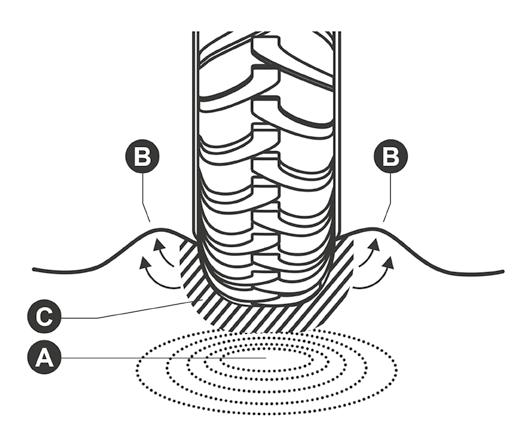
Animals
Animal hooves can exert a load on a soil, with the amount of deformation being dependant on soil texture and density, moisture content, organic matter, and sward strength. When animals walk, only two hooves are generally in contact with the ground at any one time which effectively doubles the applied load.
What problems are associated with soil compaction?
The effect of compaction on a soil is to change its structure, which directly affects its physical properties and indirectly affects both its chemical and biological properties. The reduction in macro-porosity can induce waterlogging, thereby creating soil aeration deficits which can impact on vine growth, as well as reducing infiltration and increasing the risk of erosion. Compaction can also increase the resistance of the soil to root penetration, thereby affecting the vine’s rooting distribution which can have an impact on canopy growth and productivity by limiting access to soil water and nutrient reserves. Passioura and Stirzaker (1993) concluded that when vine roots sense restricted or difficult conditions in the soil, they send signals (the so-called feed-forward response) to the shoots with the aim of slowing growth before the water supply nears depletion.
What is the structure and function of the root system?
Structural roots are 6-10mm in diameter and generally reach a depth of 30cm or more. The smaller permanent roots are 2-6mm in diameter and arise from the structural roots by
Ocloc V repairs broken wooden trellis posts
Quick inexpensive x for broken wooden posts
Keeps existing posts in the ground acting as a secure repair

1/4 the cost of traditional post replacement
Single pass repair
No wire or frost line removal required
No broken posts to graveyard or land ll
Environmentally responsible, low carbon footprint , carbon o set
Galfan or Galvaspan coated high tensile steel
Flexible, strong and durable
Australian made & owned
100% Carbon o set
“The Ocloc repair system is a great low cost strong x for what has been a very, expensive problem, until now.”
- Richard Leask, Leask Agri
“We've been using Ocloc V for a number of years 1/4 the cost of traditional post replacement, a complete 'game changer' & no brainer”
- Darren Sheer Burge Of Barossa.
“As organic growers we have found Ocloc, revolutionary, easy to install, strong and inexpensive"
- Hamish Stevenson Cape Ja a
produc ts are supplied 100% carbon o set
Nigel Cat t 0 418 832 967
nigel@ocloc com au ww w.ocloc.com. au
March – Issue 710 www.winetitles.com.au Grapegrower & Winemaker 21
Figure 1: Diagram showing the principal zones (A, B, C) of soil reaction to the passage of a wheel (adapted from Soane, 1970).
• • • • • • • • • • •
either horizontally (called ‘spreaders’) or downwards (called ‘sinkers’). Branching of these roots produces the fibrous ‘feeder’ roots which are relatively shortlived and are continually being replaced. Feeder roots make up the major portion of the root mass and are predominantly found in the upper 20-50cm of the soil. Each young root has a root tip and proximal to the tip is the ‘zone of elongation’ followed by the ‘zone of absorption’. The latter is about 100mm long, whitish in colour, covered in root hairs and is the zone where much of the soil water and minerals are absorbed. Root length, density, degree of branching and horizontal and vertical distribution is influenced by soil properties, type of irrigation system, cultivation practice and rootstock genotype.
How do you diagnose soil compaction?
There are several quantitative methods of assessing the ‘compaction status’ of a soil. These include the measurement of dry bulk density, porosity, and penetration resistance. The penetrometer is generally considered to be the easiest method for use in vineyards since it is rapid, thereby allowing a large number of readings to be taken to account for site variability. It is simply a device for measuring the force on the end of a shaft inserted into the soil to simulate a growing root (Figure 2). However, penetrometers are sensitive to changes in soil condition and are of limited use in rocky or gravelly soils. It is particularly important to ensure penetrometer measurements are taken at similar soil moisture conditions (preferably at or close to field capacity).

Following the extensive survey of soil conditions in vineyards across southeastern and Western Australia, Myburg et al . (1996) found that poor vine performance could often be traced back to a limited root system caused by soil compaction. Figure 3 is a typical example of their findings.
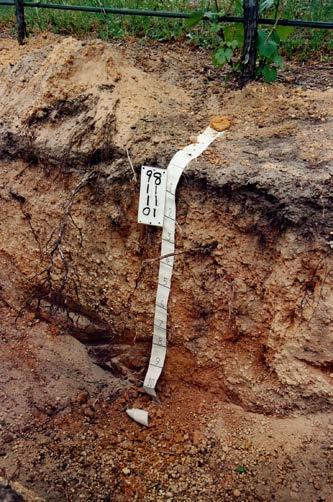
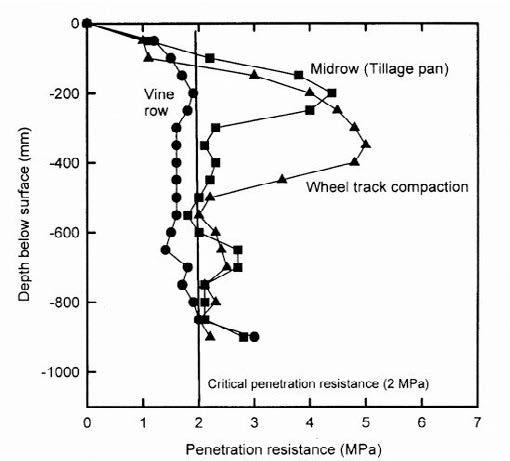
What visual observations can be made?
Visual observations of soil horizons and rooting distribution are useful to confirm penetrometer findings. For example, compaction will often show restricted root growth. In order to make these observations, soil pits should be excavated with one edge about 30cm away from the vine row and the width extending out to the centre of the midrow. They should be at least 1m in depth (Figure 4). Roots on both sides of the soil pit should be carefully exposed to assess the direction, density and depth of growth. Root densities on both sides of the soil pit should be compared and the fine feeder roots checked to determine if they are alive or dead.
22 Grapegrower & Winemaker www.winetitles.com.au March 2023 – Issue 710 grapegrowing
In vineyards, soil compaction is commonly associated with the load and sliding forces of vehicular traffic and trailers, tillage implements, and animal hooves…
Figure 2: Cone penetrometer. The cone on the end of the rod is inserted and pushed into the soil at a steady rate. The applied force is recorded (kPa or MPa) electronically by a data logger, via a strain gauge (photo courtesy of RIMIK).
Figure 3: Penetration resistance in a vineyard showing low (<2 MPa) penetration resistance values within the vine row due to ripping before planting and higher penetration resistance values at 200 mm depth within the midrow where a tillage pan has formed, and at 400 mm depth within the wheel track (Cass et al. 1997).
Figure 4: A sandy gravel clay loam soil profile dug adjacent to a vine row in the Margaret River region. Horizon depths, and the presence/absence of impeding layers and roots should be recorded.
What are the management options to reduce or remove compaction?
Before embarking on a program of amelioration, a grower should be sure that there is a vine performance problem associated with soil compaction. If this situation is confirmed, then there are a number of options.
• Minimise the number of machinery operations that need to be performed, particularly on soils of inherently low strength. Alternating rows in which machinery movement occurs can be a beneficial option.
• Use the lightest machinery with low ground-pressure tyres when performing vineyard operations. This includes towed implements such as fungicide sprayers which in recent years have become very large (e.g. 4000L capacity).
• Use machinery with multiple axles rather than single axles as this will spread the load.
• Restrict compaction to the smallest possible zone within the vineyard block. Take advantage of over-the-row machinery where wheels travel along the middle of the row and GPS guidance systems.
• Restrict vehicle and animal traffic during wet periods when the soil is fragile. The timing of management operations in relation to soil moisture conditions is a critical factor.
• Reduce or eliminate soil tillage within the midrow by using permanent cover crop swards or replacing tillage equipment with rolling equipment.
• Increase the organic matter content of the soil through the use of cover crops, mulch and compost. The greater the organic matter content, the lower the maximum soil bulk density and the higher the optimum moisture content.
• Improve surface drainage through the use of slotted drainage pipes and maintaining vegetative growth in the midrow.
• Consider carrying out amelioration practices such as deep ripping and adding soil amendments to the rip line.
Remedial tillage through deep ripping
The aim of remedial tillage is to stimulate new root growth into parts of the soil that currently do not support roots as a result of physical or chemical restrictions. Deep ripping is the process by which the structure of the subsoil (below 10cm) is fractured, thereby potentially increasing the effective root depth and available soil water storage. Deep ripping also assists in the placement of amendments such as lime, gypsum and compost, as well as improving drainage. It is therefore a management technique that can be used to ameliorate soils which have naturally compacted zones or which have become compacted due to tillage and trafficking. The need for and depth of deep ripping should be based on the presence and depth of impeding layers, and should only be performed at the optimal soil moisture content (i.e. not too wet when the soil could smear as the tine passes and not too dry when the soil could be too powdery and not shatter). There are generally two
The mini greenhouse for vines!
• Pre-assembled and ready to use, NO tools required.
• UV stable long life durable polyethylene, reusable and recyclable at end of life.
• Does NOT split or pop open.
• Translucent for vine inspection.

• Life expectancy 5 years.
• Trains vine straight to the cordon wire.
• For a perfect fit every time, all SnapMax have extra length for ground-wire variation.
For further information: Australia: 03 9555 5500 info@globalgreen.com.au globalgreen.com.au

March – Issue 710 www.winetitles.com.au Grapegrower & Winemaker 23
GENUINE SnapMax SnapMax Vineguards
year when optimum moisture conditions may be met, particularly with clay soils; (i) autumn after sufficient rainfall and preferably before the second flush of root growth which occurs after harvest and (ii) late spring after sufficient drying but preferably not too late so that it coincides with the first flush of root growth around flowering and berry set. Note that deep ripping may not be suitable in established vineyards with shallow soils overlying rock since excessive rock fragments will be brought to the surface. In this case, mounding the vine row might be an alternative strategy to increase soil volume and rooting density.
Recommendations

• The optimal soil water content for deep ripping is when a handful of soil can be remoulded to form a coherent ball that will just crumble when a slight pressure is applied with a finger. This is the so-called ‘plastic limit’.
• The choice of machinery set-up and ripper blade is important. The conventional tool for ripping is the wingless tyne which is often considered to be ineffective in clay subsoils because of its limited capacity to disrupt soil laterally. However, where there is weathered rock and/or cemented layers, it is often the tool of choice. Winged tynes
are preferred where clay is present in the subsoil because they create a larger zone of disruption. However, they have a greater draft and hence a greater tractor power requirement.
• Ideally, two tynes should be used and positioned so that they are in the middle of the compacted zones (e.g. wheel tracks). The rake angle is critical when using winged tynes and should be 20° from horizontal at its working depth (Cass et al. 1998, 2003). Tynes with a greater rake angle will compact the soil adjacent to and below the rip line, while tynes with a lower rake angle will not lift and shatter the subsoil (Cass et al 1998, 2003). It is recommended that the speed of travel while ripping is kept to below 5km/hr (Cass et al 1998, 2003).
• The power of the tractor and/or depth of ripping should be set to minimise wheel slippage in order to prevent further soil structural damage.
• The addition of lime, gypsum and/or compost to ripped soil is likely
24 Grapegrower & Winemaker www.winetitles.com.au March 2023 – Issue 710 grapegrowing
The reduction in macro-porosity can induce waterlogging, thereby creating soil aeration deficits which can impact on vine growth, as well as reducing infiltration and increasing the risk of erosion.
• to prolong the benefits of ripping because the newly-created pores in both the topsoil and subsoil will be more stable with these amendments.

• The long-term benefits of ripping will depend on the nature of the soil as well as post-ripping soil management practices. It is advisable to restrict heavy machinery completely in the first year after ripping, and limit traffic when the soil is very wet in subsequent years. Deep ripping may be required every few years.
Case studies from the Margaret River region
Equipment and methods
Soil penetrometer (RIMIK CP200) readings were taken at three vineyards on the 27 June 2022. The vineyards selected had been deep ripped in different years (2022, 2021 and 2016) which enabled the study to investigate how long the potential soil benefits lasted. Approximately 343 mm of rain had fallen since 1st April and therefore
the soil was considered to be sufficiently wet for a penetrometer to be used. At each vineyard, readings were collected in three non-adjacent unripped rows (the control rows) and three non-adjacent ripped rows (the ameliorated rows) of a block of vines. Measures were made at two different locations within each row, thereby resulting in six replicate sets of penetrometer readings for both the control and ameliorated rows.
At each measurement position, penetrometer readings were made (i) along the vine row (200-300mm from a vine trunk), (ii) within the wheel track (1m in from the centre point between adjacent rows) and (iii) at the centre of the midrow. The penetrometer was set to record at 25mm intervals to a maximum depth of 400mm. Note that it was not possible to reach the full 400mm depth at all measurement locations due to either high soil strength and/or the presence of stones/gravel. Penetration resistance data presented for each depth increment are mean values determined from the available data.
Due to the sensitivity of penetration resistance to soil water content, it was important to record topsoil (1020cm) moisture content at the time measurements were made. Three soil samples were collected from a single panel in each control and ameliorated row. Samples were weighed and ovendried (105°C for 24 hours) in order to determine the mean gravimetric water content (GWC). Additional soil samples were collected on 4 August 2022 after a further 245mm of rain to determine water content and bulk density (BD) values. Mean volumetric water contents (VWC) (expressed as v/v, %) were determined using the following formula:
VWC = GWC x BD (g/cm3) x 100
Rainfall between the two sampling dates brought the soil profile at each vineyard site close to what was considered to be field capacity. The results indicated that at the time penetration resistance readings were made, the topsoil water content was about 77% of field capacity.
INFIELD GRAPE SORTER
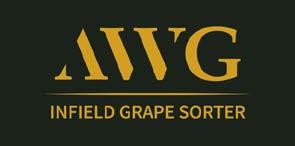
• MOG levels verified from 0.02% (premium) to 0.4% (high volume) Increase winery throughput
MOG0
• No MOG related expenses at the winery
• Increase grape harvest weight
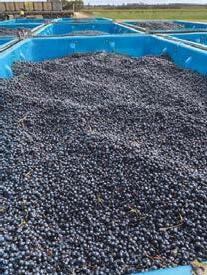
• Decrease juice loss through harvester fans
• Models to suit any grape harvester - any vineyard
• No grape maceration
• No loss of harvesting speed
• Easy to set up, operate and maintain
• 34% reduction in Cineole compound
• up to 10% increase in yield for the grower, with reduced harvester fan speed
March – Issue 710 www.winetitles.com.au Grapegrower & Winemaker 25
aussiewinegroup.com.au Q @aussiewinegroup e: matt@aussiewinegroup.com.au ph: +61 419 959 330
Wine Australia Verified Trial Vintage 22
”
“
The AWG Infield Grape Sorter has been a fantastic investment for Watkins Family Wine - With this technology we no longer need to upgrade to a new harvester, saving the company a huge amount in capital expenses, while also decreasing our overheads costs at the winery
Mark Evans - Vineyard Manager Watkins Family Wine
Ameliorated rows: Ripped in 2022 (the current year) with a Yeomans 3 tyne plough. Tynes were spaced to rip the wheel tracks (1.8m centres) and centre of the midrow to a depth of about 350mm. The mid-row was then powerharrowed and seeded.
Site details and results
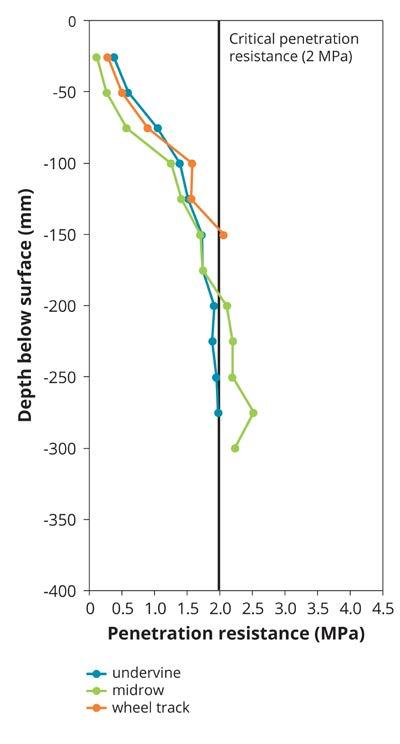
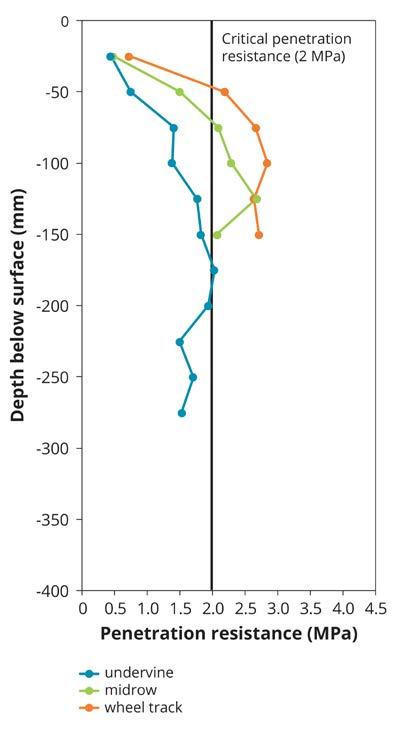
26 Grapegrower & Winemaker www.winetitles.com.au March 2023 – Issue 710 grapegrowing
Figure 5a: Vineyard 1. Control rows showing soil penetration resistance values undervine, within the wheel tracks and at the centre of the midrow. Soil strengths >2 MPa limit vine root growth.
Figure 5b: Vineyard 1. Ameliorated rows showing soil penetration resistance values undervine, within the wheel tracks and at the centre of the midrow. Soil strengths >2 MPa limit vine root growth.
Figure 5a
Block Year planted 1983 Variety Chardonnay Row width (m) 3.6 Soil type Gravel loam
Figure 5b
VINEYARD 1
Deep ripping also assists in the placement of amendments such as lime, gypsum and compost, as well as improving drainage.
Ameliorated block: Ripped in 2021 with an AgSoilworks Vibrosoiler.
There were 2 tynes spaced to rip the wheel tracks (1.8m centres) to a depth of about 500mm.
The midrow was then power-harrowed, seeded and rolled.
VINEYARD 2
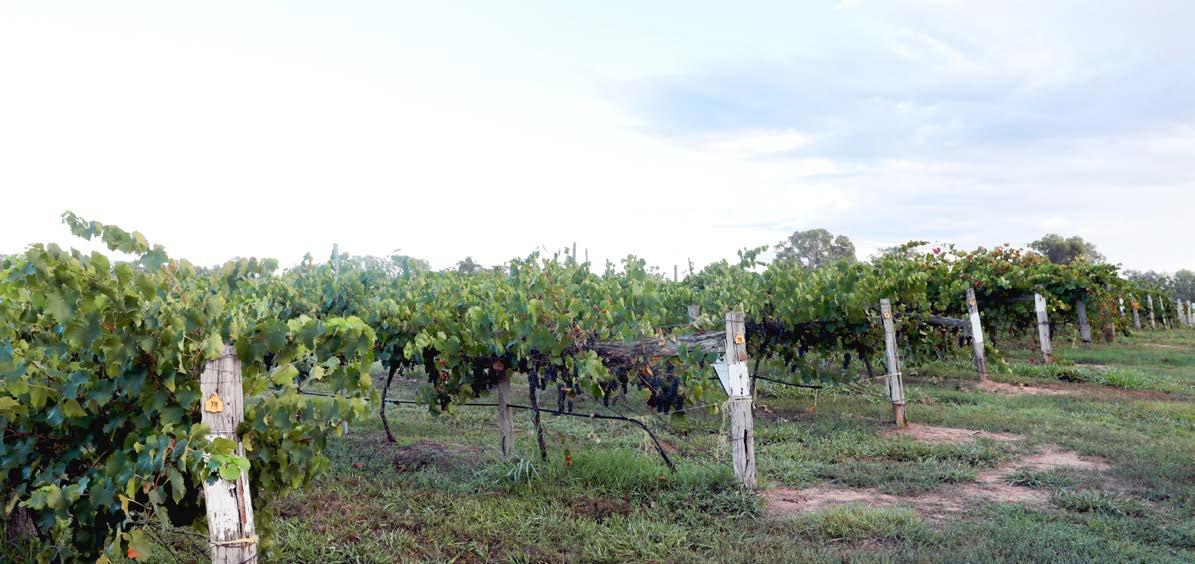
Site details and results
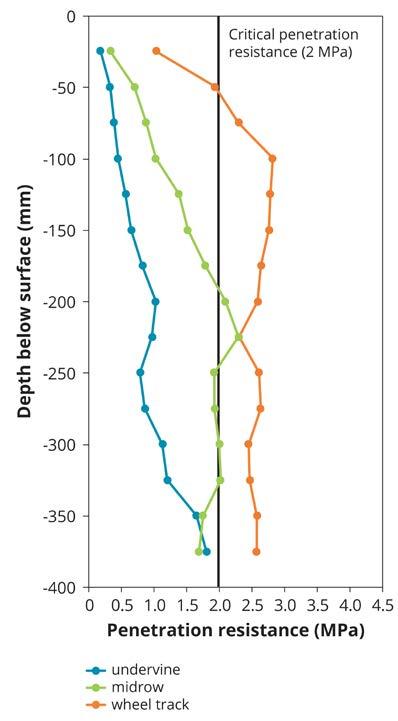
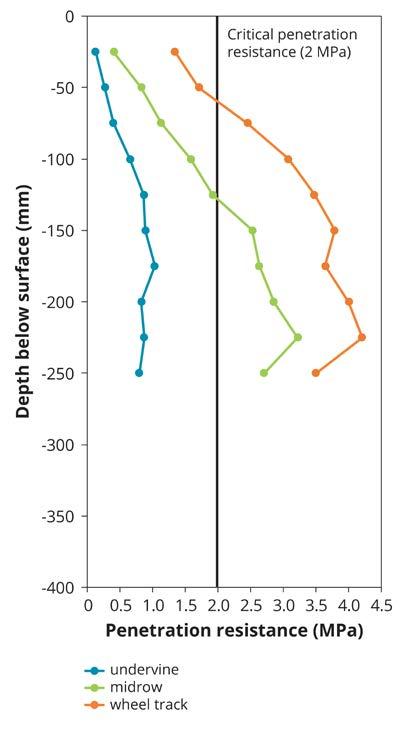
March – Issue 710 www.winetitles.com.au Grapegrower & Winemaker 27
Figure 6a
Figure 6b
Figure 6a: Vineyard 2. Control rows showing soil penetration resistance values undervine, within the wheel tracks and at the centre of the midrow. Soil strengths >2 MPa limit vine root growth.
Block Year planted 2003 Variety Cabernet Franc Row width (m) 3.0 Soil type Clay loam
Figure 6b: Vineyard 2. Ameliorated rows showing soil penetration resistance values undervine, within the wheel tracks and at the centre of the midrow. Soil strengths >2 MPa limit vine root growth.
Ameliorated rows: Ripped in 2016 with an AgSoilworks Vibrosoiler. There were 2 tynes spaced to rip the wheel tracks (1.8m centres to a depth of about 500mm. The midrow was then power-harrowed and seeded. The block was replanted in 2017.
The results are discussed with the acknowledgement that data is incomplete in some cases due to limitations of the penetrometer in gravelly/stony soils. Such soils are characteristic of the Margaret River region.
Within both the control and ameliorated rows at each vineyard, soil strength values undervine were generally ≤2 MPa (Figures 5-7). This suggests that the physical properties of the soil within the vine rows are in good condition, presumably due to continuous vine
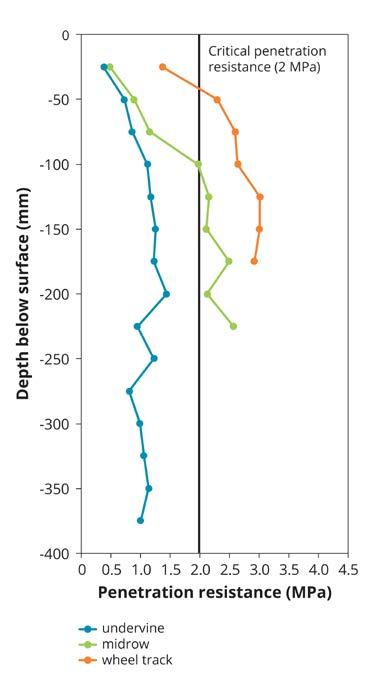
root and soil biological activity since the initial soil preparation and planting operations. In the control rows at each vineyard, the highest soil strength values at all recorded measurement depths were within the wheel tracks, with values >2 MPa being recorded at about 50mm depth and continuing down the profile (Figures 5a-7a). While midrow soil strength in the control rows was consistently lower than that recorded within the wheel tracks, soil strength was consistently higher than that recorded undervine.
The benefits of deep ripping to reduce soil strength can be seen at vineyard 1 which was ameliorated one month before taking soil penetrometer measurements. Soil strength values in the wheel tracks and at the centre of the midrow were reduced so that they were similar to those measured undervine (Figure 5). Note that at vineyard 1, a three-tyne unit was used for ripping while a two-tyne unit for ripping the wheel tracks was used at vineyards 2 and 3.
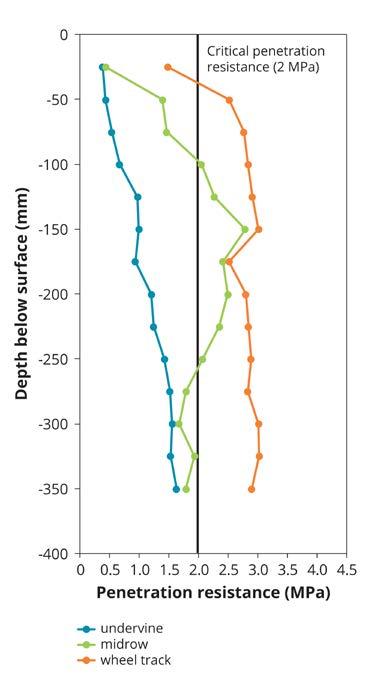
28 Grapegrower & Winemaker www.winetitles.com.au March 2023 – Issue 710 grapegrowing
Figure 7a
Figure 7b
Figure 7a: Vineyard 3. Control rows showing soil penetration resistance values undervine, within the wheel tracks and at the centre of the midrow. Soil strengths >2 MPa limit vine root growth.
Block Replanted Year planted 2010 2017 Variety Cabernet Sauvignon Cabernet Sauvignon Row width (m) 2.0 3.0 Soil type Gravel Loam Gravel Loam
Figure 7b: Vineyard 3. Ameliorated rows showing soil penetration resistance values undervine, within the wheel tracks and at the centre of the midrow. Soil strengths >2 MPa limit vine root growth.
VINEYARD 3
Site details and results
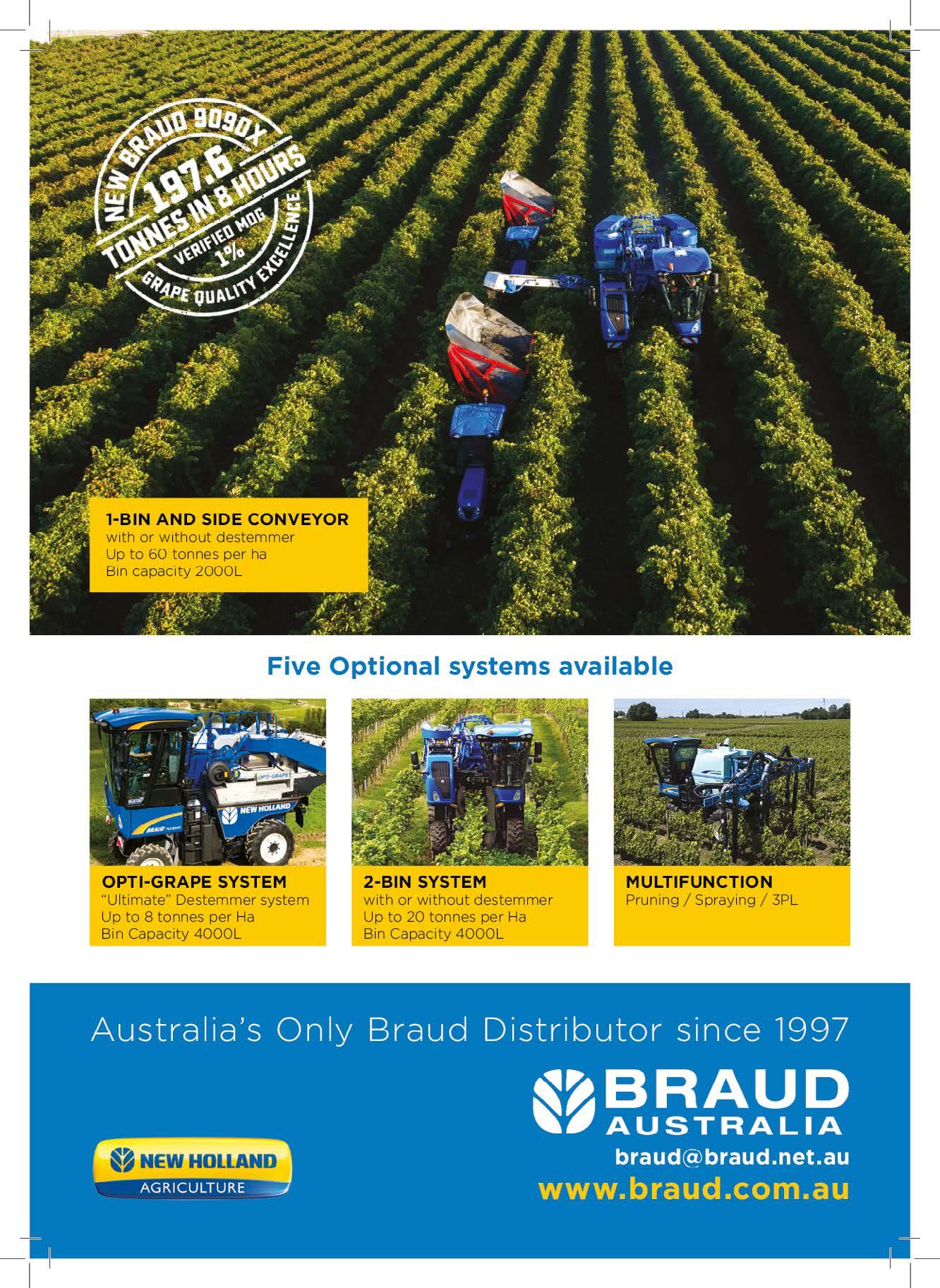
The beneficial effects of ripping wheel tracks in 2021 can still be seen at vineyard 2 where soil strength values below 100mm in the ameliorated rows are consistently lower than those recorded in the control rows (Figure 6). Above 100mm there is little difference in soil strength between the control and ameliorated rows, presumably because of re-compaction and consolidation during the intervening year. It appears that the ripper and/or power harrow had some influence towards the centre of the midrow as soil strength values below 100mm depth are also lower than in the control rows (Figure 6).
At vineyard 3, the beneficial effect of ripping six years ago in 2016, followed by replanting in 2017, is not obvious as soil strength in the wheel tracks is similar in both the control and ameliorated rows (Figure 7). Again, this is likely to be due to re-compaction and consolidation during the intervening years.
Summary
Some degree of wheel traffic compaction within 0.5-1m of the vine row is inevitable in vineyards which are farmed using modern machinery. However, whether this is having a negative impact on vineyard productivity/sustainability needs to be assessed on a site-by-site basis.
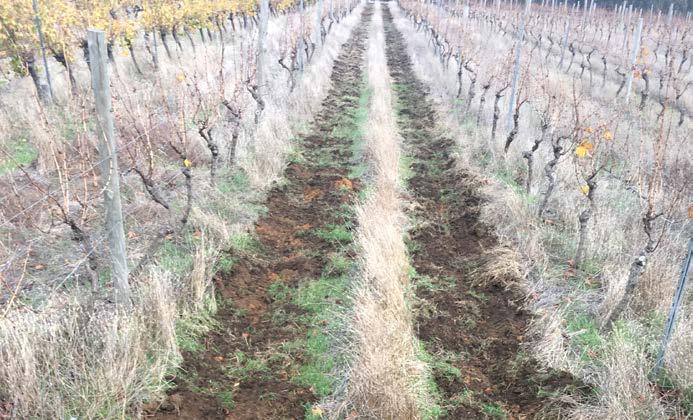
For field investigations, the measurement of soil penetration resistance/strength is often considered to be the easiest method of assessing soil compaction since it is relatively rapid. However, penetrometers are sensitive to changes in soil condition which makes it particularly important
to take measurements at similar moisture conditions (i.e. at or close to field capacity). As demonstrated in this study where data sets are incomplete, penetrometers can be of limited use in rocky or gravelly soils.
The results recorded at the three vineyards in the Margaret River region showed similar patterns to those reported in the literature. If penetration resistance values at a soil moisture content close to field capacity exceed 2 MPa, root density in a lateral direction may be limited. In the case of over-vigorous vines, a limited soil/root volume may be beneficial. However, in most cases where vine growth is not overly vigorous, then restricted access to midrow soil water and nutrient reserves may compromise vine productivity.
Removing compacted layers, particularly at depth, requires special amelioration techniques such as deep ripping because conventional midrow cultivation may not be effective. Cass et al . (2003) provide recommendations on how and when to perform such remedial tillage. Following amelioration, the literature, as well as the data shown for vineyards 2 and 3 in this study, indicate that it is important to minimise the risk of soil being re-compacted as it takes one or more seasons for vine roots to establish themselves in the midrow.
References
Cass, A., Maschmedt, D. and Myburgh, P. (1997). Soil structure - Are there best practices? ASVO Seminar, Viticultural Best Practices. Adelaide.
Cass, A., Maschmedt, D. and Chapman, J.
(1998). Managing physical impediments to root growth. The Australian & New Zealand Grapegrower & Winemaker, June issue. 13-17.
Cass, A., Roberts, D. and Bobbitt, M. (2003). Wing ripping – deep tillage of soil for production of optimum wine quality and environmental sustainability. The Australian & New Zealand Grapegrower & Winemaker, Annual Technical Issue. 473a. 51-59.
Myburgh P., Cass, A. and Clingeleffer, P. (1996). Root systems and soils in Australian vineyards and orchardan assessment. Barossa Valley Rotary Foundation Fellowship Report, CRC for Soil and Land Management, Adelaide. 28 pp.
Passioura, J.B. and Stirzaker, R.J. (1993). Feed forward responses of plants to physically inhospitable soil. International Crop Science 1. 715-719.
Soane, B.D. (1970). The effects of traffic and implements on soil compaction. Proceedings of the Institution of Agricultural Engineers. 25. 115-126.
Acknowledgements
Wine Australia provided funding for the project through their ‘Regional Program’ which is administered by Wines of WA. Richard Fennessy (Department of Primary Industries and Regional Development, DPIRD) managed the project and Yu-Yi Liao (DPIRD) provided technical assistance. DPIRD and the authors wish to thank the managers at the three vineyards for allowing access to their properties.
Disclaimer
While every effort has been taken to ensure the accuracy of this article, the Department of Primary Industries and Regional Development (DPIRD) accepts no liability by reason of negligence or otherwise arising from the use or release of this information or any part of it. In relying on or using any advice or information that has been expressed or implied and contained within this article, the reader accepts all risks and responsibility.
30 Grapegrower & Winemaker www.winetitles.com.au March 2023 – Issue 710 grapegrowing
‘Chelates ain’t chelates’ when feeding plants iron
“Oils ain’t oils”, as we will long recall, and when it comes to supplying iron for plant nutrition according to soil’s pH level, “chelates ain’t chelates’’.
Sheri Robinson, southern agronomist with specialty fertiliser supplier Haifa Australia, said iron was available in a full range of chelates and unless growers were applying the correct chelate for their soil type, they could be wasting their time and money.
She said to take this a step further, when using the EDDHA chelate for iron, “stability ain’t stability’’ and growers needed to check stability components to ensure they maximised plant production benefits and their return on investment in this iron chelate.
“Ortho-ortho is the shape of the EDDHA and is the most stable form in soil, so growers need to check the ortho-ortho percentage of this chelate, rather than just the total iron percentage,’’ Robinson explained.
“Ortho-ortho is the best for keeping the chelate in the soil solution, including in higher pH calcareous soils, so the level of this is more important than the total.
“An EDDHA iron chelate may have a total iron percentage of 6, but it may only have a 4.8% ortho-ortho component, leaving 1.2% as ortho-para or para-para, which are components that are not as strong.”
Ortho-ortho of 4.8% has generally been the highest level available in iron chelates, with many offering levels of 3-4%.
Supplier Haifa Australia has reported that it has released onto the market an EDDHA iron chelate with an orthoortho level of 5.2%.
EDTA chelates are the most cost-effective and widely used, however EDTA iron also is the least stable in soils and should
Haifa quality now in micronutrients
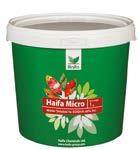
Strong new option for soluble chelates
Haifa, renowned for supplying the highest quality water soluble fertilisers, is now offering the highest quality chelated micronutrients. This includes chelates with the highest stability, such as EDDHA iron with the strongest holding ability. Haifa also can supply specific micronutrient blends compatible with a wide range of fertilisers.

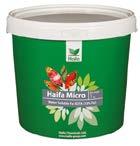
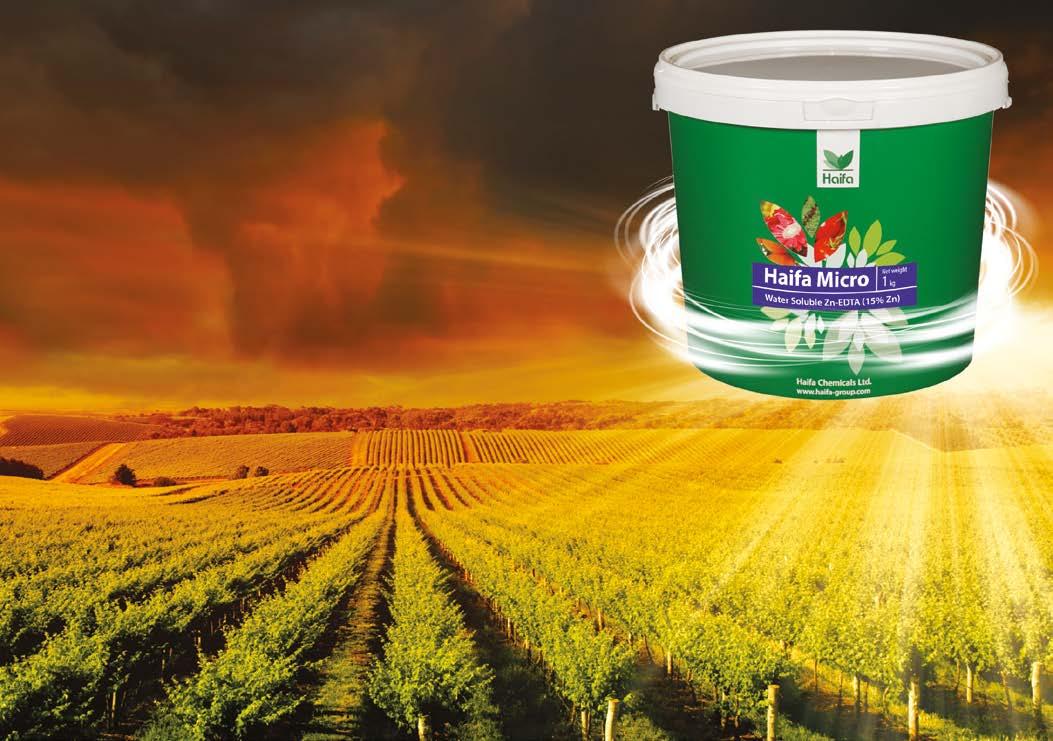
only be used where soil pH is up to 6-6.5. EDDHA iron chelates are suitable for soils up to 9 pH, while other iron chelates include DTPA, suitable for pH soils up to 7, and HBED, suitable for up to 12 pH soils.
“The two-part message for growers is if you are putting out an iron EDTA to soil pH above 6-6.5, you are wasting your money because it becomes bound and precipitates and, therefore, unavailable to plants, so use an EDDHA iron chelate. And look at the ortho-ortho stability component, because the total iron percentage is not relevant,” Robinson said.
“There is widespread potential for growers to improve crop production and quality through better iron use efficiency according to their soil pH.
March – Issue 710 www.winetitles.com.au Grapegrower & Winemaker 31
Choose the correct iron chelate for your soil pH and carefully check its analysis Don’t waste time and money Haifa Australia (03) 9583 4691 australia@haifa-group.com haifa-group.com
Fertilisers & Soil Health
Growers beware of infected grafted vines
By Richard Smart¹
Introduction
Many new vineyards in Australia are now planted on grafted vines. A regrettable issue is that they may be disease infected, leading to problems in the new vineyard. Currently much attention is being paid to virus diseases of both scion and rootstock, as such diseases may regrettably occur in new grafted vines. This attention will increase given the recent announcement of a new and serious virus disease in Australia called “red blotch”.
Another serious disease complex is more commonly found in the rootstock rather than the scion of grafted vines. Grapevine trunk disease is due to several fungi and may cause restricted growth or even death of young vines, and subsequently spread and destroy vines as they age. This article is to do with the issue of trunk diseases; these receive less attention than virus diseases although severe infections can cause older vineyards to become uneconomical, as is happening in Australia and overseas.
Avoiding trunk disease infection
Research in Victoria reported by Edwards (2006) and in NSW (WhitelawWeckert et al . 2013) have confirmed rootstock cuttings used in grafting are contaminated by trunk disease fungi. Similar results are reported overseas by Gramaje and Armengol (2011). Despite this knowledge, Australian grafted vineyards showing trunk disease may be observed, although it is uncommon for growers to be aware of the reasons for variability and young vine deaths, especially involving potted vines. The problem arises due to the use of infected rootstock cuttings. This is not surprising since probably most rootstock
cuttings are grown in Australian source areas with shoots from mother vines sprawled on the ground. This is known to cause infection of the shoots which leads to infected cuttings. A second common problem is that the mother vine trunks become infected with the fungi because the pruning wounds are not protected with a fungicide. Many growers would be aware that this practice is now recommended for their vineyards to avoid infection by Eutypa and other fungi.
Once the mother vine is infected through pruning wounds then the fungi can spread in the vine trunk itself. Overseas studies show us that infected vines develop characteristic
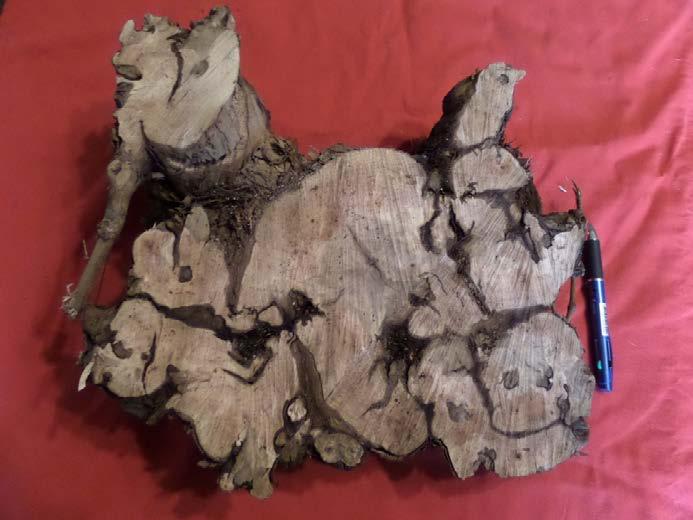
32 Grapegrower & Winemaker www.winetitles.com.au March 2023 – Issue 710 grapegrowing
Figure 1. Sawn cross section of Paulsen 1103 rootstock mother vine, 20 years old, chosen at random and infected with the trunk disease fungus Phaeomoniella which will infect cuttings. Note characteristic staining. Nursery operators should ask rootstock cutting suppliers have they searched for similar symptoms, and made lab tests.
The problem arises due to the use of infected rootstock cuttings. This is not surprising since probably most rootstock cuttings are grown in Australian source areas with shoots from mother vines sprawled on the ground.
¹Smart Viticulture, Glenroy, Victoria. Email: vinedoctor@smartvit.com.au
internal symptoms. I recently had the opportunity to cut open with a chain saw a twenty-year-old Paulsen 1103 rootstock mother vine. The symptoms I saw within were the same as those described for infected vines in Charentes, France, so I arranged to have them tested at a state laboratory. The vines were found to be infected with the fungus Phaeomoniella, known to cause Petri Disease of young vineyards, already described many years ago in Australia in the above studies. Why does this problem persist?
One might well ask how might this situation exist in a modern, science-









driven industry like that of Australian grape and wine? One imagines that the suppliers of rootstock cuttings to the nursery industry have not made similar assessments of their rootstock mother vines, otherwise the vines should had been removed for fear of producing infected cuttings. One hopes that they were not reassured by the knowledge that infection in cuttings does not show until after planting of the grafted vine. However, a new method of testing allows infected cuttings to be determined, so hopefully this situation might change. The nurseryman and the grower currently pay the financial penalty for
sanitation problems in the rootstock mother vines.
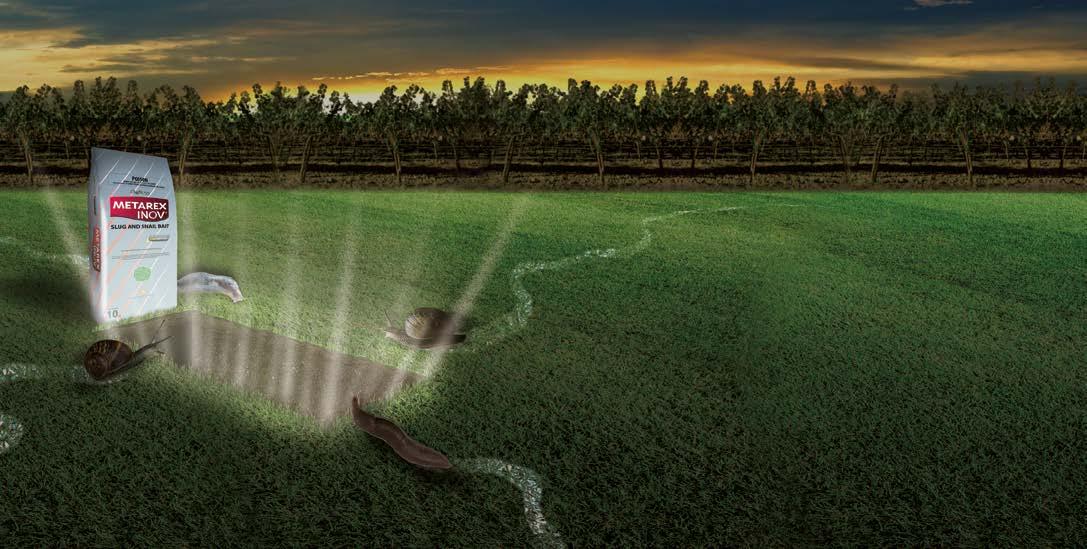
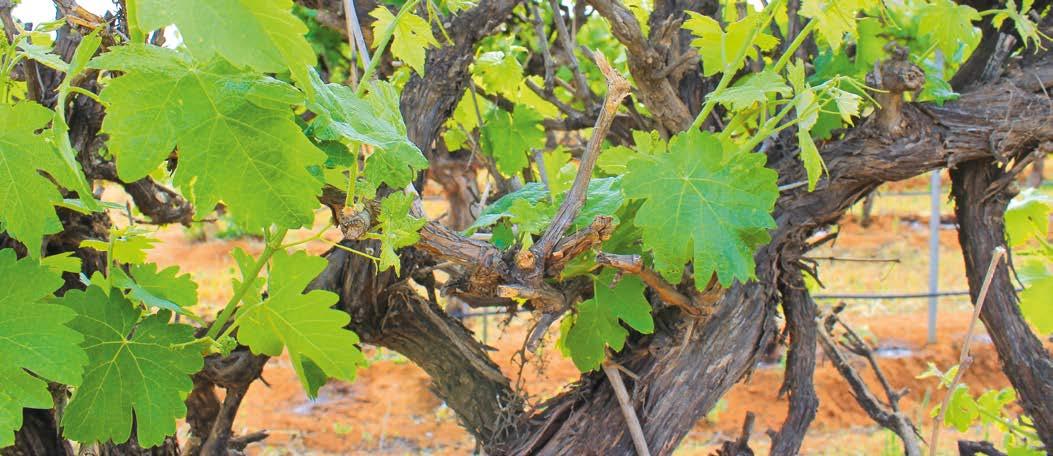
Conclusion: buyers beware!
Nurserymen are encouraged to ask their rootstock cutting suppliers if they checked their mother vines for trunk diseases and had cuttings tested. They might also observe if shoots are grown on the ground and if pruning wounds have been protected. Growers on the other hand might enquire of their nurseryman if the rootstock internal staining on slow growing and dead plants might be trunk disease, or maybe have a laboratory test to seek refunds.

March – Issue 710 www.winetitles.com.au Grapegrower & Winemaker 33
SLUGS &
LOVE
Maximum Attractiveness Enhanced Palatability Faster Efficient Kill Persistent Control
SNAILS
IT TO
Innovation.
METAREX INOV All Weather Slug & Snail Bait is developed from science & nature to provide superior control based on unique technology for enhanced delivery
Quality. Solutions. ®Metarex Inov and Colzactive are registered trademarks of De Sangosse SA. 220808
Fungicide resistance
Effective management practices for healthy vines and budgets
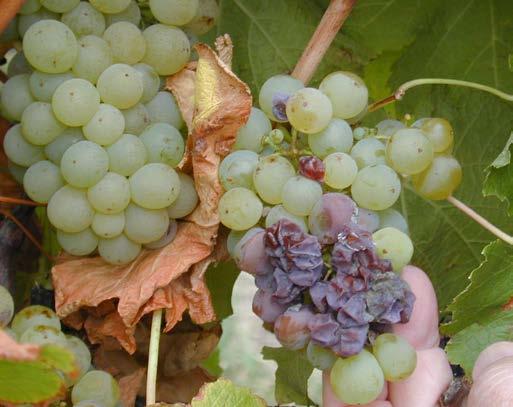
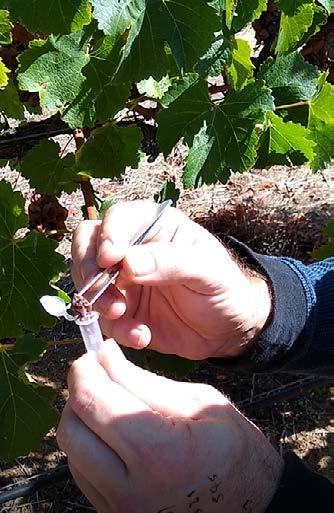
Simone Madden-Grey investigates the potential of new and un-utilised techniques to provide greater efficiencies and cost savings when managing grapevine disease pressures.
Botrytis, powdery mildew and downy mildew cost the wine industry more than $200 million dollars each year according to Wine Australia estimates. Those costs combined with the rising cost of vineyard operations mean a robust fungal management programme is essential to vineyard longevity, both in terms of vine health and financial management.
Tests capable of rapid in-situ testing for fungicide resistance have potential for significant chemical, time and labour savings. Identifying and quantifying site-specific pathogen populations would help growers design a well-informed spray programme that maximises spray efficacy. Chemical inputs may also be reduced by eliminating those sprays that are determined to be less effective as indicated by resistant populations.
Speaking at the Australian Wine Industry Technology Conference 2022 (AWITC), Dr Francisco Lopez-Ruiz, Associate Professor at Curtin University, described the development of one such test as part of a project funded by Wine Australia and led by the South Australian Research and Development Institute (SARDI), the research arm of the Department of Primary Industries and Regions (PIRSA). Laying the groundwork for his presentation, Dr Lopez-Ruiz emphasised the absence of causality in the relationship between fungicide use and resistance. Instead, he said the emergence of resistance was due to the selection of resistant pathogens carrying mutations that already exist in nature.
The aim of the Wine Australia project was to adapt a qPCR (quantitative polymerase
chain reaction) technique in order to detect botrytis fungicide resistance. The technique was originally designed and created by Dr Lopez-Ruiz and the team at Curtin University for the detection of powdery mildew fungicide resistance in wheat. The testing methodology they designed identified and quantified fungal pathogen populations in-situ and provided results within the hour, rather than the standard number of days for laboratory tests. Although the qPCR test itself has been used in a laboratory setting for a number of years, designing a test suitably robust for in-field testing in agriculture was a breakthrough.
The team adapted existing PCR testing methods for in-field testing by designing different chemistry so as to quantify fungi possessing genetic changes that correlated with fungicide resistance.
The PCR test, which in recent years has become familiar to us all, was developed in the 1980s. Small segments of genetic material are amplified, or copied, to amounts sufficient for molecular and genetic analysis. It works by separating the two strands of the DNA helix and replicating them using primers and a polymerase enzyme. Primers are short nucleic acid sequences designed to recognise and bind to the section of DNA that is of interest. A polymerase enzyme then copies the DNA sequence, which results in a DNA helix consisting of one old and one new strand of DNA. In this way DNA can be amplified quickly and to amounts sufficient for analysis. The team at Curtin University developed a particular DNA extraction technique capable of producing DNA in under one minute and at a cost of approximately 2 –3 cents per sample. They also screened a
34 Grapegrower & Winemaker www.winetitles.com.au March 2023 – Issue 710 grapegrowing
The PCR test, which in recent years has become familiar to us all, was developed in the 1980s. Small segments of genetic material are amplified, or copied, to amounts sufficient for molecular and genetic analysis.
Field sample collected. Photo: Lincoln Harper, Centre for Crop and Disease Management, Curtin University
Botrytis effected grapes

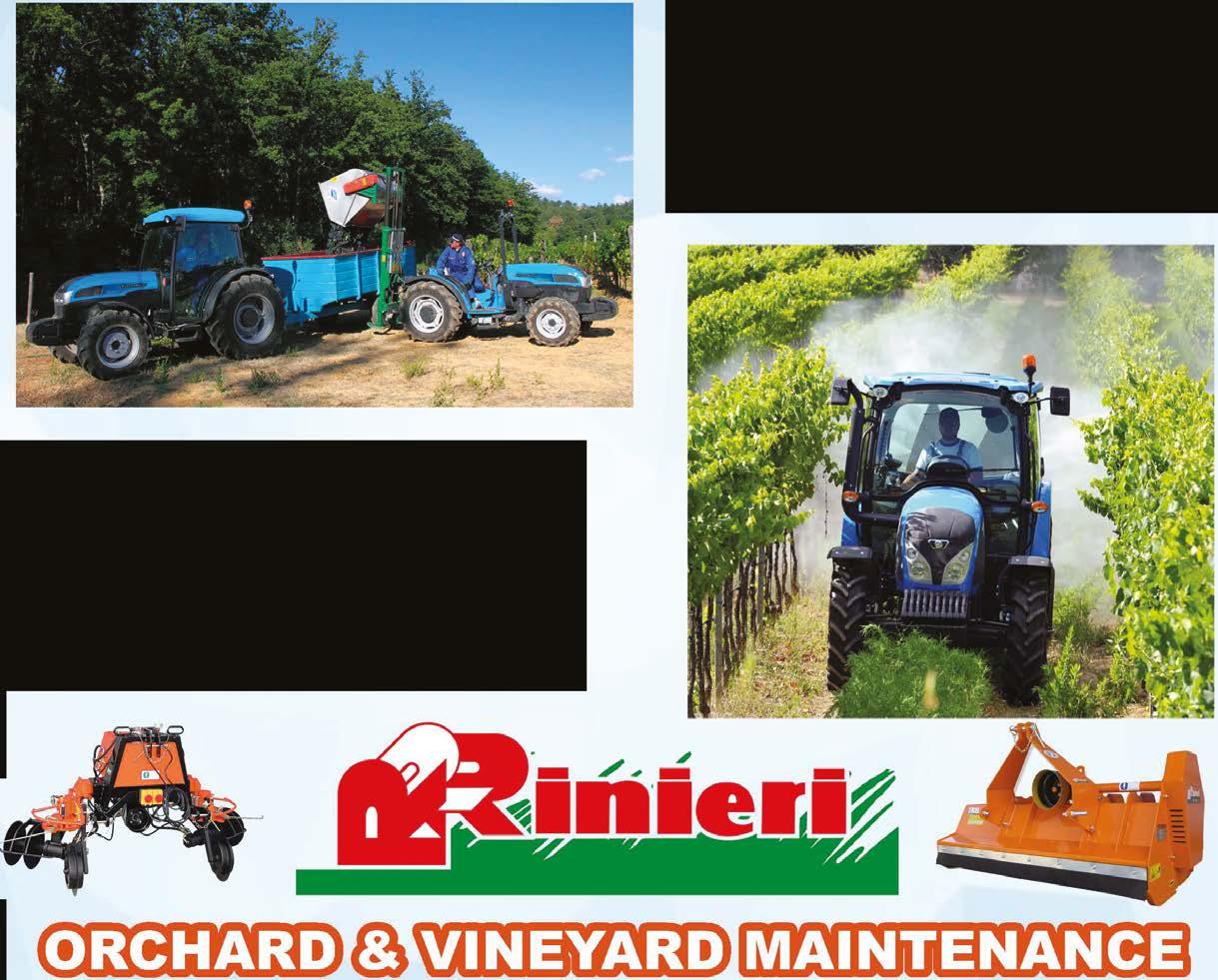


REX SERIES Up to ll2hp, 4.41tr Perkins VINEYARD/ORCHARD SPECIALIST 4 - SERIES Up to 107hp, 3.6 Deutz VINEYARD SPECIALIST GEPPS CROSS 08 8139 7222 www.landinicentral.com.au SUMMERTOWN 08 8390 3017 NARACOORTE 08 8762 0123 admin@landinicentral.com.au
4 - SERIES Up to 107hp, 3.6 Deutz VINEYARD SPECIALIST
ORCHARD & VINEYARD MAINTENANCE
REX SERIES Up to 112hp, 4.4L Perkins VINEYARD
/ ORCHARD SPECIALIST
grapegrowing
range of DNA polymerase enzymes until they found one that could withstand the conditions of in-field testing and provide robust results.
At this stage the in-situ qPCR test functions as a research resource for a variety of crops. The team at Curtin University work with the grower on-site to identify the most useful sites for testing, after which samples are taken and results are analysed on-site within an hour. Dr Lopez-Ruiz says understanding nature will increase efficiency in managing fungal problems and in this way the qPCR test is able emphasise particular points in fungicide management for optimal outcomes.
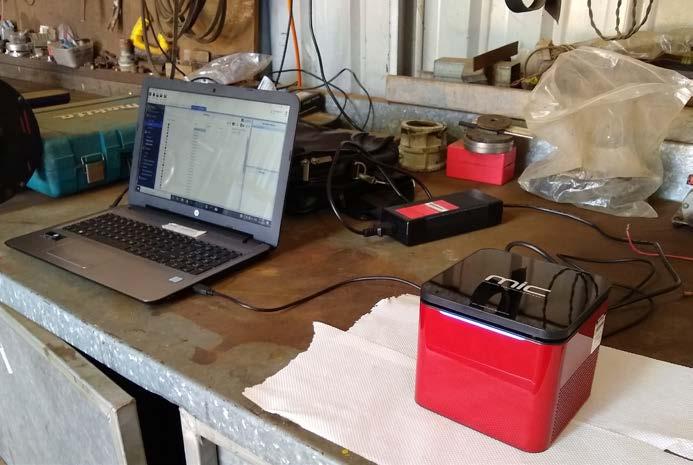
Research projects
Research projects that identify and isolate the fungicide resistance that has been selected underpin a broader application of the qPCR test. Data from these projects is used in designing chemistry for each test to successfully select a particular target. Once fungal pathogen populations are then quantified, says Dr Lopez-Ruiz, a link is established between crop management and results. The final stage is sharing the data with industry in order to drive practical outcomes.
Future plans include adapting the test to quantify powdery mildew resistance in grapes. Work to modify the primer chemistry required to correctly identify the specific powdery mildew fungicide resistance mutations has begun, which will be followed by testing and validation for in-field application. At this stage, the qPCR test for botrytis fungicide resistance detection is currently in use as a monitoring tool for wine industry research. SARDI/PIRSA Project Lead, Dr Mark Sosnowski, confirmed that plans are underway for future development of the qPCR test to include adaptation for use in high-throughput and in-field testing in order to make it more accessible to the industry.
Integral to the management of fungal pathogen populations is a resilient vineyard, from which in-field testing could offer increased agility in managing spray programmes. At Charles Sturt University, Professor Geoff Gurr is running a biodiversity project aimed at building vineyard ecosystems that deliver services beyond pest management to include pathogen suppression.
The two year project, Functional biodiversity solutions for Australian vineyards: harnessing groundcovers, vineyard surrounds and native plants to deliver key ecosystem services, is funded by Wine Australia in collaboration with See Saw Wines and Angullong Vineyard. It is due to conclude in June this year and data from the first season has been able to demonstrate a link between ground
concluded that eucalyptus species and myoporum yielded greater benefits in terms of nectar provision for LBAM parasitoid wasps than other species such as kunzea and acacia.
In the field, the project trialled midrow and undervine groundcover. Three different treatments were applied to each trial plot, in addition to the experimental
cover, beneficial insect populations and pathogen suppression. Professor Gurr says the project has generated measurable evidence that increased populations of insects and spiders suppressed light brown apple moth (LBAM) populations, thereby reducing incidence and severity of botrytis bunch rot. The project successfully identified ground covers, which through the provision of suitable nectar sources, not only increased the longevity of beneficial wasps (a key enemy of the LBAM), but also extended the period of time over which the wasps parasitised LBAM eggs.
The identification of suitable plant species was fast tracked by an extended period of lab work. Plants were tested in tiny flight cages containing parasitoid wasps in order to evaluate the suitability of nectar produced and subsequent use later in the project. Laboratory results
control where standard vegetation existed as the baseline. The treatments were;
• Alyssum, native seed mix, seed mix including clover and plantain - undervine
• Buckwheat, native seed mix, seed mix including peas, brassica, radish – midrow
The first part of the project has addressed the practicalities of working with groundcover, such as ease of establishing plant species and identification of measurable benefits in terms of height, weed competition, suppression of plant diseases and suppression of insect pests. The aim of the second season is to establish a library of plant species identified by the vineyard ecoservice offered, in addition to generating industry recommendations.
Following the completion of the project
36 Grapegrower & Winemaker www.winetitles.com.au March 2023 – Issue 710
Future plans include adapting the test to quantify powdery mildew resistance in grapes.
Field sample being processed in thermocycler, data displayed on computer screen. Photo: Lincoln Harper, Centre for Crop and Disease Management, Curtin University
in 2023 a final report will be issued and learnings will be shared on the Wine Australia website. Dr Mary Retallack of Retallack Vineyards Pty Ltd, which runs the national EcoVineyard programme, also confirmed that aspects of the project will be included in extension materials for growers over the next three years.
Far from being mutually exclusive, these two approaches to managing fungicide resistance have the potential for use as complementary techniques. The tool box from which to monitor and manage the nuances of site-specific pathogen populations in the vineyard is augmented by the addition of in-field testing alongside a suite of ecoservices as provided by targeted biodiversity in the vineyard.
Simone Madden-Grey is a writer based in Melbourne, Australia writing about the people, places and stories she has discovered on her travels. Her portfolio
can be found at happywinewoman. com including articles on climate and sustainability, new tech and the latest in scientific research supporting the wine industry in Australia and her home country, New Zealand. Further information
Functional biodiversity solutions for Australian vineyards: harnessing groundcovers, vineyard surrounds and native plants to deliver key ecosystem services. https://sway.office.com/ EWpG5dAN9LikpIrN
Managing fungicide resistance in Australia viticulture. www.wineaustralia.com/ research/projects/managing-fungicideresistance-in-austral
Interviews
Gurr, Geoffrey Professor, Professor of Applied Ecology, School of Agricultural & Wine Sciences, Charles Sturt University, Orange, NSW
Lopez-Ruiz, Francisco Dr, Associate Professor, School of Molecular and Life Sciences (MLS), Faculty of Science and Engineering, Curtin University, Perth WA
Retallack, Mary Dr, Viticulturist, Agroecologist, Managing Director, Retallack Viticulture Pty Ltd National EcoVineyards Program Manager
Sosnowski, Mark Dr, Sub-Program Leader, Horticulture Pathology Crop Sciences, Plant Health & Biosecurity,
Trust the original "yellow bag" for reliable control of Powdery Mildew
ü High qualilty micronised formulation
ü Optimum particle size for crop safety and efficacy
ü Excellent water dispersion and suspensibility
For further information talk to your local Syngenta representative or visit Syngenta.com.au/thiovit-jet
® Registered trademark of a Syngenta Group Company. AD21-208
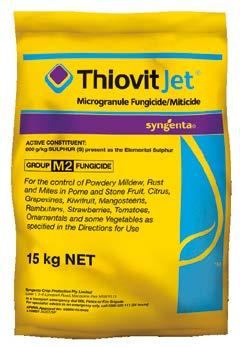
South Australian Research and Development Institute – SARDI
References
‘Fungicide resistance on the research radar, R&D News, June 2022’, Wine Australia. www.wineaustralia.com/ news/articles/fungicide-resistance-onthe-research-radar
Understanding fungicide resistance in powdery mildew, downy mildew and botrytis, Final Report to Australian Grape and Wine Authority. Research Organisation, SARDI. Project number SAR 1204, January 2017. Principal Investigator: Barbara Hall (SARDI). Chief Investigators: Dr Suzanne McKay (SARDI), Dr Fran Lopez (Curtin University), Lincoln Harper (Curtin University), Dr Sandra Savocchia (NWGIC), Dr Anthony Borneman (AWRI), Andrew Taylor (DAFWA)
Rapid in situ quantification of the strobilurin resistance mutation G143A in the wheat pathogen Blumeria graminis f. sp. Tritici. Kejal N. Dodhia (Centre for Crop and Disease Management, School of Molecular and Life Sciences, Curtin University, Bentley, Perth, WA). Belinda A. Cox (Faculty of Science and Engineering, Curtin University, Perth, WA), Richard P. Oliver (Curtin University, Perth, WA) & Francisco J. Lopez-Ruiz (Centre for Crop and Disease Management, School of Molecular and Life Sciences, Curtin University, Bentley, Perth, WA). February 2021.
March – Issue 710 www.winetitles.com.au Grapegrower & Winemaker 37
… data from the first season has been able to demonstrate a link between ground cover, beneficial insect populations and pathogen suppression.
Finding ways to improve frost fans to protect winegrowers
Frost is not a thing of beauty to a vineyard owner. It can destroy years of hard work in an instant. Learning to outsmart Mother Nature and protect young wine grapes from freeze has been the focus of Orchard-Rite since 1967.
Today Orchard-Rite, located in Washington state in the US, and their team of dedicated employees have been building their innovative frost fans for over 55 years. Their machines pull the warmer air from the inversion layer during a radiational spring frost, down to the crop zone to keep the tender new growth from freezing and causing lasting damage. The Orchard-Rite product is known for quality and reliability and their frost fans have now eclipsed sales of over 38,000 machines worldwide.
“The Orchard-Rite team of engineers continue to find ways to improve our frost fans, ensuring that winegrowers invest in the best frost protection in the industry,” says Jim Decoto, CEO of Orchard-Rite.
“Our data on thrust, wind momentum, air flow and noise have been independently tested and certified. The data is clear. Orchard-Rite frost fans have the lowest fuel consumption, have the highest volume of airflow, amount of thrust and level of wind momentum. No other frost fan manufacturer can say that,” Decoto continued.

“The testing data also clearly shows that the Orchard-Rite 2430, tri-blade machine is the quietest in the industry. It was tested and certified to meet Australian and New Zealand noise standards,” said Decoto. He added, “the testing numbers prove our machine is the quietest; 49 dB at 300 meters and 55 dB at 150 meters”.
Orchard-Rite’s ORCell product was developed to provide growers complete control and monitoring over their frost fans from anywhere in the world with an internet connection. This technology informs the grower in real time about
the status of each machine, reducing labor costs to monitor them during a frost season. ORCell increases efficiency, saving time, effort and crops.
“With the ORCell system, growers can remotely control, monitor and manage their frost fans anywhere, anytime and from any computer or mobile device,” said Decoto. This state-of-the-art cellular communication network and service, work seamlessly with all Orchard-Rite frost fans equipped with AutoStart®, providing piece of mind that vineyards will always be protected even if you are half-way around the globe.
There are similar products in the industry but, not all offer the many features and benefits that the ORCell control and monitoring system provides. Many of the competitors are not able to offer critical features such as Start/ Stop and Set Differential Temperature, the ability to use I.S. with fuel sensors, alarms for low oil pressure, overheating, blown fuses, lost CAN communication, wind delays and inability to start.
“Another key feature of the ORCell system is mapping,” said Tyler Carey, ORCell manager at Orchard-Rite.
“Mapping allows the grower to see an aerial map of all frost fans and helps to easily identify a singular machine that needs attention,” added Carey. Equally important is the ability to access information in ‘real time’ with the ORCell system.
“No time is lost when a critical issue needs addressing,” said Carey. When seconds count during a weather event, ORCell delivers the information you need to correct the issue before serious damage takes hold.

Mother Nature doesn’t always play nice, but thankfully there are products available to help prevent the damage she can cause.
“The combination of Orchard-Rite frost fans with the ORCell system, provides peace of mind that your vineyard will be protected in critical weather events, even when you can’t be there,” said Decoto.
38 Grapegrower & Winemaker www.winetitles.com.au March 2023 – Issue 710 supplierupdate
FROST PROTECTION
Largest Frost Fan Manufacturer with Over 38,000 Fans SOLD Worldwide!
In Australia
In
The First Frost Fan Installed in 1994
The First Frost Fan Installed in 1994
In New Zealand
The First Frost Fan Installed in 1978, Still in Operation
In New Zealand The First Frost Fan Installed in 1978, Still in Operation
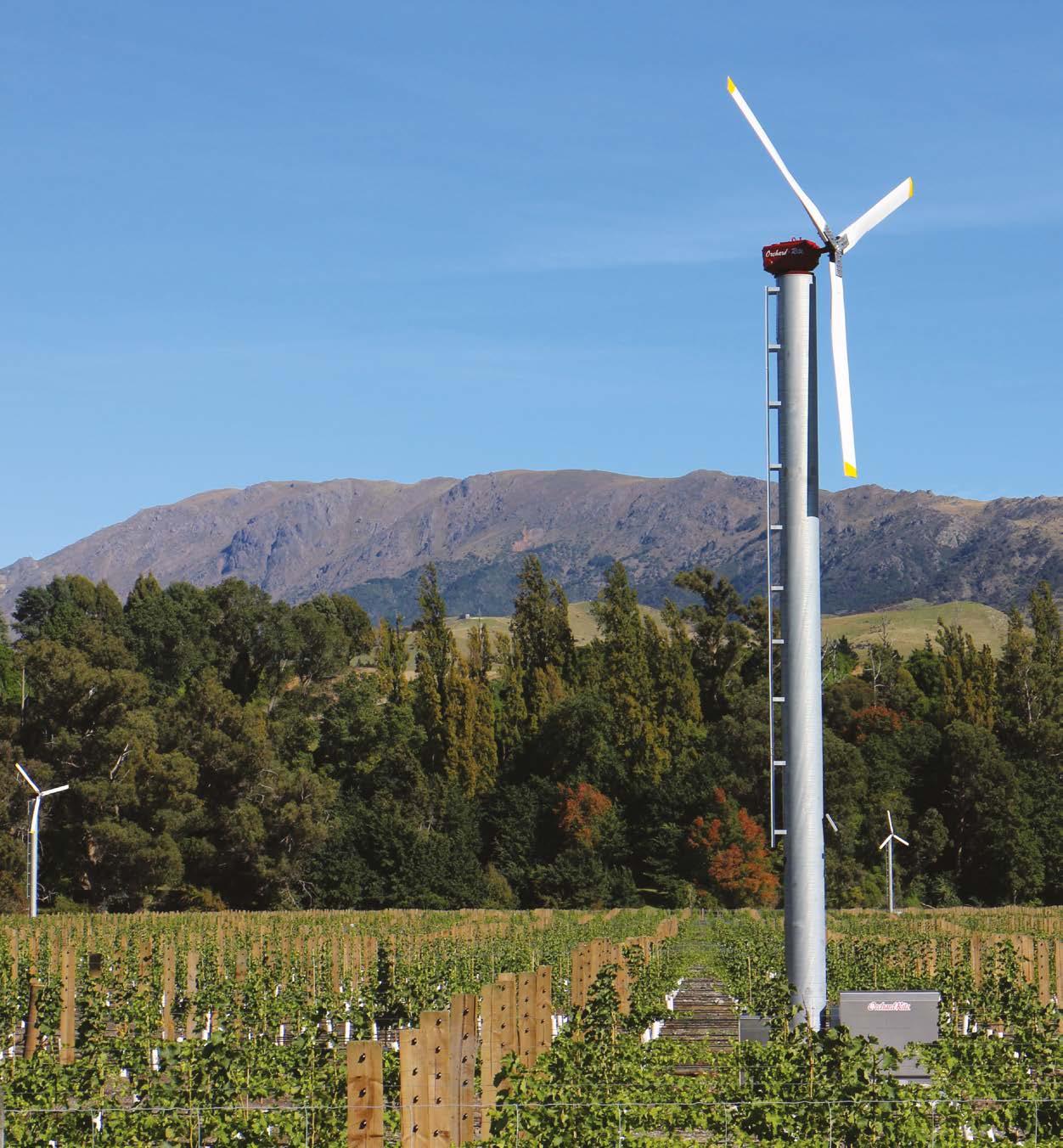
Independently Tested & Certified to Meet US, Australian & New Zealand
Independently Tested & Certified to Meet US, Australian & New Zealand
Noise Standards:
Noise Standards:
49 dB at 300 Metres & 55 dB at 150 Metres
49 dB at 300 Metres & 55 dB at 150 Metres
CERTIFIED:
CERTIFIED:
Lowest Fuel Consumption
Lowest Fuel Consumption
Highest Volume of Airflow
Highest Volume of Airflow
Highest Amount of Thrust
Highest Level of Wind Momentum
Highest Amount of Thrust of Wind Momentum
Orchard-Rite, The World’s Most Trusted Machine for Frost Protection!
Orchard-Rite, The World’s Most Trusted Machine for Frost Protection!
Pat Sullivan
March – Issue 710 www.winetitles.com.au Grapegrower & Winemaker 39
04 2981 4070
patsullivan@orchard-rite.com




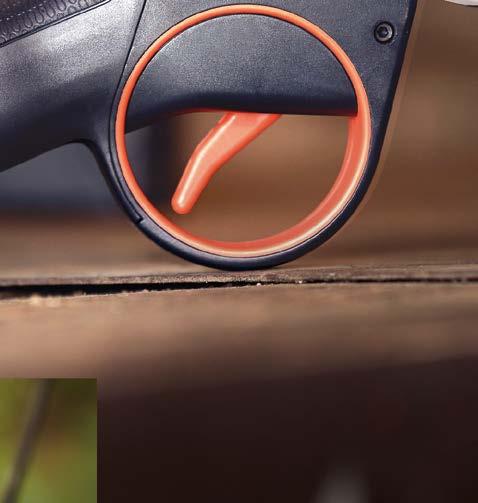


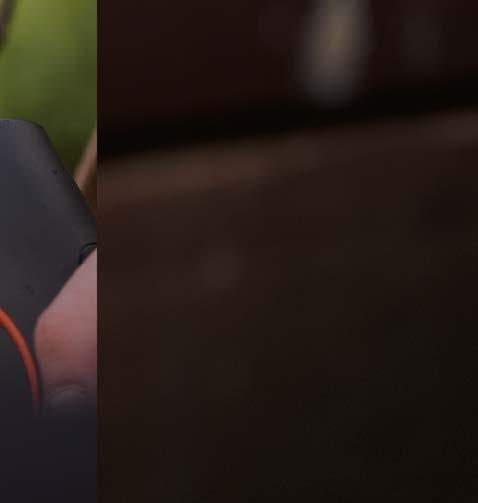

Chenin Blanc
Uncorked
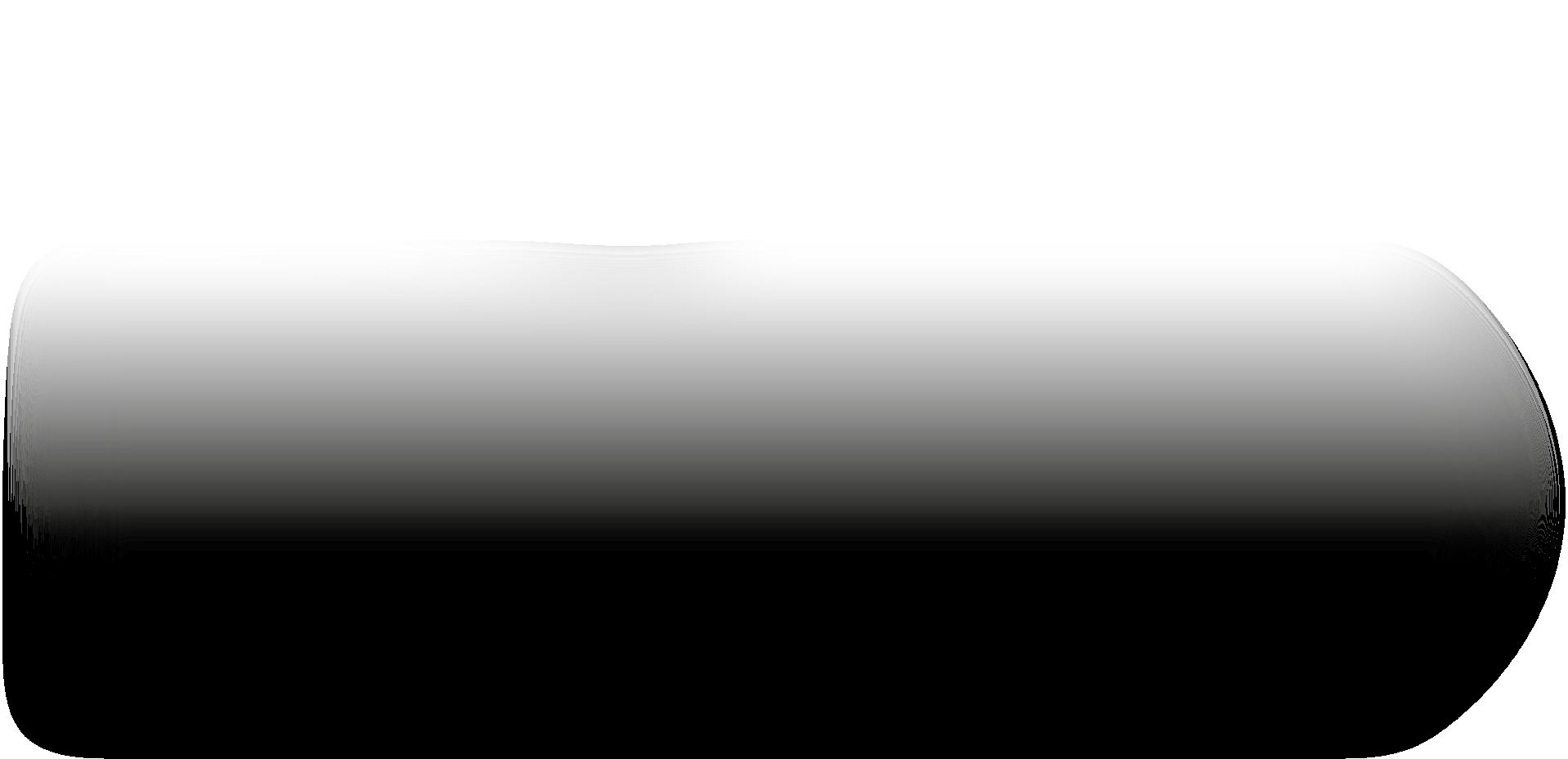
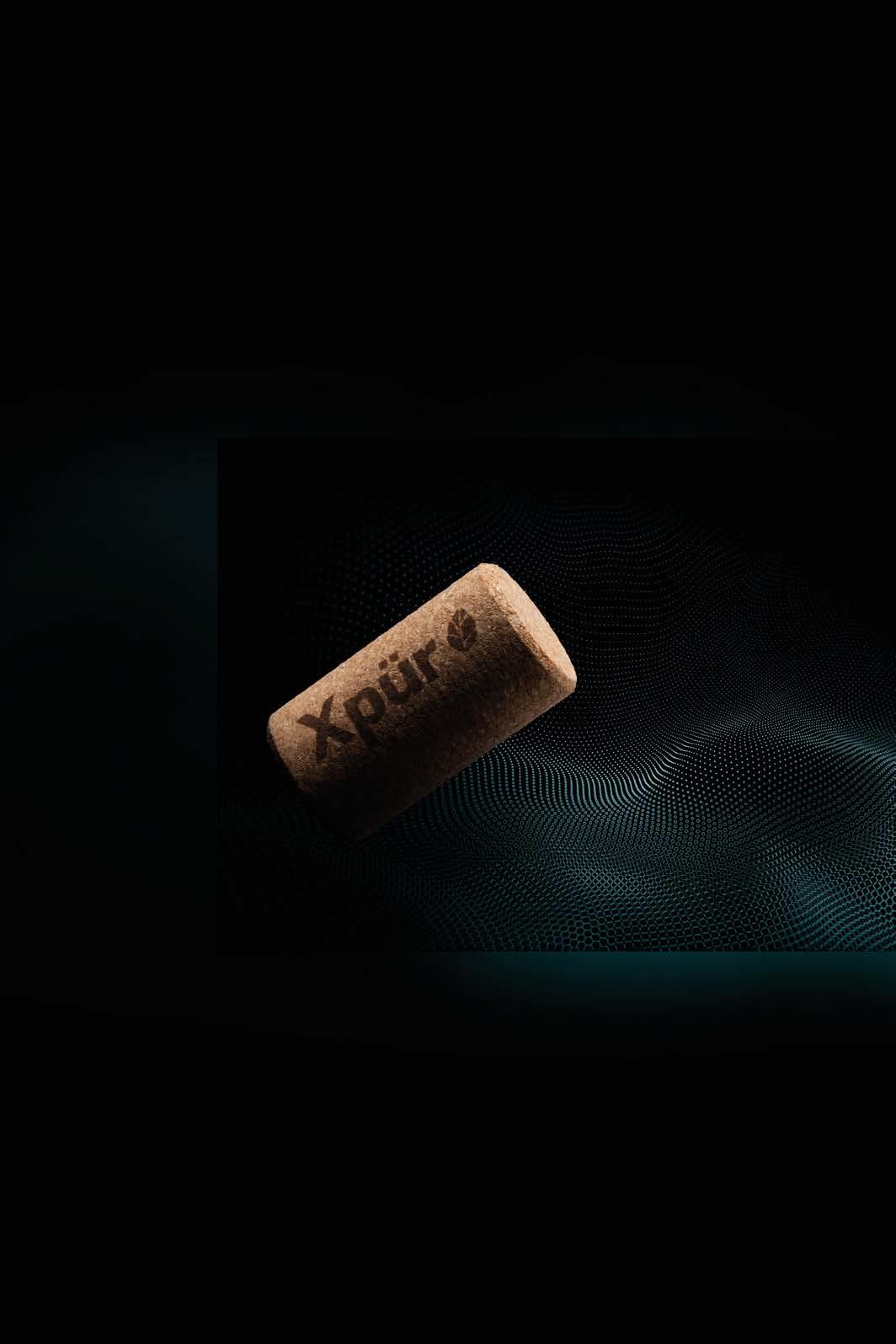
Out of Africa
Chenin Blanc has a history in Australia that extends further back than almost any other variety, yet few find it in the wider wine lexicon of consumers. The cult variety is renowned for its acidity and tropical notes, making it a favourite of many. Harrison Davies sought out Chenin producers to see what was next for the burgeoning variety.
Chenin Blanc has become a decidedly new world variety.
Despite hailing originally from France’s Loire Valley, Chenin became somewhat of a workhorse grape in Australia and the US and found a spiritual home in South Africa.
Chenin is now the posterchild for South African winemaking, being the country’s most planted grape and seeing more plantings in that country than anywhere else in the world.
That South African heritage is also what brought it to Australia back in 1829, when a handful of South African producers migrated to the Swan Valley with a few Chenin cuttings in tow.
Since then, Western Australia, and the Swan Valley in particular, has become the home of Chenin Blanc in Australia.
The grapes bud early in the season but take their time ripening and are often picked after other whites like Chardonnay.
The vines are also very representative of their site, making them of particular interest to winemakers. In denser, clay-rich soils the grapes can produce heavier, sweeter flavours whilst sandier and limestone-based soils can produce Chenin with higher acidity and aroma.
Chenin in Australia has for many years been used as a blending wine and is used in dry white blends alongside varieties like Sauvignon Bland and Semillon.
Today, Chenin is grown all across Australia, but the most significant plantings are still to be found in the Swan Valley and Margaret River regions.
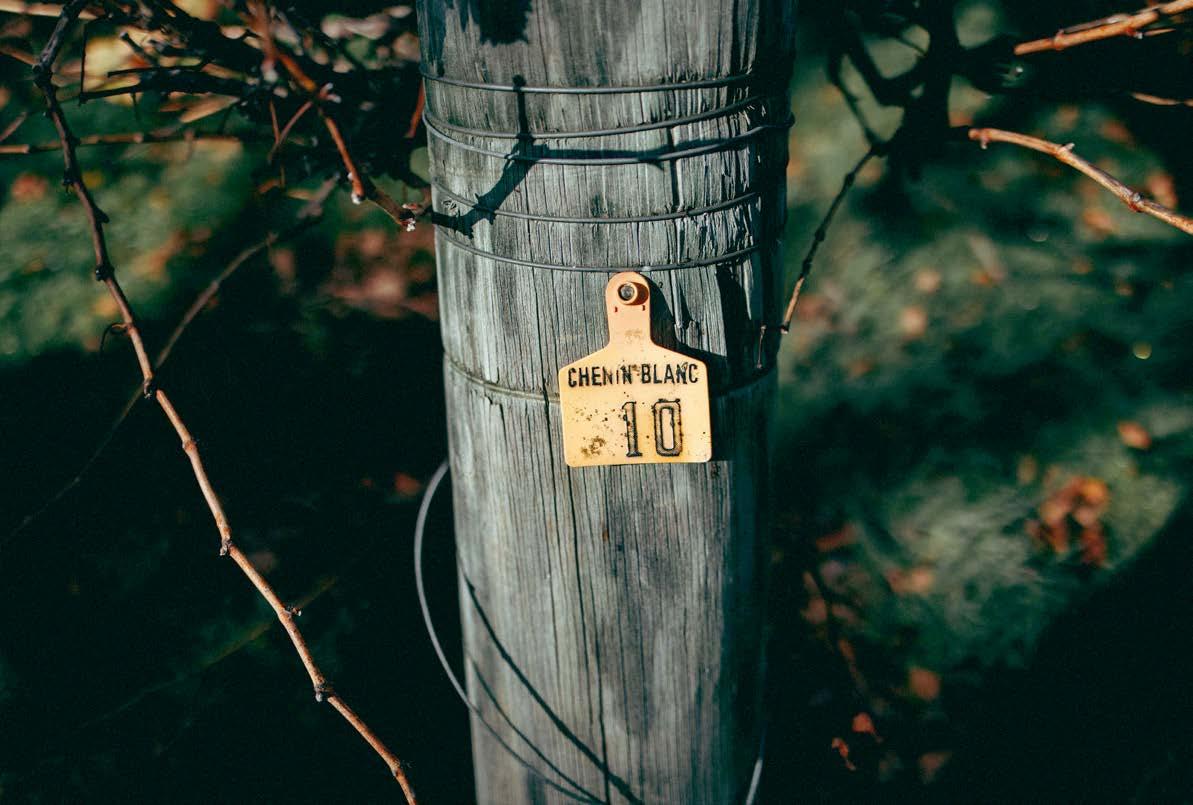
Vines are very well established in other states, but not as historically as in WA.
Still, significant plantings are found in the Barossa, Rutherglen and McLaren Vale. It also has an increasing presence on the North Island of New Zealand.
A long history in WA
Chenin Blanc was first brought to WA in 1829 and the variety represents some
amorimcorkstoppers
Chenin Blanc vines at marri Wood Park in Margaret River. Photo: L.A.S. Vino
Chenin Blanc is an ultimately versatile variety, so it can theoretically be grown in most conditions and climates with good success and expression of terroir.
Remi Guise
Chenin Blanc through the years
9th century:
Ampelographers theorise that the variety first originated in the Anjou region of the Loire Valley
1496:
A white grape known as Plant d’Anjou was planted on a site known as Mont Chenin in Touraine by the Lord of Château de Chenonceau and his brotherin-law, Denis Briçonnet
1655:

Chenin Blanc is first grown in South Africa, where it would become known for many years as Steen. It was reportedly first grown by Dutch navigator Jan van Riebeeck
1829:
South African wine producers bring Chenin to Western Australia and plant cuttings in the Swan Valley. These planting are among the oldest in the country and pre-date the famous Busby vines, which were brought over in 1832
of the earliest winegrape plantings in the entire country.
Wineries in the Swan Valley where the original vines were planted are still among the oldest working wineries in the country.
However that pedigree of history hasn’t always brought a spotlight in WA regions, as Chenin was used for a long time in non-descript white blends.
In recent years however, younger winemakers have found interest in the variety to make varietal wines in newer styles, highlighting the bright, acidic flavours that the grapes offer.
One such producer is Remi Guise, who is producing exciting Chenin from Margaret River through his tripe.Iscariot label.

“I have been working with Chenin Blanc both in the vineyard and winery since my very first vintage in South Africa in

“Chenin Blanc tends to ripen 3-4 weeks after Chardonnay if on the same site, around the same time as Sauvignon Blanc.”
Chenin has a history out of WA as well, and like many varieties has seen historical use in the Barossa.
Dave Geyer, winemaker for the Geyer label, manages a vineyard in Vine Vale and crafts a skin contact varietal Chenin. He said the region, like Margaret River and the Swan Valley, was a good place to be growing Chenin due to low night-time temperatures and mineral soils.
“I think Chenin Blanc here in the Barossa is completely underrated. The first vineyard I ever had was on the side of a hill in the Vine Vale area, about 100 years old and would have been planted along with some Riesling, a little bit of Crouchen,” Geyer said.
grapegrowing
amorimcorkstoppers
Uncorked


DNA research has shown that Chenin Blanc shares genetic parents with varieties such as Savignin, Trousseau and Sauvignon Blanc.
premium expression, then lower fertility soils with moderate to low water holding capacity are preferred.”
Chenin Blanc grows well in varied soil types like silex, schist, sand and clay and responds well to cooler temperatures and a high diurnal variation.
Guise said the vintage this year was likely to be strong.
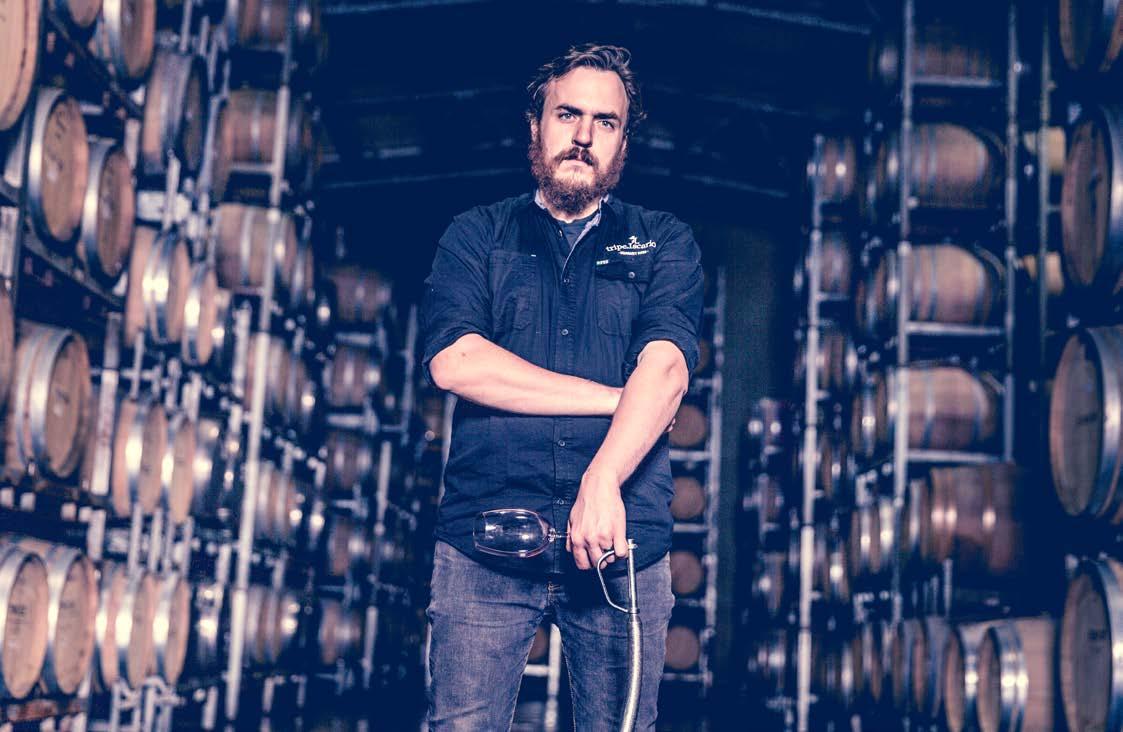
“So far the season is looking very promising: despite a relatively cool and wet spring, the subsequent start to summer has been warm and dry, with uniform flowering and set across most varieties and sub-regions in Margaret River.
“Based on the current fruit condition, sugar accumulation and acid breakdown, we are in for a flavoursome yet poised and balanced season, assuming of course that we see a continuation of the fantastic weather we are enjoying at the moment.”
amorimcorkstoppers
Tripe.Iscariot winemaker Remi Guise
winemaker, can put your stamp on,” he said.
“Leading up to picking we’re probably out there every two or three days tasting the grapes, making sure that we try and pick out exactly where I like it.
“I tend to run anywhere between 11 and a half Baumé to 12 and a bit. So essentially on the leaner side of white wine.
“I always try and retain as much natural acidity as possible because as a producer, I don’t like to acidify my wines, so I need that natural acidity there to make sure my wines are balanced through fermentation and into ageing.
“A portion of it is fermented on whole bunch, so carbonic maceration of about a tonne for two, for two and a half weeks. And then the rest is destemmed, and left on skins for 24 hours and then pressed into old puncheons and old hogsheads to ferment in barrel.”
More and more producers are looking at Chenin because it’s a variety that allows the producer to make their own mark and both Geyer and Guise said they thought it was a good variety for producers to do just that.

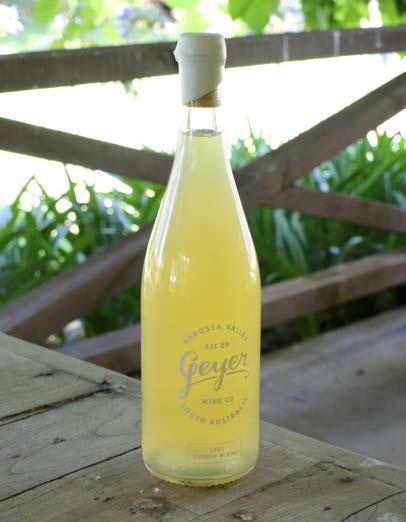
“What has made the interest in the grape more sustained and permanent than others is anyone’s guess, but I like to believe it has been driven by the sheer
quality and increased accessibility to serious and thought-provoking wines, all the while offering bright fruits, refreshing natural acidity and infinite drinkability and application,” Guise said.
“The younger generation of winemakers, the guys that are starting up, they don’t essentially have their playbook yet. They get to experiment and try different stuff with a variety,” Geyer said.
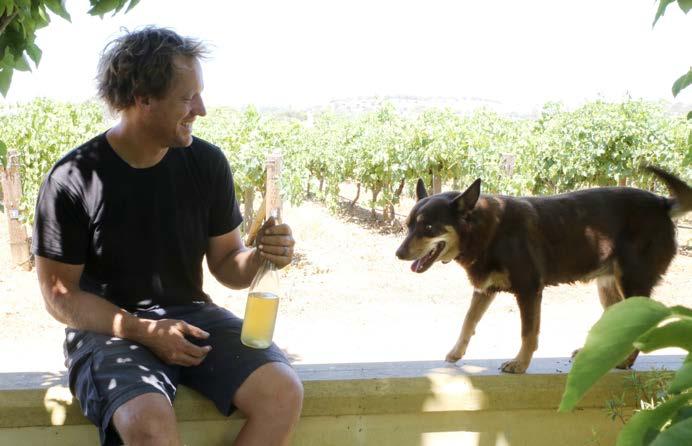

“I think it’s the winemaker, I think it’s people starting to think a little bit differently and how to ferment using skins and using stems, different fermentation vessels, which has obviously been done for thousands of years in particular parts of the world.
“It’s not a Shiraz, it doesn’t have to be disturbed and pumped over for seven days and then pressed into oak, it’s got a little bit more leeway.”

grapegrowing amorimcorkstoppers
Geyer Chenin Blanc
Uncorked
Chenin Blanc is particularly susceptible to spring frost, powdery mildew and fungal disease.
Geyer Winemaker David Geyer and vineyard assistant Indy
Chenin Blanc grapes. Photo: Frances Andrijich
Understanding Australian sustainability credentials
Sustainability is an area of increasing focus in the Australian wine industry, driven by consumer and market demand and the inherent desire of our producers to protect their land and livelihoods for future generations. In this column, Dr Mardi Longbottom answers some of the key questions about sustainability credentials and metrics that allow Australian producers to demonstrate their performance on a global stage.
What is sustainability?
The concept of sustainability means meeting the needs of the current generation without compromising the needs of future generations. It generally takes into account economics, the environment and communities. In the context of the wine industry, sustainability means growing grapes and making wine in ways that are not detrimental to the environment and in fact improve it so that we can continue growing grapes and making wine for infinite generations. The ‘environment’ needs to be considered in its broadest sense to include the communities and economies in which we operate.
Sustainability is complex and subjective. The elements of sustainability are intertwined and not the same for every grape and wine business. However, the use of standardised metrics does make it easier to measure and monitor our performance across a range of aspects that are critical to sustainability. For example, the most basic metrics such as yield, water, fertiliser and energy inputs, are all critical to understanding vineyard sustainability.
Since the early 1990s ‘sustainability’ has been described in range of ways in an attempt to succinctly communicate its scope. Simple descriptors such as ‘the three Ps’ (People, Planet, Profit), ‘the
three Es’ (environment, economy, equity) and ‘triple bottom line’ (environment, social, economic) are well accepted. More recently, in 2015, the United Nations defined 17 sustainable development goals (UN SDGs) which serve as a plan for everyone to achieve sustainability.
Lately I’ve been hearing the acronym ESG a lot – what does it mean?
Environmental, Social and Governance (ESG) was coined in 2005 and has recently increased in prominence. ESG describes the metrics used by companies to evaluate and communicate their sustainability performance to
Don’t settle for less.
You’ll never look back once you’ve used the Europress.
With the perfect combination of power and control, the Europress cares for your grapes as much as you do. Easy to use and even easier to clean, more juice per tonne with preset and individual programs.
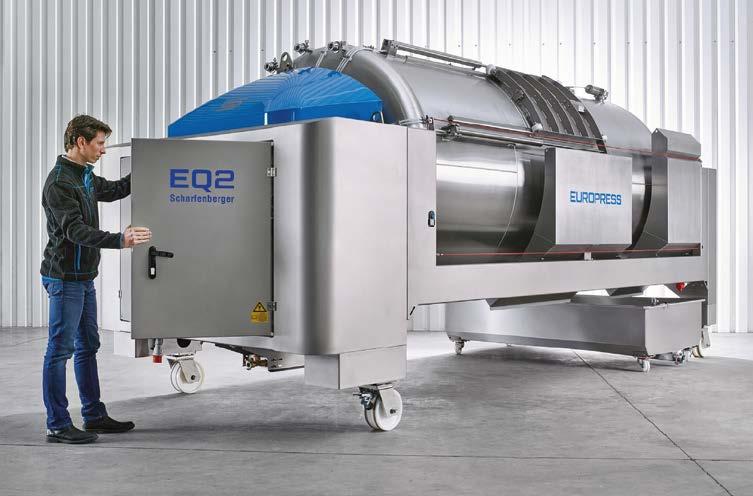
Find out why so many winemakers rely on the Europress.

March – Issue 710 www.winetitles.com.au Grapegrower & Winemaker 45
ask the
AUSTRALIA:
9555 5500 grapeworks.com.au NEW ZEALAND: 04 390 3577 grapeworks.co.nz
03
Planning for Vintage 2024? Order now to ensure delivery.
markets, investors, shareholders and the community. The major difference with ESG is the focus on governance – the processes used by businesses to make decisions to ensure they operate efficiently, comply with the law and meet the needs of external stakeholders.
Australia is in a fortunate position with the recent focus on the social and governance elements of sustainability because, compared to some competitor countries, Australia is supported by a strong regulatory framework at local, state and federal levels. Examples of these include Work Health and Safety and Modern Slavery legislation and the general expectation that all Australians follow these laws.
How can Australian growers and winemakers evaluate and communicate their sustainability credentials?
Over many years, the Australian wine industry has invested in Sustainable Winegrowing Australia (and its predecessors) and the program is supported by the key national wine industry bodies, the AWRI, Australian Grape & Wine and Wine Australia. The program provides an online platform for growers and winemakers to annually report their key sustainability metrics and to undertake a self-assessment of their practices. What sets it apart from other ESG platforms is the ability for members to benchmark their performance against others in the wine industry. For those who choose to become certified, the program is underpinned by a private certification standard (Freshcare Australian Wine Industry Standard of Sustainable Practice – Vit/Win). Once certified, members can use the Sustainable Winegrowing Australia trust mark to communicate their sustainability credentials. More information about Sustainable Winegrowing Australia can be found at
www.sustainablewinegrowing.com.au
Is Sustainable Winegrowing Australia certification internationally recognised?

The Sustainable Winegrowing Australia trust mark is trademark protected in Australia, Canada, the European Union, Japan, New Zealand, the United Kingdom, United States of America and Singapore. Trademark protection has been an important step ahead of recognition and use in the international marketplace, along with acceptance by key markets. Sustainable Winegrowing Australia and its certification standards have been independently benchmarked against thirty-eight similar international programs across twenty-seven Environmental, Social and Governance criteria. Based on the results of this benchmarking, Sustainable Winegrowing Australia certification is recognised by Systembolaget in Sweden and Alko in Finland. It is also a criterion for wines to be selected by the Swedish and Norwegian wine monopoly retailers. The Sustainable Winegrowing Australia trust mark is also an approved certification mark which, if visibly displayed on wine packaging, qualifies the wine for entry into Sweden’s ‘Sustainable Choice’ product category.
Sustainable Winegrowing Australia has also been benchmarked against other agricultural commodity groups in Australia using the Australian Agricultural Sustainability Framework (AASF). The AASF has been created to communicate the sustainability status and goals of the Australian agricultural sector both in Australia and globally. The AASF is aligned with other global sustainability schemes and standards including Sustainability Assessment of Food and Agriculture Systems, SAI Platform, World Benchmarking Alliance and Global Reporting Initiative.
What are the benefits of having a strong sustainability strategy and credentials?
Certified members of Sustainable Winegrowing Australia regularly review their businesses and document a Sustainability Action Plan (SAP). Members tell us that the benefits of certification include:
• Active contribution to environmental protection and enhancement (e.g. reduced emissions and impact on air quality)
• Identification of production efficiencies and cost reductions
• Ability to access reduced-cost finance (e.g., sustainability-linked loans)
• Enhanced reputation in the community and marketplace
• Better engagement in the workplace
• Reduced risk (e.g., by implementing biosecurity systems)
• Increased accountability of the business
• Increased likelihood of making datadriven decisions
• Access to new markets
• Increased competitiveness in the marketplace
For further information about sustainability credentials or Sustainable Winegrowing Australia, contact the AWRI helpdesk on (08) 8313 6600 or helpdesk@awri.com.au.

Further reading
Systembolaget approved certificationswww.omsystembolaget.se/english/ sustainability/labels/sustainable-choice www.omsystembolaget.se/english/ sustainability/labels/sustainable-choice/ environmental-certifications
46 Grapegrower & Winemaker www.winetitles.com.au March 2023 – Issue 710
Taylors Wines boasts clear benefits of water filtration system
Acknowledged at the Wine Industry Impact Awards presented by the Wine Industry Suppliers Association late last year, a bespoke mains water filtration system at Taylors Wines has dramatically reduced the company’s consumption of water and wine filtration media and can be easily adapted for other wineries experiencing similar quality issues with their process water, writes
Taylors Wines is singing the praises of its now award-winning water filtration system that is not only supplying the Clare Valley winery with mains water of much higher quality for cleaning, cellar and bottling operations but considerable improvements in wine filtration media performance.
Commissioned in 2020, the water purification system picked up the Award for Sustainability at the 2022 Wine Industry Impact Awards (WIIA), presented in late 2022 by the Wine Industry Suppliers Association. The installation followed Taylors increasing
Sonya Logan
frustration at its high turnover of water and wine consumable filters, known to be primarily caused by the quality of the mains water coming into the winery, which did not sit well alongside its commitment to sustainable practices.
Taylors chief winemaker Adam Eggins says the company had long struggled to achieve the performance expectations cited by the manufacturers of wine filter media used in its pre-bottling filtration systems, resulting in an unacceptably high number of both water and wine filters goings to landfill, along with the associated labour to replace them.
While mains water is suitable for human consumption, the quality can be insufficient for winery use and can vary considerably. Although lenticular filters had been used at Taylors for some years to remove sediment from its mains

March – Issue 710 www.winetitles.com.au Grapegrower & Winemaker 47 winemaking
Filtration
Taylors chief winemaker Adam Eggins
As soon as we went to the ultra-filtered water supply, everything seemed to improve.
Adam Eggins
winemaking
water, they had to be changed frequently, adding significantly to the company’s overall consumption of filter media.
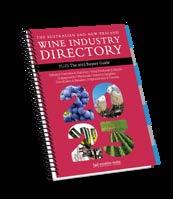
A solution to their water-related woes was unearthed after consultation with industrial filtration specialist BHF Technologies which recommended the installation of an ultrafilter, which uses regenerable membranes capable of filtration down to 0.02µm.
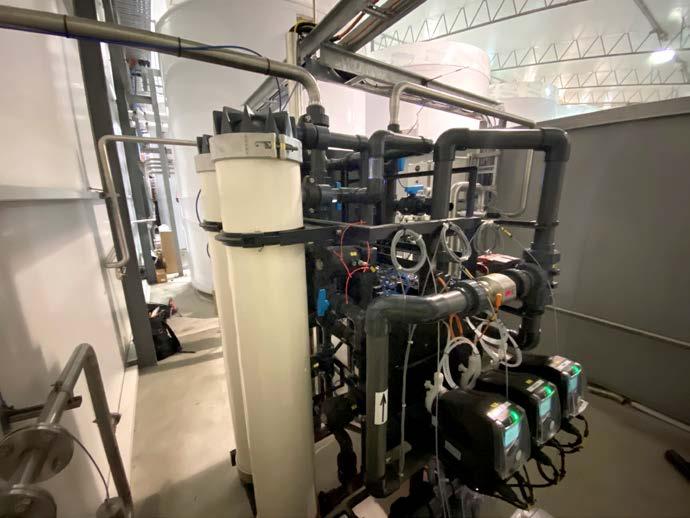
Having used a small ultrafilter some 20 years ago, Taylors was initially hesitant about installing another one. But BHF convinced the wine company that a bigger, more modern unit was the best solution to their excessive filter consumption.
To avoid installing an overly large ultrafilter to meet Taylors peak water demands during vintage, BHF recommended investing in a smaller unit and using a holding tank, allowing the ultrafilter to process water when there is reduced demand and be stored ready for use. To achieve this objective, one of Taylors’ existing temperature-controlled wine tanks was commandeered to provide the storage vessel for the water where it is held at around 14°C.
The final component of the water filtration system serves two purposes.
First, it keeps the purified water recirculating from the storage tank, reducing the risk of a biofilm forming on surfaces if the water is static. The water is also exposed to UV sanitisation both before filtration and during recirculation to enhance its sanitation.
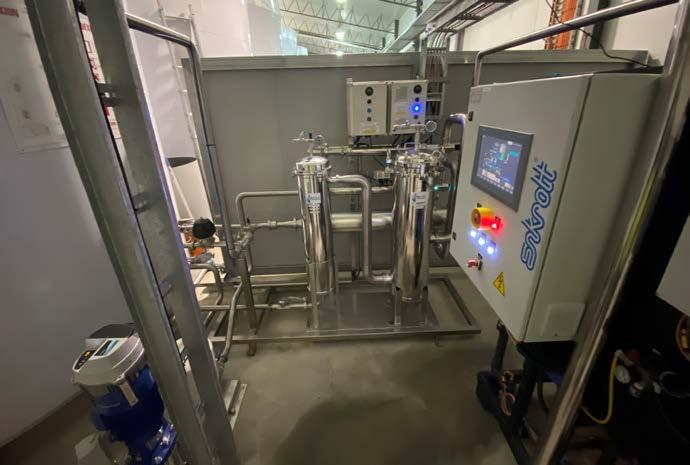
Secondly, it absorbs the chloramine that SA Water, like other Australian mains water suppliers, often use to kill bacteria and other pathogens. Taylors had been utilising granular carbon beds in an attempt to remove the chloramine — a combination of ammonia and chlorine — which has the potential to form unwanted byproducts like TCA. However, BHF informed Taylors that
carbon beds can be inadequate at removing chloramine.
“As soon as we went to the ultra-filtered water supply, everything seemed to improve,” remarks Adam Eggins.
“We’ve got a [wine] crossflow filter
which started washing itself better. The performance of all our [wine] filtration media improved. Our [wine] filtration costs went down, manual handling went down, the amount of environmental waste we were sending to landfill went down.
48 Grapegrower & Winemaker www.winetitles.com.au March 2023 – Issue 710
From left to right, the product water tank, recirculation pump and carbon UV skid of Taylors ultrafilter.
You can find filtration suppliers here. Did you know? The entire Australian & New Zealand wine industry in one book ORDER YOUR COPY: winetitles.com.au/WID or phone +61 08 8369 9500
The rear of Taylors ultrafilter with the membrane modules on the left.
“The ultrafiltration technology turns the mains water supply into a constant supply of quality water so we’re very big fans; the technology is really quite impressive,” says Eggins, revealing his only regret is that the winery didn’t install a similar ultrafiltration system 20 years ago.
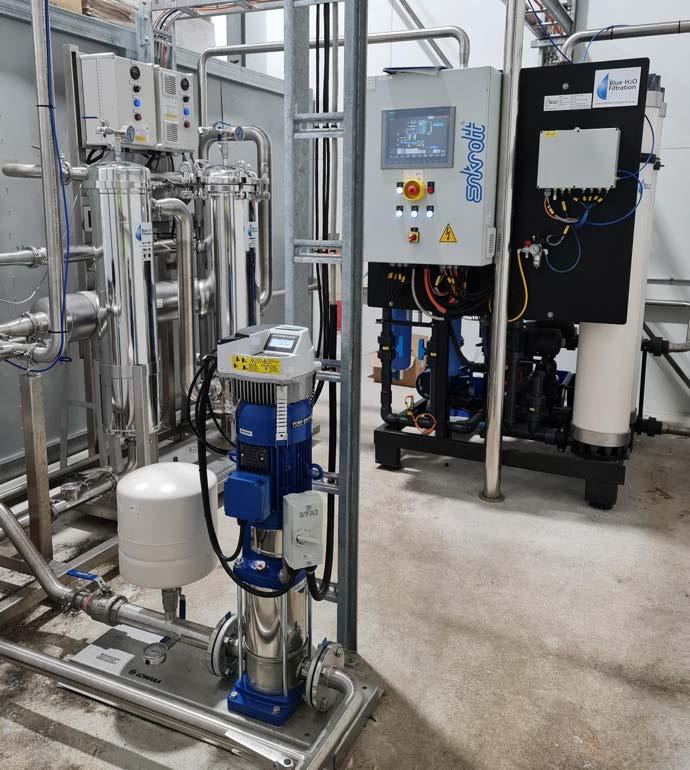
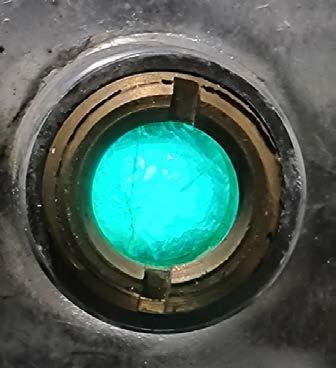
The main benefit of the system is being able to get close to “supplier-rated wine filtration performance”, he says.
“That’s a really boring technical statement” admits Eggins, “but what it means is that we have less real direct costs in consumable media [and] a lot less waste is going to landfill. We were getting 20% or 30% out of those [wine] filters and throwing them in the rubbish and that’s really terrible. Now we’re getting 100% or even 120%, which is just amazing”.
“With some of the [wine] filters, we’re [now] buying about a fifth of the amount that we used to buy, and with other [wine] filters we’re buying about around 40% of what we used to purchase. So we’re getting full-rated performance out of the filters that we should have always had.”
Self-maintaining technology
Paul Bowyer, BHF’s group oenologist and regional manager for South Australia and Tasmania, explains that Taylors’ ultrafilter is self-maintaining.
“When it gets to a point where the membranes in the ultrafilter have taken up a certain amount of load and/ or have processed a certain amount of water according to a setpoint, it’ll do an automatic clean cycle. That whole process is automated whereas previously Taylors had to replace their mains water lenticular filters every three weeks or so during peak processing times. That involved stopping all the water coming into the site, taking the water filter

Grapegrower & Winemaker 49
That whole process is automated whereas previously Taylors had to replace their mains water lenticular filters every three weeks or so during peak processing times. Paul Bowyer
BHF’s group oenologist Paul Bowyer.
ABOVE: Taylors water purification unit exposes mains water to two UV lights: the first is a single pass prior to ultrafiltration while the other helps to disinfect the water as it is circulated from the storage tank.
LEFT: The hub of Taylors ultrafiltration unit that is purifying the mains water coming into the winery before it is used in cellar and bottling operations.
housings apart, taking the filters out, putting new ones in, throwing the old filters into landfill, putting the domes back on, reassembling the housings and then opening the tap again. That’s a lot of wastage, a lot of personnel time.”
Bowyer says that while most wineries filter their process water, the variations in the quality of that feed water, whether rainwater, dam water or mains water, necessitates different approaches.
“It can be as simple as running the water through some simple cartridge and carbon filters with possible UV treatment on the end to sanitise that water as it’s produced, all the way up to an ultrafilter, a recirculated loop and a product water storage tank,” he explains.
“But all the water treatment processes that are below the level of the installation at Taylors come with considerable ongoing consumables costs. So it comes down to a balance between the water quality, the volume process requirements, the
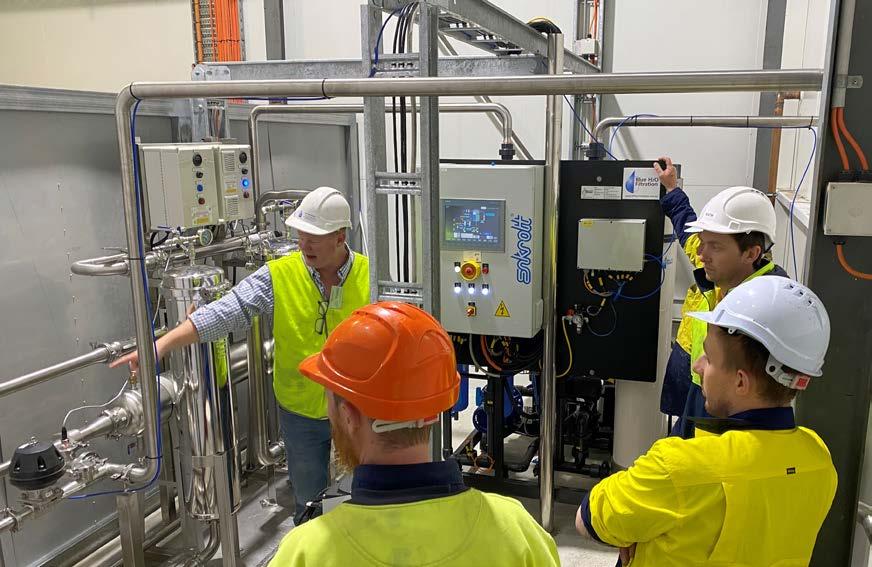
consumables costs and also how serious companies are about their approach to sustainability because an ultrafilter is obviously more sustainable since it doesn’t have anywhere near the landfill impact due to its regenerable nature.
“For medium to large wineries, this is a superior way to approach process water problems on many levels. It improves quality to a vast extent over anything you can achieve with consumable filters, plus it’s self-maintaining,” Bowyer says, adding the ability to store the processed water is optional.
“You could use the ultrafilter on its own. A system of sufficient size can produce process water at the peak rate you need but the problem is that generally requires a fairly big ultrafilter because it’s on demand. If you can store that water then you can use a much smaller system that can refill overnight, for example.”
For wineries interested in investigating an ultrafiltration water treatment system
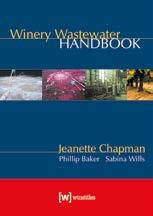
like Taylors, Adam Eggins had this advice:
“One of the things about the ultrafilter and our [wine] crossflow filter is they run 24 hours a day, so they’re semiautonomous machines. When processes are running 24 hours a day it’s really good to invest in very clever technology if you’re relying on that thing to protect itself 24 hours a day. If we have tanks or equipment that we mainly use when humans are on deck, we may use different technologies because they’re under human supervision. But we’ll always invest in the very, very best kit we can, including hoses, pipes, pumps, valves, when it’s a system that is self-regulating or runs itself. The ultrafilter generally runs 24 hours a day, which is why we’ve got some pretty good technology to make sure it’s safe and reliable.”
50 Grapegrower & Winemaker www.winetitles.com.au March 2023 – Issue 710 winemaking
Shop the Winetitles Bookstore online. Help to better manage your wastewater with the Winery Wastewater Handbook www.winetitles.com.au/shop
BHF Technologies’ Steve Brunato walks Taylors staff through the operation of its ultrafilter.
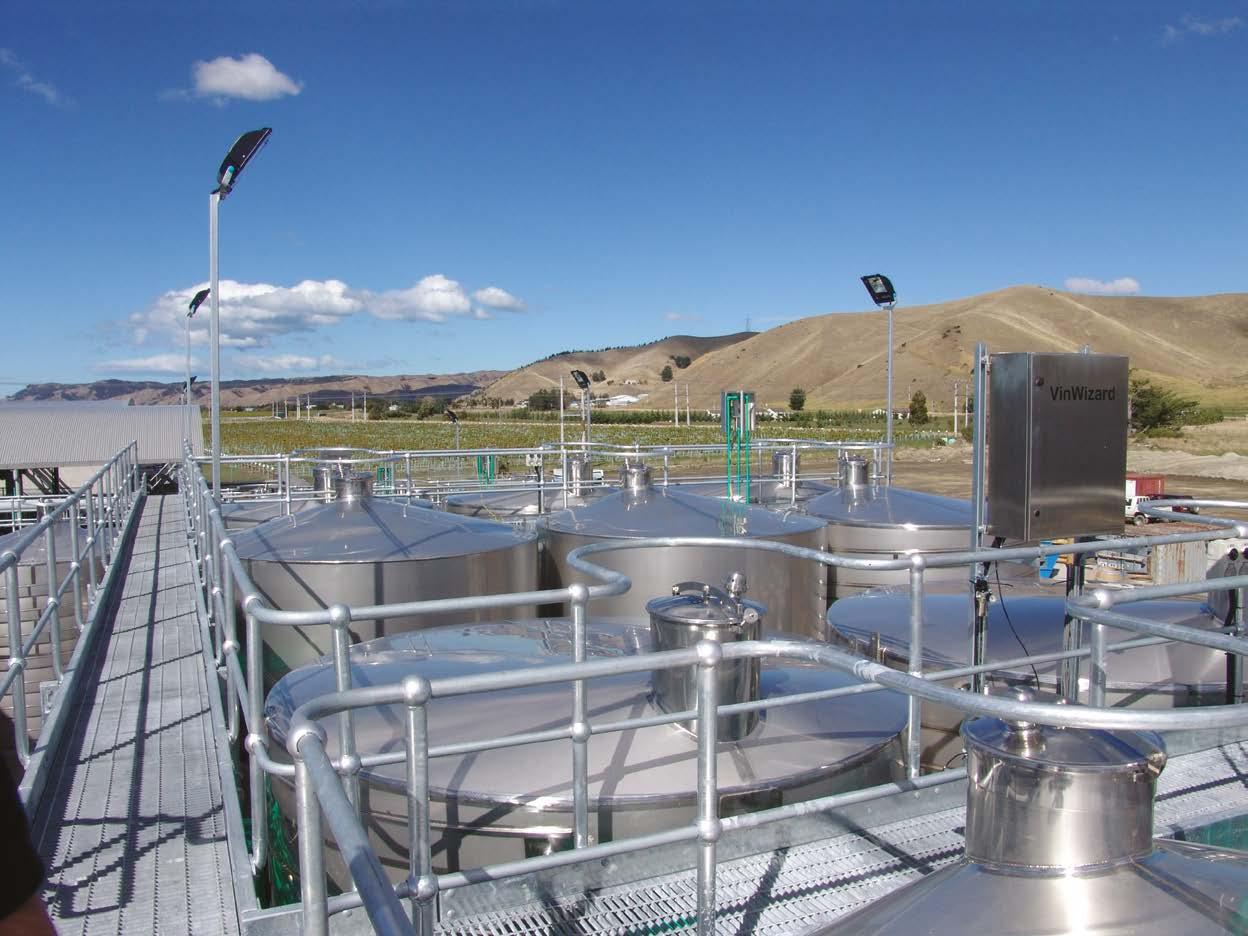
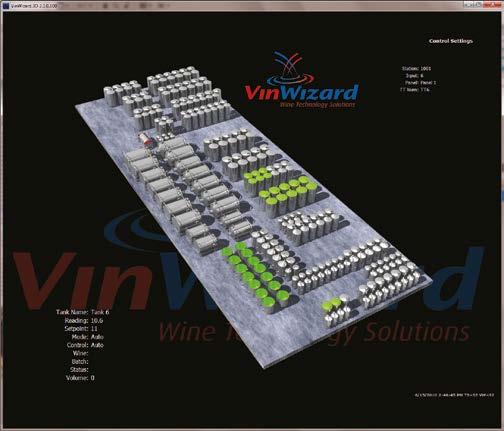
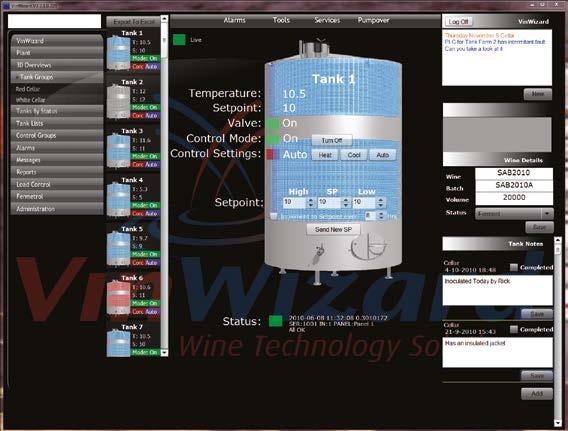
March – Issue 710 www.winetitles.com.au Grapegrower & Winemaker 51 The new age of Tank Temp & Winery Automation Web: www.vinwizard.com – Phone: Australia +61 41 614 3902 1 2 3 Tank temperature control Anytime/anywhere monitoring and control of your tanks with alarm notification, charting, event profiles, mobile apps and more. Advanced power saving initiatives Smart Load Scheduling and Load Control modules to optimise use of your refrigeration plant and significantly reduce power costs. Total winery integration Monitor and control other aspects of the winery including pumpover, agitators, barrel hall, refrigeration plant, grape receival, waste water, power monitoring, solar management and more.
Reverse osmosis and value adding
Winemaker and writer Paul Le Lacheur explores the current role of reverse osmosis within Australian winemaking and the potential benefits of this filtration process.
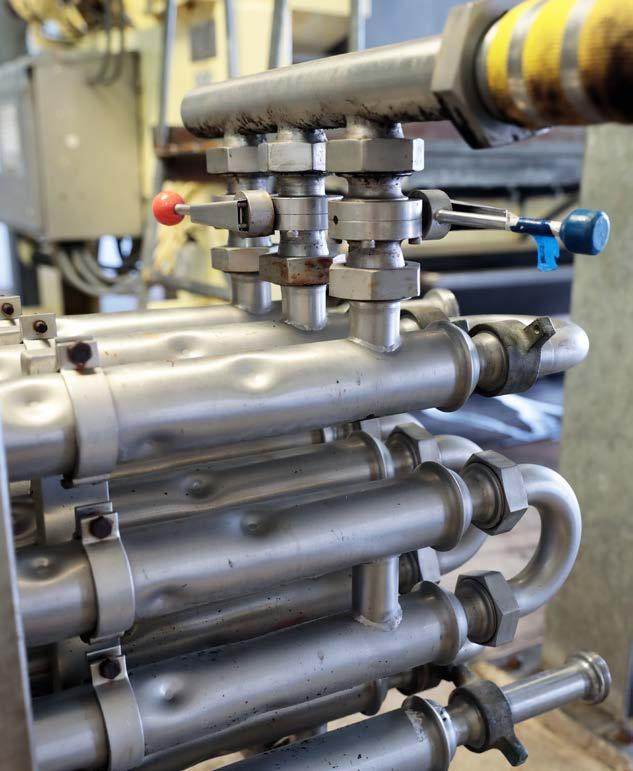
When we talk about reverse osmosis (RO), we really need to ask some pertinent questions in order to focus our attention on its worthiness as an alternative to other filtration options.
Who are the current contractors and to whom do they provide their services – particularly for alcohol reduction? Importantly, the external view of this process also needs some strong consideration, e.g. what are the consumer impressions of reverse osmosis?
Recently I spoke with winemaker/owner and avid wine consumer Phil Rogers from Caught Red Handed winery in McLaren Vale about the consumer expectations of RO.
“Firstly, most wine drinkers I speak with about this say they view RO treated wines as somewhat of an unnecessary artefact, or at least an afterthought,” he offered.
Rogers went on to explain that consumers think of these wines as somehow ‘less authentic’ or ‘doctored’ when compared to untreated wines.
“However, if RO gives drinkers a broader ‘sweet spot’ on the palate, with less of a ‘porty’ mouthfeel, then that’s a good thing,” he added.
The currently-circulating wisdom on this issue is complicated. A commonly held belief is that, although wine customers can’t necessarily tell if a wine has been RO treated, they can certainly identify wines as being over ripe, jammy or ‘hot’ and therefore those which might benefit from RO treatment.
One Riverland company I came across is currently using a CAT pump as part of an RO system. These systems have been utilised widely in the New Zealand and Australian wine industries for some time. The Riverland based winery pumps early-stage wine through a very fine membrane to remove the permeate. CAT pumps are ideal for this kind of work. Usually, a system of in-line pumps are
set up, having been specifically designed for RO. This set up of pumps removes the permeate, principally to change the wine’s composition by reducing alcohol without have any deleterious effects on final quality and flavour.
VAF Memstar is an Australian based company with a history in the
At A Glance
Some potential advantages of reverse osmosis include:
● No heating of the wine
● Preserving desirable flavours
● Minimal losses
● No water additions
● Flexibility for VA reduction
● Possible smoke taint removal
● Flavour concentration
52 Grapegrower & Winemaker www.winetitles.com.au March 2023 – Issue 710 winemaking
Filtration
…If RO gives drinkers a broader ‘sweet spot’ on the palate, with less of a ‘porty’ mouthfeel, then that’s a good thing.
Phil Rogers
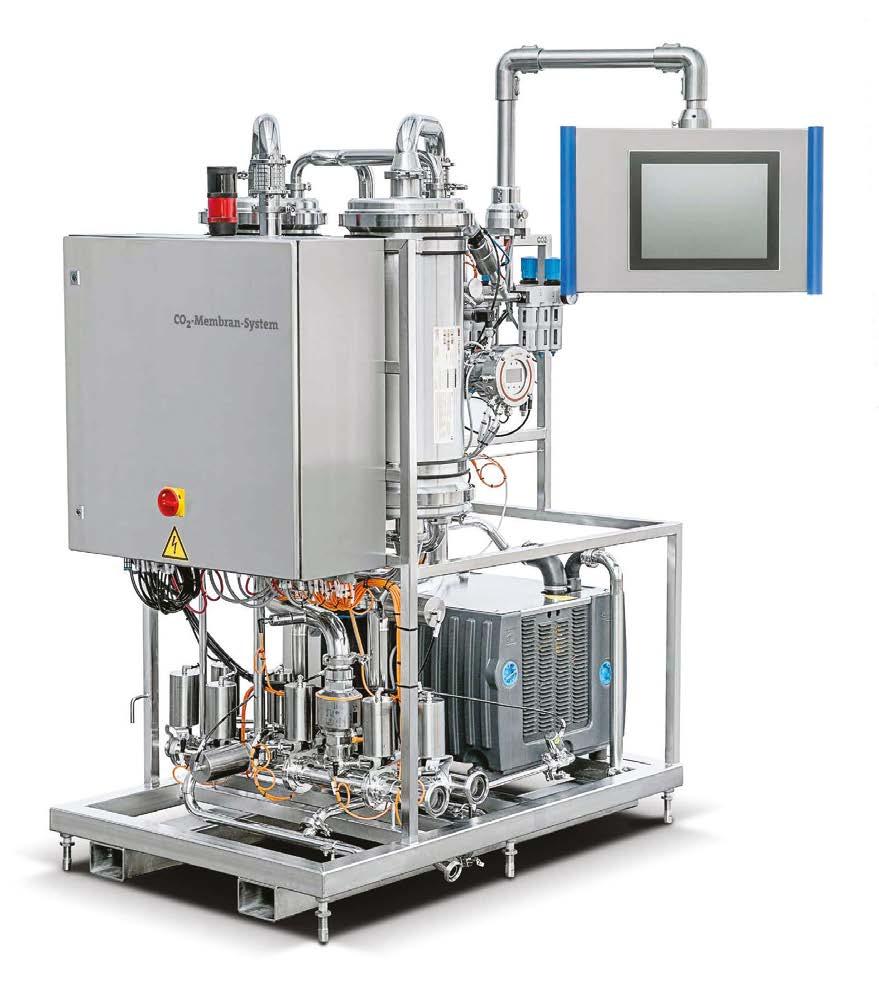

March – Issue 710 www.winetitles.com.au Grapegrower & Winemaker 53 CO2 Membrane System Visit website http:// www.vafmemstar.com.au T: +61 (0)8 8562 1139 Mail: info@vafmemstar.com.au Our distributor in Australia The professional ways of adjusting CO2 andO2 in beverages. • CO2 adjustment in white & rosé wine • Carbonation for sparkling wine • Removal of oxygen in red wine

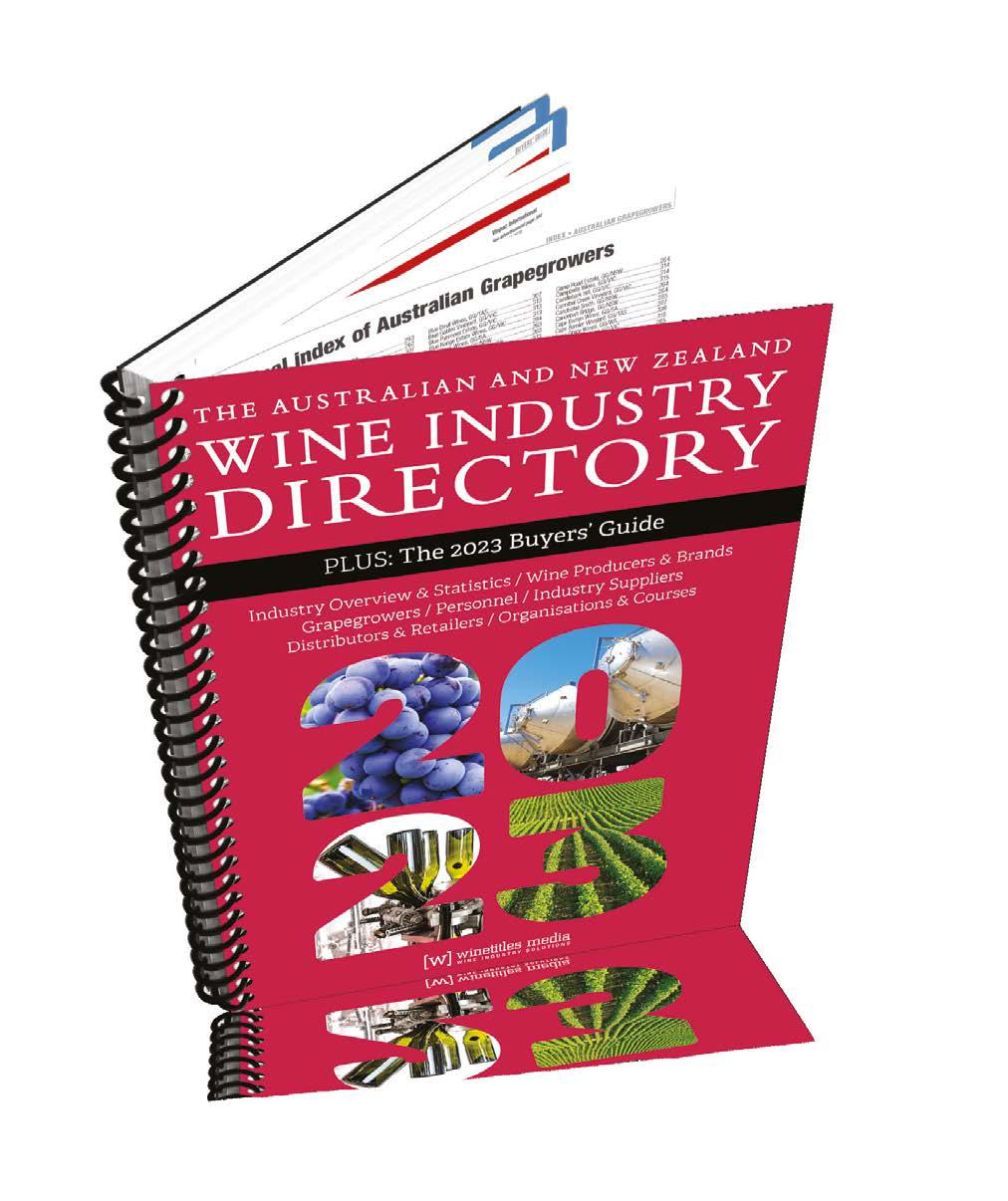
54 Grapegrower & Winemaker www.winetitles.com.au March 2023 – Issue 710 THE AUSTRALIAN AND NEW ZEALAND WINE INDUSTRY DIRECTORY Directory for winery profiles, locate vineyards and consultants in your area, or identify potential new customers. Buyers’ Guide makes it easy to find the suppliers and service providers to assist your Directory provides the most current and comprehensive access to wineries, growers, wine and grape industry professionals, products and services across Australia and New Zealand at your fingertips. for the wine industry and its suppliers OUT Available NOW! — both print and online winetitles.com.au | +618 8369 9500
RO equipment can even be rented or leased here in Australia, as an alternative to the high capital cost of purchase.
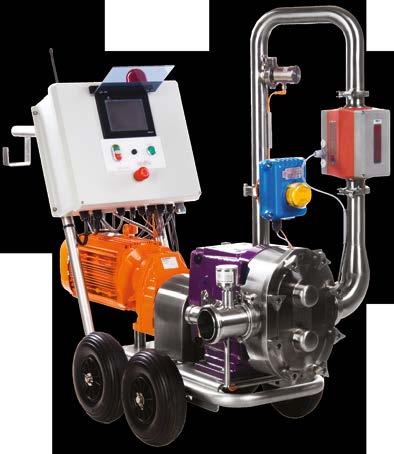
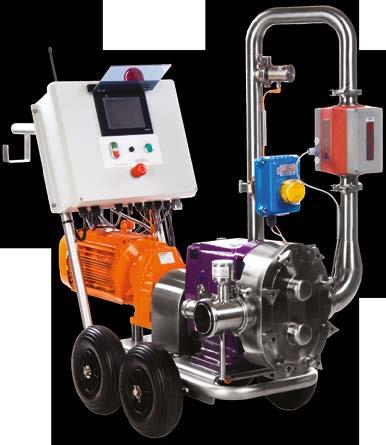





treatment of wine to reduce alcohol using an ethanol reduction process. The VAF Memstar website cites flexibility to rent, lease or outright purchase equipment as a key advantage. Another alternative is to simply have them perform the work on site for you as I (collaboratively) did recently with two different vintages of Merlot. Both wines were jointly processed down to their sweet spot of between 13.6%-13.8% alcohol. The tasting bench of five industry personnel all agreed the treated wines had more ‘finesse’, ‘balance’ and ‘harmony’. Tasting notes also indicated their greater suitability for wine and food matching rather than as a ‘stand-alone’ drink.
out of the wines principally because they were now ‘unmasked’ by higher alcohol (14.7% before treatment).
Casella Family Brands has been successfully using RO following trials starting in 2015. They employed the process not only for alcohol reduction but to produce ‘brighter’ wines, to reduce/ eliminate Brettanomyces infections and to achieve lower volatile acidity (VA).
Trials of smoke taint removal were also initiated on the Yellow Tail range. Casella is now the largest winemaker of exported product in Australia, proving RO is suitable for all sized producers. Production amounts to around 140 million bottles per annum or a staggering 55 containers leaving the site to supply the world market, on a daily basis.
The Cellar-Mate can’t make the coffee.
The Cellar-Mate can’t make the coffee...
RO equipment can even be rented or leased here in Australia, as an alternative to the high capital cost of purchase. The NSW-based company RO Rentals offers small, medium and large throughput machines which can be tailored to suit a wide range of filtration volumes. Another company offering alcohol removal systems is US-based Wine Secrets. Their two-stage system firstly produces a permeate of water and alcohol. That permeate is then distilled in a continuous column condenser in the second stage.
There is a better way!
Call us to arrange a demo Telephone 03 9455 3339 Fax 03 9459 5232
The RO filtration operates at the nano membrane level and is capable of treating flow rates between 500-21,000 per hour. Other advantages of RO include: no heating of the wine; preserving desirable flavours; minimal losses; no water additions; flexibility for VA reduction, smoke taint removal, Brett removal and flavour concentration.
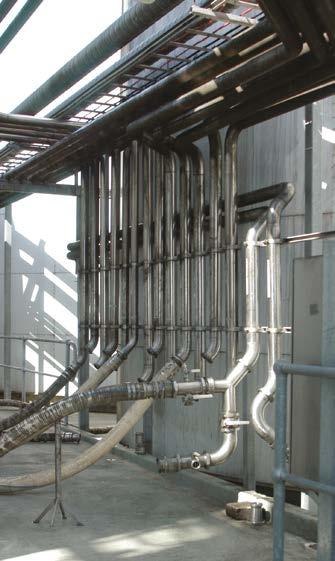
rapidfil@ rapidfil com au Web: www rapidfil com au
’t make the coffee.
The Cellar-Mate
c make the coffee.
There is a better way!
There is a better way!
There is a better way!
03 9459 5232 Email: rapidfil@ rapidfil com
9455 3339 Fax 03 9459 5232 Email: rapidfil@ rapidfil com au Web: www rapidfil com au
Telephone 03 9455 3339
9459 5232 Email: rapidfil@ rapidfil com au Web: www rapidfil com au
the coffee. Call us to arrange a demo
Call us to arrange a demo
coffee. Call us to arrange a demo Telephone
9455
3339
03 9455 3339
Fax
Web: www rapidfil com au
March – Issue 710 www.winetitles.com.au Grapegrower & Winemaker 55 winemaking Telephone
Fax
au
03 9455 3339
03 9459 5232 Email: rapidfil@ rapidfil com
Web: www rapidfil com au
Call us to arrange a demo
Fax
But it can automatically fill tanks, rack tanks, fill barrels, empty barrels, prepare blends, fill tankers, feed filters, carry out pump overs, fill flex containers... com au Web:
Telephone 03 9455 3339
03 9459 5232 Email: rapidfil@ rapidfil
www rapidfil com au
There is a better way!
Fax
au Web:
But it can automatically fill tanks, rack tanks, fill barrels, empty barrels, prepare blends, fill tankers, feed filters, carry out pump overs, fill flex containers... au
The Cellar-Mate c make the coffee.
www rapidfil com
There is a better way!
Call us to arrange a demo Telephone
But it can automatically fill tanks, rack tanks, fill barrels, empty barrels, prepare blends, fill tankers, feed filters, carry out pump overs, fill flex containers au
The Cellar-Mate
c
03 9459 5232 Email: rapidfil@ rapidfil com
There is a better way!
But it can automatically fill tanks, rack tanks, fill barrels, empty barrels, prepare blends, fill tankers, feed filters, carry out pump overs, fill flex containers...
Cellar-Mate c
Fax
9459 5232 Email: rapidfil@ rapidfil com au Web: www rapidfil com au
The
make
Telephone 03
03
There is a better way!
But it can automatically fill tanks, rack tanks, fill barrels, empty barrels, prepare blends, fill tankers, feed filters, carry out pump overs, fill flex containers...
Cellar-Mate c make
The
the
03
The
Call us to arrange a demo Telephone 03 9455 3339 Fax
But it can automatically fill tanks, rack tanks, fill barrels, empty barrels, prepare blends, fill tankers, feed filters, carry out pump overs, fill flex containers...
Cellar-Mate can’t make the coffee...
03
The Cellar-Mate can’t make the coffee... Call us to arrange a demo Telephone 03 9455 3339 Fax 03 9459 5232 Email: rapidfil@ rapidfil com au Web: www rapidfil com au
But it can automatically fill tanks, rack tanks, fill barrels, empty barrels, prepare blends, fill tankers, feed filters, carry out pump overs, fill flex containers...
But it can automatically fill tanks, rack tanks, fill barrels, empty barrels, prepare blends, fill tankers, feed filters, carry out pump overs, fill flex containers
Email:
There is a better way!
But it can automatically fill tanks, rack tanks, fill barrels, empty barrels, prepare blends, fill tankers, feed filters, carry out pump overs, fill flex containers
Call us to arrange a demo
Sensory elements
In particular, I noted an increase in regional ‘earthiness’ and other desirable characters such as a more balanced palate structure. These sensory elements came
Amphorae in vogue
A pure form of expression in winemaking
With great leaps in winery technology happening every year, some winemakers are looking to the past to find the future of their craft. Harrison Davies dives into the reasons some winemakers are reaching for amphorae to up their ante in the cellar.
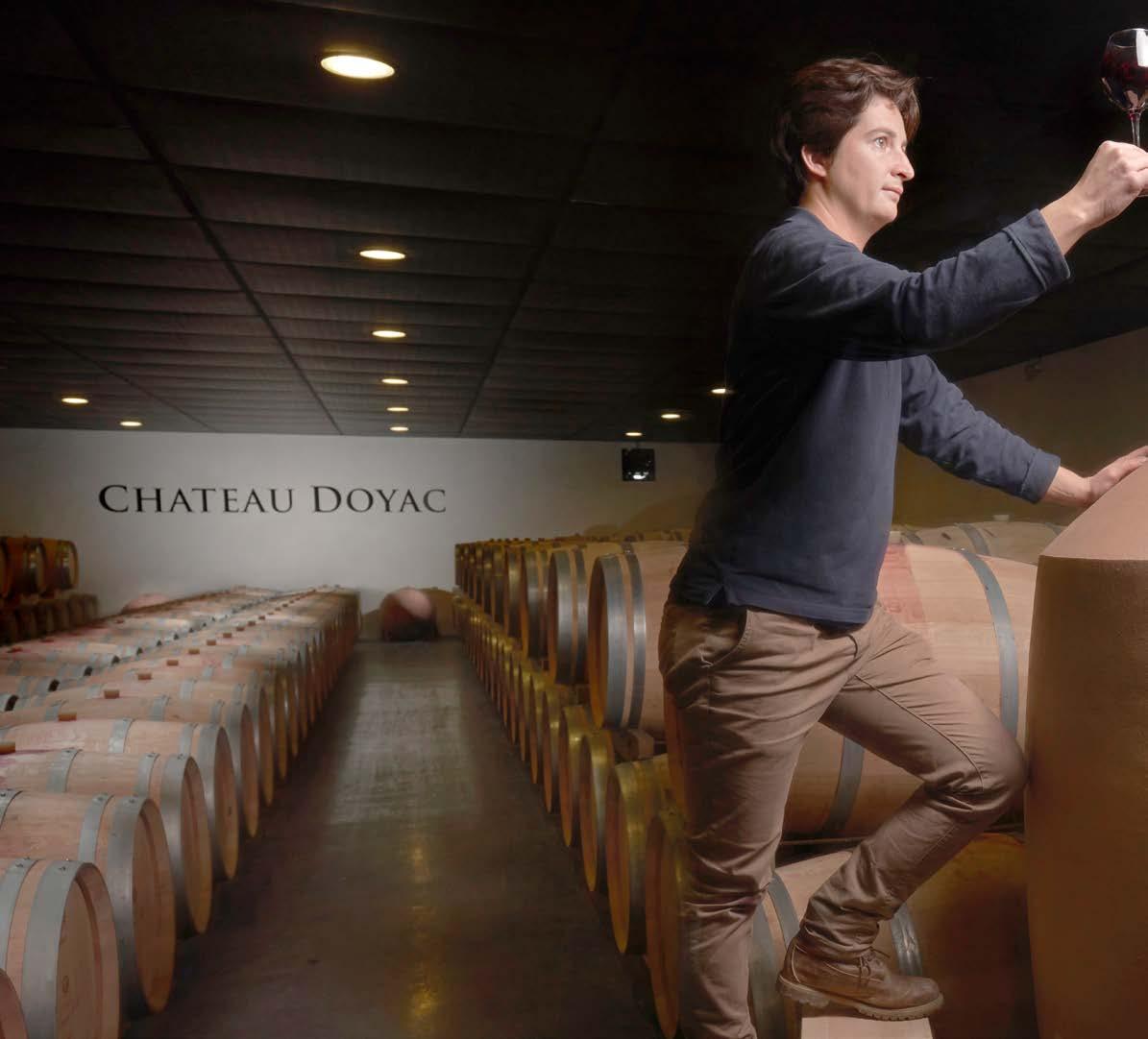
Artificial intelligence, automated tractors and computer powered grape presses. All of these are just a taste of the technological innovations that the industry is seeing come to the fold.
But amid all this innovation, it seems many winemakers are looking to roll back the clocks and adopt more ancient technology in their cellars.
Late last year, the Grapegrower & Winemaker held a winery equipment survey to see what industry players had their eyes on for their own wine producing businesses and the results showed a lot of interest in early technology, particularly amphorae.
56 Grapegrower & Winemaker www.winetitles.com.au March 2023 – Issue 710 winemaking
Photo: Bouchard Cooperages
Amphorae, of course, are terracotta vats used to age wine and bring their own set of tasting notes and flavours to a wine that cannot be emulated using other techniques.

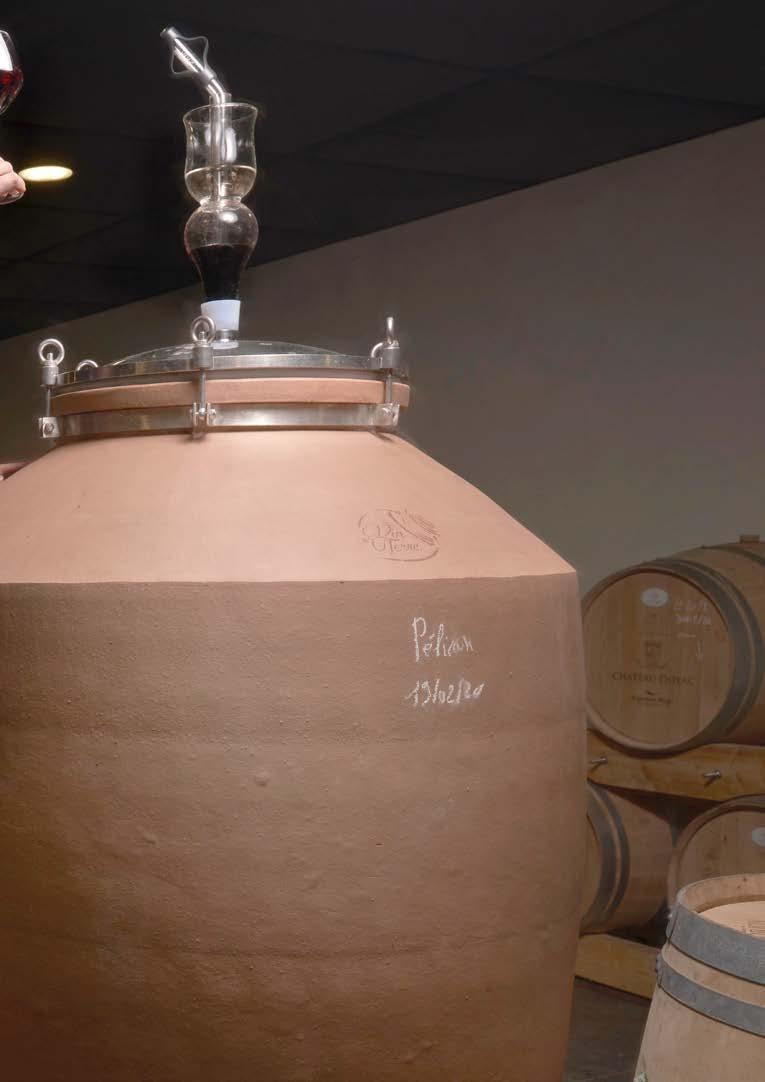
One such producer was Ashleigh Seymour, chief winemaker at Paxton Wines in McLaren Vale.
Old dogs and new tricks
Seymour explained that amphorae brought such a different feeling to the wine and offered consumers with something different, apart from the regular Cabernets and Shiraz that every winery produces.
“I worked with them in the previous winery I worked for in Italy with quite
a lot of success. Just something I want to introduce to Paxton where I work now; as much as with any organic and biodynamics base we’re seen as sort of old school.
“[We’re] just trying to mix it up a bit and appeal to a bit of a different demographic as well.”
She said that they allowed winemakers to shine a spotlight on the grapes themselves and that there were no fancy tricks that the producers could hide behind.
“Obviously the clay vessel does have some organoleptic effect on the wine, like a barrel might or some other kind of container,” she said.
“I feel that it allows the winemaker, if you’re not really doctoring the wine with
March – Issue 710 www.winetitles.com.au Grapegrower & Winemaker 57
AUS: 1800 127 611 E: info@kauriwine.com NZ: 0800 528 749 W: www.kauriwine.com
Natural is not really the right word, just letting the wine be itself and having a bit less influence as the winemaker in terms of processes and attitudes and things like that. Just letting the wine go and do its own thing.
Ashleigh Seymour
any other additives or things along the way, it really allows the grape to come through into the wine.
“I just feel like there’s a little bit more life, a little bit more tension. The wines don’t feel same-same and Coca Cola-ish.”
Interest in amphorae seems to mirror growth amongst the low intervention wine market, which has seen a fairly rapid rise over the past few years.
The trend is not limited to Australian and New Zealand winemakers either, with producers in Old World markets like Portugal adopting the practice as well.
Speaking at the SIMEI conference in Milan last November, La Vigna International Library professor Attilio Scienza said amphora were more than just a way to store wine.
“The amphora was not only the first container, but also one of the first marketing tools for wine, with the inscriptions that represented the merchant and the shape that revealed its origin,” he said.
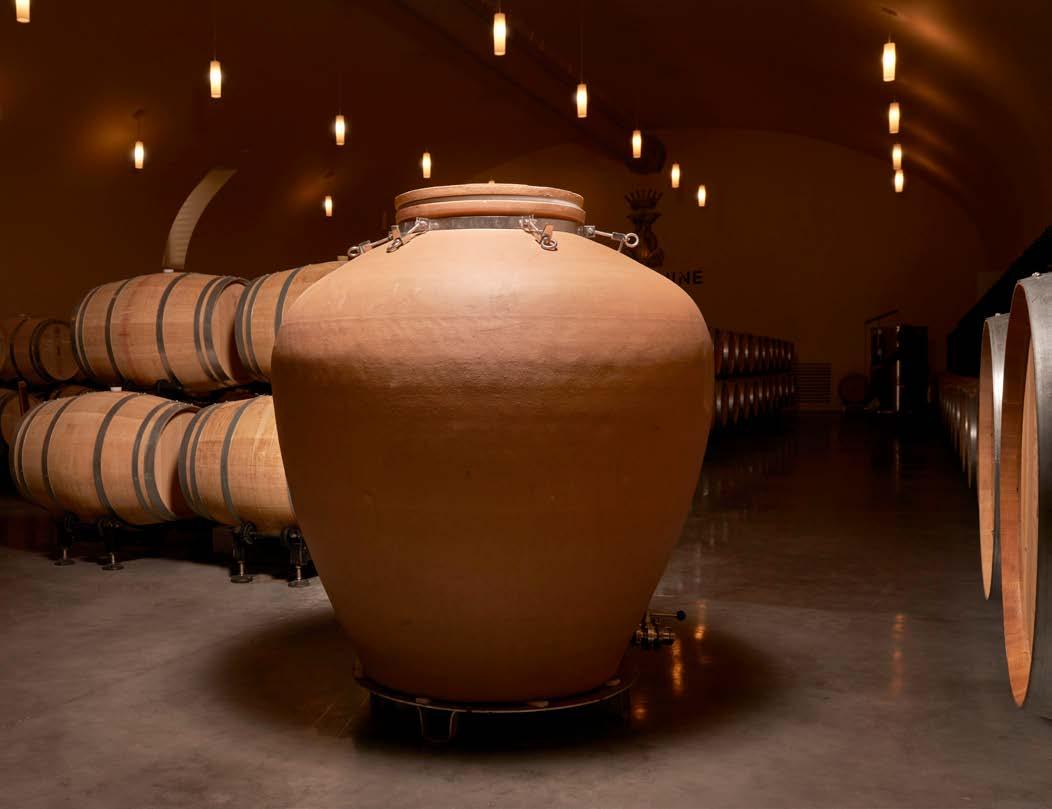
“The amphora represents an icon, the image of a place or an object that is fixed in our memory and that transforms the landscape into a momentum, activating a process of synaesthesia.
“Hence, the visual stimulus of the amphora is associated with the sensations of wine and the desire to repeat the taste experience, turning it into an aesthetic expression.”
A link with place was also noted by producer Elena Casadei, who for years has been investing and experimenting in this field.
58 Grapegrower & Winemaker www.winetitles.com.au March 2023 – Issue 710 winemaking
The demand is indeed increasing very much since there is an increasing demand for wine without ‘make up’ and amphorae can play an important role in this.
Emanuel Van Melkebeke
Photo: Bouchard Cooperages
She suggested that amphora could help producers express the terroir of their wines in a more holistic way.
“The amphora represents the return to the land after processing in the cellar. A container that, like a loudspeaker, echoes the quality of the grapes we put in it,” Casadei said.
Seymour said that she thought it was more than a natural wine phenomenon that was creating interest in terracotta vessels.
“I think it’s mostly just about mixing it up and going back to the future,” she said.
“I think a lot of people do it for different reasons. Natural is not really the right word, just letting the wine be itself and having a bit less influence as the winemaker in terms of processes and attitudes and things like that. Just letting the wine go and do its own thing.”
Amphorae have reportedly been gaining popularity in recent years and for a variety of reasons.
A low-fi approach
Barrel, oak and tank consultant and Australian director of Bouchard Cooperages, Amber Glastonbury, said that interest in amphorae had grown in recent years.
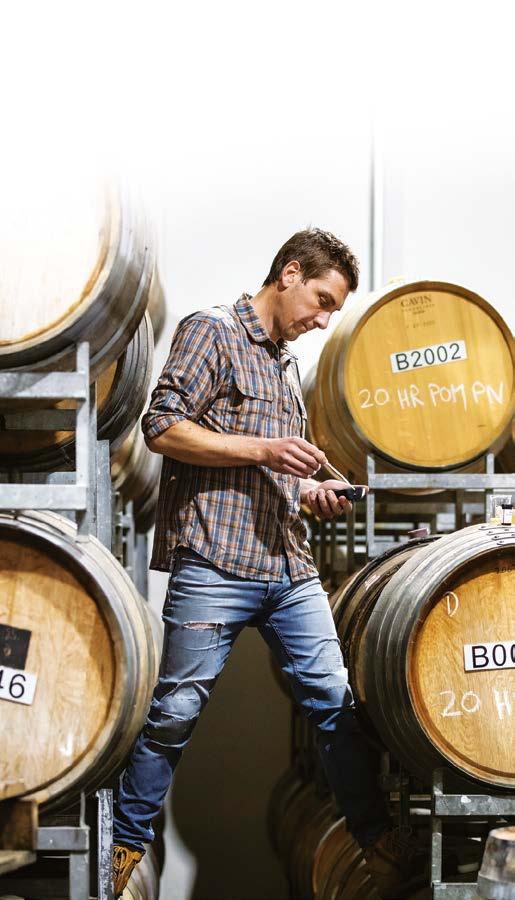
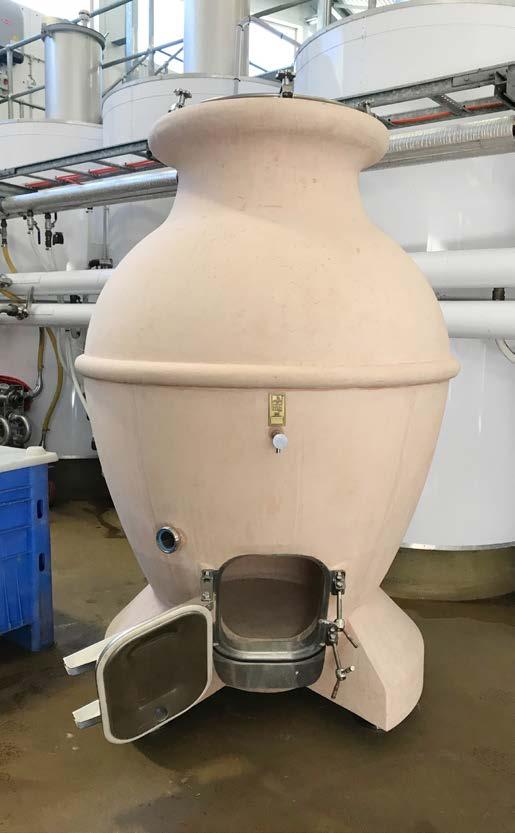
The most convenient wine analysis tool available.
tests available
SPECIAL LIMITED TIME OFFER
Receive a free case, stylus and lanyard valued at $88 with every Sentia and four vials of tests purchased. Offer ends 30th April 2023.
As world leaders in biosensor technology, our reputation is built on precision.
That’s why you can trust the Sentia™ hand-held wine analyzer to reliably measure:

• fructose and glucose (NEW)
• free SO2
• malic acid
Test results in minutes, wherever and whenever you need them.
For more information, call 03 9555 5500 or sentia@grapeworks.com.au
March – Issue 710 www.winetitles.com.au Grapegrower & Winemaker 59
Glucose&
Fructose
winemaking
“We started with one or two suppliers and there were a few people interested. But it’s definitely grown a lot and the interest has really grown,” Glastonbury said.
“A lot of people are asking for a lot more information and now we’re starting to actually get budget together and start purchasing out as well. So it’s been really interesting to watch.”
Glastonbury thought that the reason for this increase in interest was tied mostly to winemakers seeking to make new styles of wine and that amphorae could provide new techniques.
“I think it’s about a different style of wine,” she said.
“I think people are wanting to drink brighter, fresher wines and I think the amphora really allows the wines to express varietals and vineyard characteristics without imparting flavour or tannin.
“I think it’s more about the wine style that people want to drink now.”
Winemakers are looking at older methods of winemaking simply because they work without the tricks and thrills offered by newer technology.
Despite being an older form of winery tech, amphorae have benefitted from modern techniques, which provide better, more consistent results.
The Hungarian Amphora Project is an amphora maker based in Hungary that sells to Australian suppliers like Kauri.
Founder and co-owner Emanuel Van Melkebeke said the clean flavour terracotta provides a big incentive for winemakers and that his business had been amping up production.
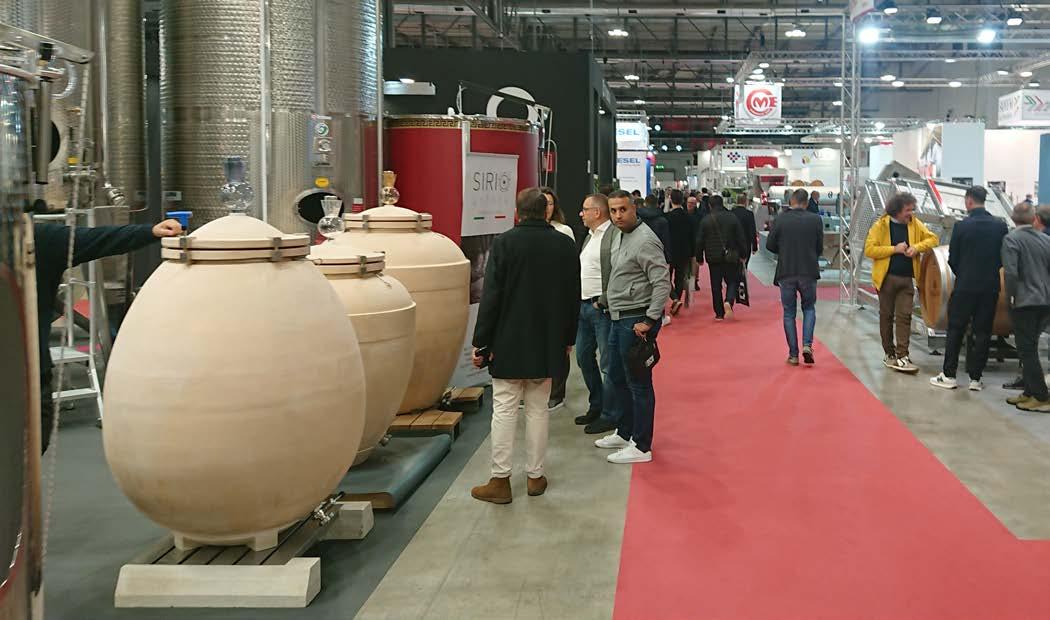
“The demand is indeed increasing very much since there is an increasing demand for wine without ‘make up’ and amphorae can play an important role in this,” he said.
“The techniques improved a lot since we use better, professional kilns and scientific data to come to a better result.
“The amphorae give wines in a pure form. Tradition and science can work together.”
Seymour added that ancient techniques like using amphorae were a way for winemakers to achieve different styles without taking on the massive cost of new systems.
“I also think it’s obviously a bit of a marketing image kind of thing as well,” she said.
“It’s an expensive hobby to make wine in amphorae in terms of the vessels themselves, but over time, they don’t really cost any more than anything else.
“There’s obviously more labour and things involved because they’re generally smaller vessels, but that as well I think it was phased out for more practical reasons, I suppose then organoleptic reasons.”
Glastonbury mirrored Seymour’s thoughts and said that the demand toward amphorae was simply because they work.
“It’s a natural product that we’re dealing with and it just works with the wine,” Glastonbury described.
“There are a number of different reasons people are using these: porosity levels for the different vessels; they contribute a high porosity level which will soften the tannins in the backfield, whereas low porosity holds attention and focus in the wild. So there are a lot of different variations in the different products.”
60 Grapegrower & Winemaker www.winetitles.com.au March 2023 – Issue 710
Visitors to SIMEI 2022 in Milan inspect amphorae on display
Behind the Top Drops
Dal Zotto Col Fondo Prosecco
The Dal Zotto family has been championing Italian varieties for several decades, none more so than Prosecco. Winery founder Otto Dal Zotto planted the King Valley’s first Prosecco vines in 1999 and in so doing became the pioneer of the variety in Australia. Releasing its first Prosecco in December 2004, Dal Zotto is undoubtedly a national trailblazer for the bubbles and currently produces five styles, among them the Col Fondo Prosecco made in the traditional Italian style.
Sonya Logan asked Michael Dal Zotto to shed some light on the wine, which received 95 points in the 2022 Halliday Wine Companion.

March – Issue 710 www.winetitles.com.au Grapegrower & Winemaker 61
The variety seems to have found its home here in the King Valley and is one of the more agreeable varieties from a viticultural perspective.
Michael Dal Zotto
Before we look specifically at the Col Fondo, briefly summarise Dal Zotto’s history with Prosecco:
Dal Zotto first planted Prosecco in the King Valley at our Cheshunt vineyard in 1999, finally fulfilling a dream of our father to grow Prosecco here in Australia. In 2004 we released Australia’s first Prosecco.
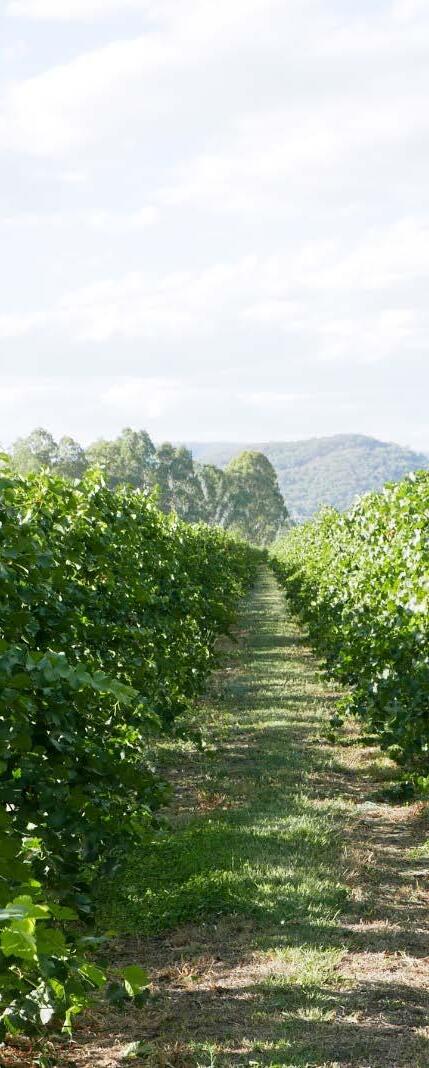
Our initial planting of Prosecco was approximately 375 vines which would have been less then an acre of vineyard. This has now grown to over 25ha. Plus, we also purchase fruit from a number of local growers.
We initially sold the wine exclusively through cellar door and then grew this out into the national market. The first Prosecco we released was a bottle fermented Prosecco, which was then followed by the NV Prosecco made in the Charmat method. From this point we have introduced a number of different Proseccos. The vintage Prosecco, Col Fondo Prosecco and the Col Fondo Tabelo Prosecco make up the five-strong range of Proseccos that we make today.
As the campaign continues against the attempt by the European Union to ban Prosecco being used by Australian producers, to what degree, if any, has New Zealand’s recent agreement to protect the use of the name affected Dal Zotto?
As we currently don’t export to New Zealand, not a great deal.
When did Dal Zotto release the first Col Fondo Prosecco?
2010
What prompted the making of that wine?
While on my fellowship in Italy studying Prosecco I was helping my cousin during vintage process some fruit. At the end of the day we were sitting around enjoying a glass or two of wine and he produced a bottle of wine which he decanted into a jug. I asked him what this was and he said, Prosecco. I questioned this and he replied, Col Fondo. So, when I returned home I mentioned this style of making Prosecco to [my brother] Christian and we decided to make our own.
Where was the fruit for that first wine sourced? Were they company-owned vineyards or contract growers?
The fruit was sourced from our vineyard in the King Valley. Has there been any deliberate changes to the fruit sources over the years?
We have always made the Col Fondo Prosecco from our Cheshunt vineyard. We have always felt it best displays the characters we are after in the fruit to give us the wine we are after.
Tell us about the vines currently used to produce the Col Fondo Prosecco?
The area of vines is approximately 3ha at our Cheshunt vineyard. The clone we use is the Delcin clone. Soil is a heavy grey clay over gravel. Rows are spaced 2.8m apart and the vines 1.8m apart. The vines were originally planted in the late ‘90s and were grafted across to Prosecco in 2004. The vines are arch-cane pruned which helps to achieve consistent crop load and maintain quality year in year out. Due to the openness of
62 Grapegrower & Winemaker www.winetitles.com.au March 2023 – Issue 710 winemaking
The Dal Zotto vineyard at Cheshunt, in Victoria’s King Valley, is the source of grapes for the Dal Zotto Col Fondo Prosecco.
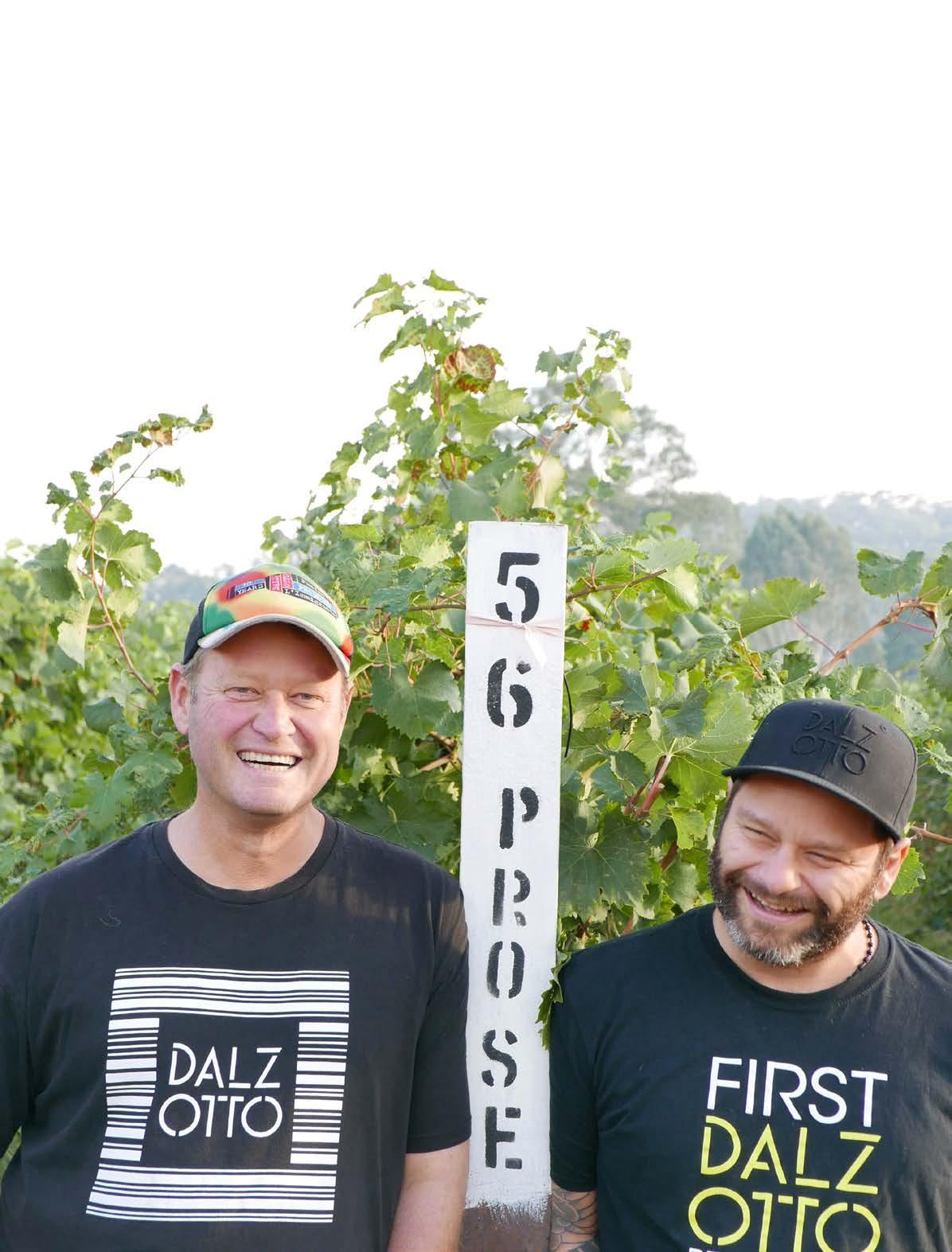
March – Issue 710 www.winetitles.com.au Grapegrower & Winemaker 63
Due to the nature of the wine as it ages it continues to evolve. Early after initial release it is quite fresh and vibrant with searing acidity but as it ages the secondary ferment characters develop to give more of a savoury structure.
Michael Dal Zotto
Michael and Christian Dal Zotto.
winemaking
the canopy and the large open bunches we don’t tend to need to bunch thin or leaf pluck.
The variety seems to have found its home here in the King Valley and is one of the more agreeable varieties from a viticultural perspective. When the fruit is ready, which will be anywhere between 9.5 to 10.5 Baume, it is machine harvested.
Describe the current winemaking process that brings the wine to fruition, from picking through to bottling?
Fruit is machine harvested between 9.510.5 Baume. It is top loaded to a press and allowed to drain prior to the press cycle starting. Once the cycle commences we press to approximately 600-650L/t and then switch to a pressing tank. At the completion of the press cycle the juice is floated, racked and then fermentation is initiated, all within a 12-18 hour period.
The ferment tends to run between 14-18°C. The temperatures are adjusted as the fermentation progresses to ensure it is a reasonably controlled ferment. Once ferment is complete we add sulfur and bentonite, settle then rack. We cold stabilise the wine in preparation for tirage.
The base wine then goes through a secondary ferment in bottle and is typically held for nine months prior to release.
Due to the nature of the wine as it ages it continues to evolve. Early after initial release it is quite fresh and vibrant with searing acidity but as it ages the secondary ferment characters develop to give more of a savoury structure. Have the winemaking practices changed over the years?
Over the journey the only things to have changed are the Baume at which we harvest as we now harvest some of the fruit at a lower Baume and we also hold on lees for nine months before release rather then six months.
What does the Col Fondo process bring to the wine and how do the wine’s characteristics compare to Dal Zotto’s other Proseccos as a result?
This wine tends to have a creamier bead
along with a tendency to display some savoury notes compared with other Proseccos which are typical Proseccos displaying delicate floral notes and primary fruit.
Has the style of the Dal Zotto Col Fondo Prosecco evolved since the inaugural release?
In a general sense, no. The wine has changed from year to year with vintage variation, but the underlying characters are the same: citrus, ginger, apple and toast almonds, great acidity and dry finish.
Biggest challenge in making this wine?
The fact that each bottle is unique. The wine is typically the same from bottle to bottle but there is the odd bottle that may have stopped early leaving the wine slightly sweeter.
What’s the recommended retail price of the Col Fondo Prosecco?
$30/bottle
Most notable accolades?
Halliday Wine Companion - 95 points
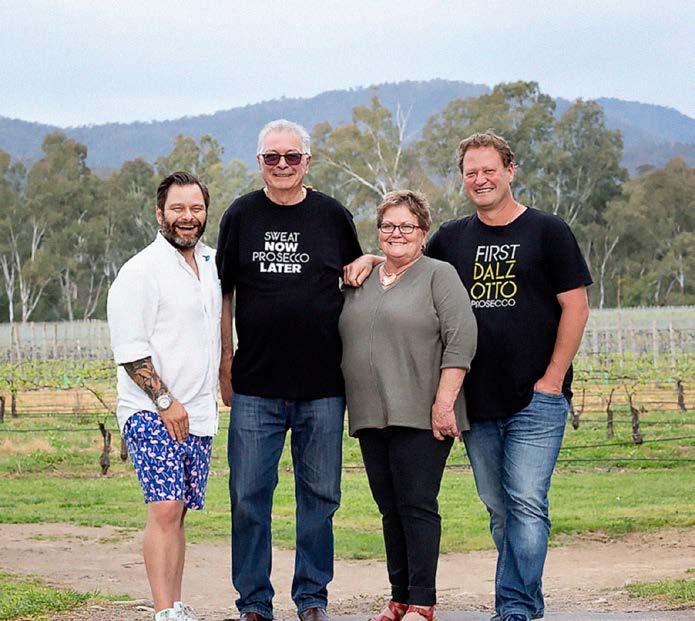
Best vintages?
2010 (our first release), 2018 and 2019
Recommended food pairings?
Hard cheeses and salumi
Where does the Col Fondo Prosecco fit within Dal Zotto’s other Prosecco offerings?
The Col Fondo sits between our L’immigrante Prosecco and our Tabelo Col Fondo which is Col Fondo made using the most traditional of methods.
This wine has grown in popularity over the years. It has been particularly well received within bottleshops nationally and by the visiting customer to cellar door. Visitors are always surprised to see a Prosecco made in a style other than Charmat.
64 Grapegrower & Winemaker www.winetitles.com.au March 2023 – Issue 710
Otto and Elena Dal Zotto and their sons Michael and Christian pioneered Prosecco in Australia, planting it in 1999 and releasing the first vintage in 2004. The Dal Zotto family today produces five different Proseccos, including the Col Fondo which goes through a secondary ferment in bottle and isn’t disgorged.
YOUNG GUN Tash Arthur
Melding old with new
Tash Arthur is plotting her own course through the wine industry by flagrantly ignoring trends and making wines that she wants to drink. Arthur is the embodiment of what makes Australian wine unique and provides an alternative voice to the medium bodied wine drum that is being beaten across the country. Harrison Davies spoke with her about her career and her label.
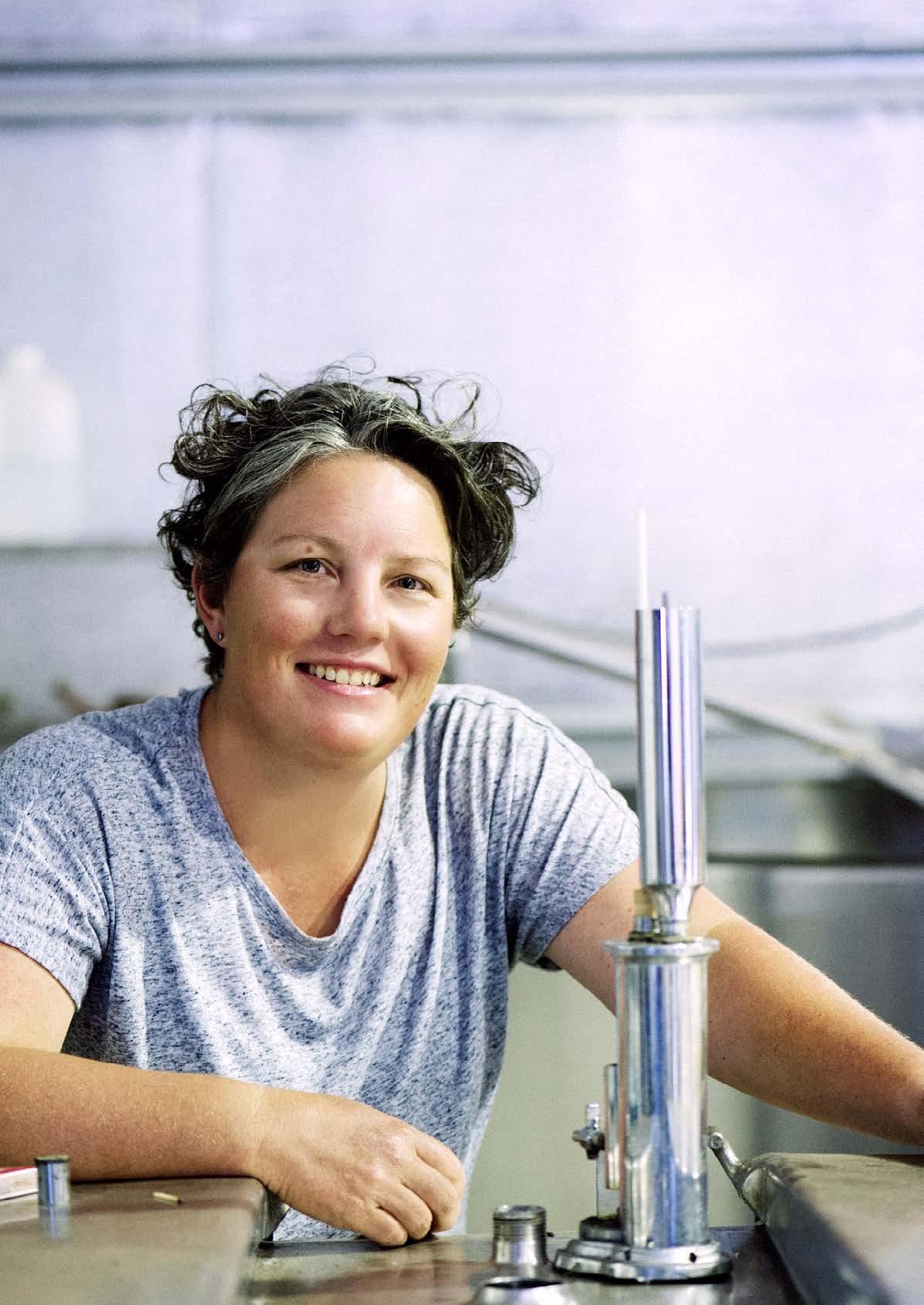
winemaking
Medium bodied wines. Alternative varieties. Lowintervention, natural wines. These are the trends fuelling thousands of young winemakers across Australia. However, they are not what is fuelling Tash Arthur.
Arthur’s label, the aptly named Arthur Wines in Margaret River, is one of the only labels in the country that specialises in and exclusively makes fortified wines. Running her winemaking operation out of her family’s cattle farm, Arthur Wines became a way for Arthur herself to make the wines she always enjoyed more than anything else.
Her flair for winemaking began during her tenure as a nurse, toward the beginning of her career. Weekly knockoffs soon became an all-encompassing passion for wine.
She soon found herself working vintages in Rutherglen and finding a taste for richer flavours.
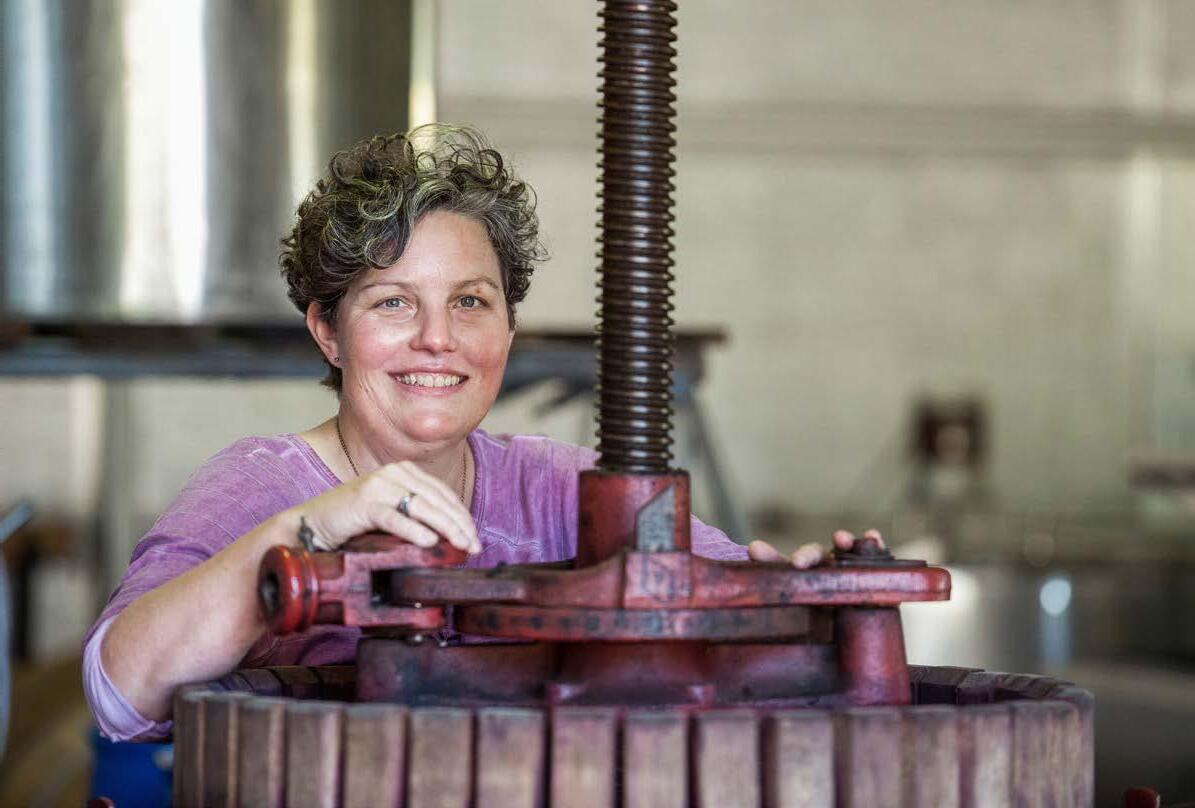
“I worked for a few different wineries. I worked for Amberley here in Margaret River when that was still in operation. Then I went over to Rutherglen and worked for Chambers for a couple of years,” she said.
“I loved fortified so that was the obvious place to go to, to learn to make them. And then family reasons kind of brought me back to WA.”
She found herself back in the West, working part time as a nurse and making wines with McHenry Honen and getting frustrated that she couldn’t make what she really wanted, fortifieds.
She eventually started tinkering in different styles of fortified and trying different varieties before breaking out on her own and starting Arthur Wines.
CHEERS TO THAT!
66 Grapegrower & Winemaker www.winetitles.com.au March 2023 – Issue 710
They’re just the absolute gems and they’re very undervalued. And I thought, well, you know I can just have a little niche and make the wines that I love.
Tash Arthur
The label came into being as a way for her to focus solely on the style she loved and she hasn’t looked back since.
“There are so many different types of fortifieds, and especially if you do the Rutherglen wine show, the judging, people can’t wait for the fortified masterclass,” she said.
“They’re just the absolute gems and they’re very undervalued. And I thought, well, you know I can just have a little niche and make the wines that I love.
“I’m just experimenting with different styles. The biggest hurdle is getting people to not think of them as a Nana drink and making them a bit more hip and a bit more refreshing.”
Going her own way
Arthur prides herself on trying new things in a style that is defined by Australian winemaking from decades ago.
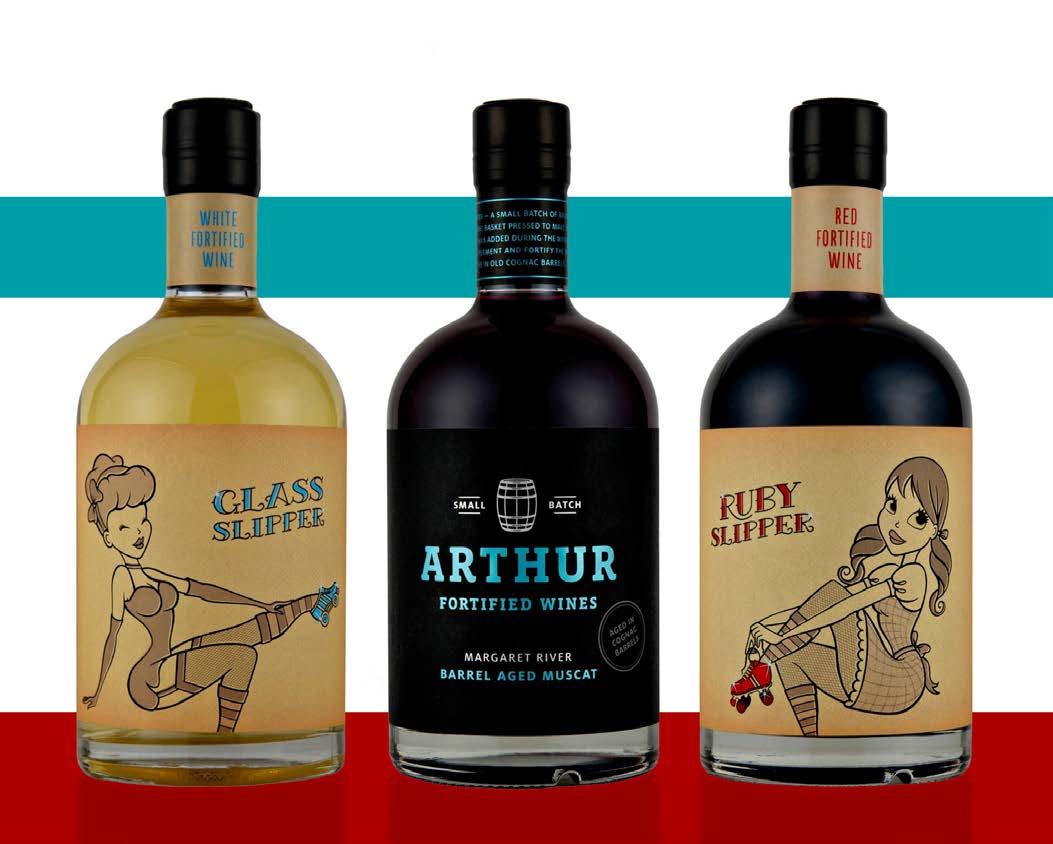
She said she is fascinated by making fortified wines with many different varieties and discovering new flavours. She took inspiration from a vintage she worked in Portugal, where the ports they were making encompassed a wide range of flavours and textures.
She reflected on the ports she had made with white varieties in Portugal and how they influenced some of her winemaking back here in Australia.
“I’ve tried to make a style similar to [the white ports] more like an aperitif but not a sherry or an Aperol,” she said.
“I’ve made a pink fortified which is pretty unusual, and then a ruby, which is an easy drinking style, and I’ve tried to package it as something different.
“Being in Margaret River I’ve got to work with Chardonnay – a fantastic grape variety and it makes a beautiful white
[fortified]. So I use Chardonnay and Chenin and sometimes Sauvignon Blanc because it’s so aromatic. It’s got some amazing flavours.
“I’ve just started getting into some Pedro from the Swan Valley. And we have a really great grower here in Margaret River who does Muscat.
“I’ve got growers that I’ve worked with for a number of years now and they’re very accommodating for someone who only buys small amounts at a time.
“I was looking for specific [varieties], I really wanted a Margaret River Muscat. So through a few contacts – everyone knows everyone in Margaret River –someone suggested I contact the grower that I use and they’ve been fantastic.
“They’re also a bass and sheep farmer as well as the vineyard. So we’ve got a lot in common.
March – Issue 710 www.winetitles.com.au Grapegrower & Winemaker 67
Arthur Wines fortifieds
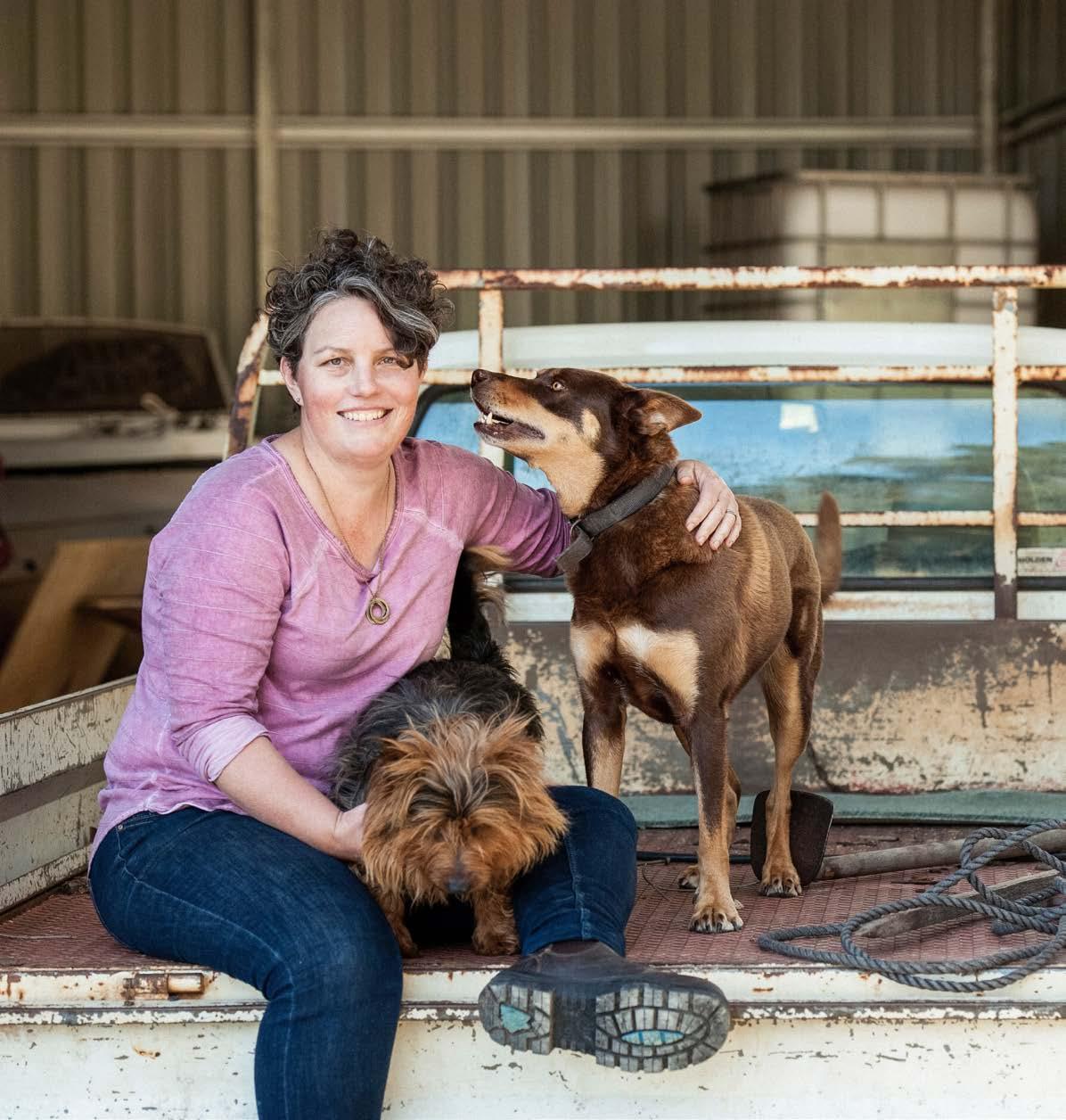
68 Grapegrower & Winemaker www.winetitles.com.au March 2023 – Issue 710 winemaking
The winemakers have a really good community and are great at sharing knowledge. In the wine industry, most people are willing to share their knowledge have a chat.
Tash Arthur
Arthur Wines winemaker Tash Arthur. Photos: Arthur Wines
“For other varieties, like the Pedro, I’ve had to look a little bit wider into the wine industry and see who knows who knows, who’s got what and where.”
Margaret River is home for Arthur and she said it was important that she make wines that were emblematic of her own home region.
She said the community was close and as a smaller producer it made it easier to source grapes and get help when she needed it.
“It’s a pretty tight-knit community,” Arthur said.
“The winemakers have a really good community and are great at sharing knowledge. In the wine industry, most people are willing to share their knowledge and have a chat.”
Part of the challenge for Arthur was to sell her fortifieds to a market that was gravitating toward them.
Without seven generations of winemaking behind her, she had to find a different way to get new consumers on board with her repertoire.

She created a series of unique labels for each bottle, alongside her brother-inlaw, to bring her 20th century style into the modern era.
“So my brother-in-law is very talented graphic designer and he designed all of our labels and they’re funky and they look a bit different,” Arthur said.
“I can’t compete with seven generations of winemakers in Rutherglen with a surname, it’s just not going to happen.
“All of our labels are funky and they look a bit different and so people can take it to a party and go ‘check out this label, check out this wine’ and it’s not a boring bottle.
“We’ve just tried to make them look a bit smarter. We give people opportunities to know when to drink wines like ours and also how to drink them because people just haven’t been exposed to them.”
She said consumers have warmed to the idea of fortifieds but a general knowledge of what they are still needed to be taught – many thought they were drinking gin.
Raising a brand and a family
Arthur began the label alongside her husband, Robert, a farmer, over 10 years ago. Now with three kids, the label has become a part of the family.
“He pretty much runs the beef and sheep farm, whereas I pretty much run the winery. We obviously help each other out with everything, but if it’s vintage, he’s in the winery; and if it’s shearing, I’m in the shed,” she said.
“It’s mainly just the two of us. We’ve got a group of people that we pull in for events, which are like our little family. And it’s great. We’ve got some really good people working with us and we’ve got three daughters who like to get involved.
“They’re six, eight and 10 at the moment and when it’s vintage, they’re over there and they’re shovelling grapes and washing up tanks and getting underfoot, but they love it.
“Hopefully, one of them might want to have a look at it in the future, and maybe continue on.”
While she has a lot of ambition for her label, she also acknowledged that making fortifieds is time consuming and said that she was interested in experimenting with more flavours and styles.
“With fortifieds everything takes a lot of time. It’s not like you can make that wine and turn it around within two years like a table red. So there’s a lot of planning for five to 10 years down the track,” she continued.
“We’ve got the Muscat Solera well and truly underway, we’ve got a Tawny Solera, the Pedro just started and the vintage Australian fortified is on its way.
“Eventually we’d like to get a bit of age on things in barrel before we release them.
“Just growing slowly at the moment, we don’t want to sell everything that we’ve got in the winery just yet. We want to let it get a bit of age and make a better product for our customers.”
March – Issue 710 www.winetitles.com.au Grapegrower & Winemaker 69
Renewed growth in wine and viticulture degrees provides industry optimism
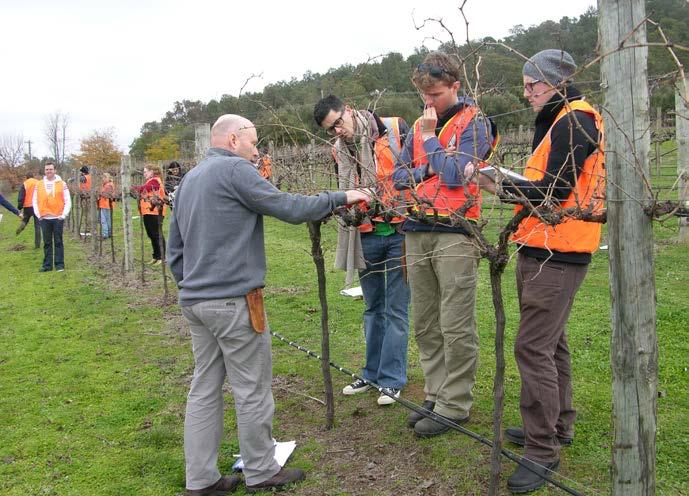
Could this provide a solution to industry’s long-term employment needs?
Finding the right employees to fill positions year round has been a significant challenge for wine businesses over the last few years – a problem that was only exacerbated by COVID measures. Harrison Davies spoke with professors and directors of wine industry degrees to see if the shortage of wine industry workers had spread to the student bodies of educational institutions.
Wine business have faced significant challenges in filling positions in wineries and vineyards, particularly over recent vintage harvesting periods.
This problem began several years ago but became much worse when the borders closed amid strict restrictions preventing the spread of COVID-19.
During this time, international working holiday workers were not available in the same numbers they had been historically, forcing wine businesses to make tough decisions about their vintage prep.
With COVID restrictions now largely in the rearview mirror and vintage employment once again beginning to be buoyed by international workers, the industry must ask itself if there is a systemic issue or if there has simply been a transitional period.
Worker shortages are not a unique challenge for the wine industry, in fact almost all industries in Australia and New Zealand have felt the squeeze of work vacancies.
This issue could have sunlight on the horizon, however, as there are encouraging signs coming from universities.
According to faculty at both the Adelaide University Business School, home of the Wine Business program, and the Charles Sturt University School of Agricultural, Environmental and Veterinary Sciences, admission to wine industry degrees is on the rise.
Wine-based degrees have experienced a swell in interest, particularly from age groups who began their studies during COVID restrictions.
Graduate [numbers] across all programmes are up compared to 2020.
Dr Armando Corsi
Strong online learning infrastructure meant that students looking to get involved in the wine industry could get straight into their studies regardless of where they were from.
Both Dr Armando Corsi, Associate Professor of Wine Business at Adelaide University, and Viticulture Professor of Viticulture, Chris Steel, from Charles Sturt University’s National Wine and Grape Industry Centre, reported that they saw an increase in student admissions to their respective courses over the last few years.
Strong interest in wine
Dr Corsi said that in Adelaide Uni’s Business School, and similarly in the School of Wine Business, the share of domestic students participating in the program had increased since 2020.
“Graduate [numbers] across all programmes are up compared to 2020. In Wine Business, there are large increases in the in the number of enrolments,” he said.
“[Among] things that have changed is that we have seen an uptake in domestic student enrolments. We did have an 85/15 split between international and domestic and I would say now we are around the 65/35 split again, international and domestic respectively.
“Compared to some of our key competitors around the world, other
70 Grapegrower & Winemaker www.winetitles.com.au March 2023 – Issue 710 business & technology
Education & Training
Viticultural Science students at Charles Sturt University.
Photo: Chris Steel
business schools around the world, particularly those based in France, we’ve been affected by the reopening process here in Australia.
“Because France reopened the borders much earlier than we did; if you were a student based in South-East Asia, and you have the option of another maybe six months living with your parents and learning about the business of wine from the room or being able to start spending your life in Burgundy, surely made that an attractive proposition.
“We really see students that are so eager to come back and just begin in the classroom and share the learning journey with their peers.”
Dr Corsi said there was considerable competition for wine business programs offered in other wine producing countries but that domestic interest in the area in Australia was strong.
Prof Steel mirrored many of Dr Corsi’s statements, mentioning that online learning made it much easier for local students to take part in Viticulture degrees offered at Charles Sturt.
“The COVID pandemic and the closure of the international borders did not affect the number of students commencing the viticulture degree at CSU greatly, indeed if at all,” he said.
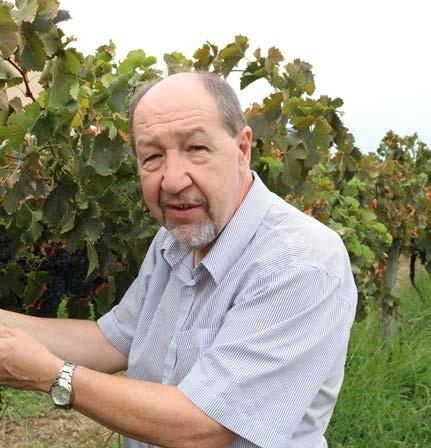
“The Viticulture and Wine Science related courses are largely only taught online. As CSU has been active in the online teaching space for many, many years, we were less affected by COVID than some of the other universities.
“Online students attend intensive schools, some of the practical activities associated with viticulture are taught at the intensive schools.
“Not just COVID, but also the recent floods over the last year affected the ability of some interstate domestic students to attend these intensive schools. Consequently, a small number of students have had to defer their intensive school attendance by a year.”
While there have been disruptions to the teaching at CSU, Steel said interest in Wine Science and Viticulture has increased when compared to previous years.
“The number of students commencing all the viticulture and wine-related courses at CSU were comparable during COVID and if anything, actually increased slightly,” Prof Steel continued.
“This was probably due to the fact that CSU was already very much geared up for online teaching. Plus, potential students were more likely to enrol in an online course during the COVID pandemic when they were either in lockdown or restricted by what social activities they could engage in.”
Growth in education and industry
Both Dr Corsi and Prof Steel were optimistic about what their respective university’s enrolment meant for local industry.
Dr Corsi said that recent trends indicating growth in student interest means growth for the industry.
“We’ve seen a demand, also some of the recent market research and what we believe to be some of the key countries of student intake would, in the next three to five years, show that there is growth,” he said.
“We feel positive, because we see that the ceiling could increase.”
Dr Corsi said that he and others within Adelaide Uni’s School of Wine Business were working to create content for students to learn about in order to best prepare them for an constantly evolving industry.
Prof Steel also said that the signs were good from the perspective of the Viticulture course at CSU and that the situation was moving forward nicely.
“While the numbers of commencing students for 2023 aren’t fully known at the time of writing, they appear to have returned to approximately the prepandemic level,” he said.
“Numbers commencing the Wine Science degree are typically double the number that commence the Viticulture degree and that is true for 2023.
“Many of the CSU students taking the Viticulture degree are mature age and are already working in the wine industry in some way. All students as part of their studies are required to complete an industry placement as part of their studies.
“CSU is in the process of setting up a global digital farm which will incorporate aspects of precision agriculture, smart technology and, potentially, robotics. This is in partnership with the Food Agility Co-operative Research Centre.”
Take your pick:
ROBUST DISTINCTIVE EARTHY
Describe your next hire the same way you’d describe your next wine.
CONNECTING YOU WITH WINE PEOPLE
March – Issue 710 www.winetitles.com.au Grapegrower & Winemaker 71
Photo: Charles Sturt University
SHARP GENEROUS VERSATILE
Selected Training Services providers in Australia and New Zealand
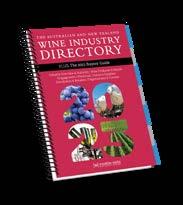
Wine Business Solutions
Tel: 02 9744 8332
W: www.winebusinesssolutions.com.au
Mediacom Australia
Tel: 02 9463 7173
W: www.mediacomeducation.org.au
University of Southern Queensland
Tel: 07 4631 2221
W: www.unisq.edu.au
Charles Sturt University
Tel: 1800 334 733
W: www.csu.edu.au
Wavemaker Global
Tel: 08 8366 4727
W: www.wavemakerglobal.com
Curtin University of Technology
Tel: 0401 103 877
W: www.curtin.edu.au
University of South Australia -School of Marketing
Tel: 08 8302 0600
W: www.unisa.edu.au/business
Agricultural Appointments
Tel: 02 9223 9944
W: www.agri.com.au
TAFE NSW - Northern Sydney Institute
Tel: 02 9448 6126
W: www.tafensw.edu.au/locations/western-nsw/dubbo
South Australian Wine Industry Assoc. Inc.
Tel: 08 8222 9277
W: www.winesa.asn.au
Bibber International
Tel: 08 8374 0077
W: www.grow-abroad.com
University of South Australia
Tel: 08 8302 0261
W: www.unisa.edu.au
University of Adelaide
Tel: 08 8303 7923
W: set.adelaide.edu.au/agriculture-food-wine
Eastern Institute of Tech Hawke’s Bay
Tel: +64 6 974 8000 (ext. 6022)
W: www.eit.ac.nz
University of South Australia Business School
Tel: 08 8302 0942
W: www.unisa.edu.au/business
KWPX Media
Tel: 08 8217 9125
W: www.kwpx.au
72 Grapegrower & Winemaker www.winetitles.com.au March 2023 – Issue 710
You can find Training services providers here. Did you know? The entire Australian & New Zealand wine industry in one book ORDER YOUR COPY: winetitles.com.au/WID or phone +61 08 8369 9500
2023 Wine Packaging Forum, Expo & Design Awards Supplement in Grapegrower & Winemaker
JULY 2023
An unmissable line-up of expert industry speakers share their knowledge and experience in the published Supplement in Grapegrower & Winemaker June issue and PACKWINE website
Source trusted industry suppliers to find out how they can help to improve your productivity and business growth

Discover new tech and sustainable product options Meet the innovative local suppliers who support your industry
View the entire field of striking entries that capture the Australian and New Zealand wine industry at its creative best.
Find out which packaging designs are among the year’s best by visiting the Design Awards presentation.
Presented by
March – Issue 710 www.winetitles.com.au Grapegrower & Winemaker 73
Grape price pressures add to growers’ woes
Price fluctuations not consistent across regions
A culmination of the issues and challenges to have battered the Australian wine industry over recent years reached fruition with downward or stagnant grape prices a feature of this past season. Harrison Davies asked industry stakeholders to outline the effects on producers and regions.
The January 2021 issue of the Grapegrower & Winemaker featured the stark words “Broken China” on its cover. More than two years later, grape and wine producers are still picking up the shattered pieces of what had been Australia’s most lucrative export market.
The punishing tariffs imposed by China on Australian wine exports have left the local industry in disarray. When combined with unseasonably wet conditions brought on by an extended La Nina weather event and a seeming multitude of other headaches plaguing growers across the country, there’s been a perfect storm to keep growers inundated, both metaphorically and literally.
Bulk winegrape prices are now bearing the brunt of these factors, particularly in warm inland re-gions, with many growers tossing up their options.

In Wine Australia’s quarterly Export Report, released in early February, it was revealed that Char-donnay had eclipsed Shiraz to become the most exported variety.
However the top variety being a white brings its own challenges.
The industry must solve three problems in the coming year: what to do about a lack of demand for bulk red varieties, what to do about the surplus of bulk red
wine, and how to manage the disease pressures threatening the remaining valuable varieties.
What to do about grapes
The primary issue facing regions is the lack of demand for red varieties, principally Shiraz, Cabernet and Merlot. The primary reason for the lack of demand is the surplus in red winegrapes and stored red wine caused by the collapse of the China market for Australian wine.
Associations and stakeholders across the three major inland regions – the Riverland, Riverina and Murray Darling – stated that the situation was indeed grim for growers.
“We’re getting prices as low as $200 a tonne for Shiraz. Most of the other [varieties] are a bit higher than that but that’s the lowest price around here,”
Riverina Winegrape Growers Association chief executive Jeremy Cass said.
“We were hoping the disease pressure would put upward pressure on prices, especially in whites, where we’ve lost a few varieties; we were hoping they’d see some prices increase a little bit but that really hasn’t happened as yet.”
Murray Valley Winegrowers chair Chris Dent said the situation in his region was similar, citing an extreme lack in demand for Shiraz, Cabernet and Merlot.
“We don’t understand what individual people are going through. But we understand it’s a challeng-ing time,” he told members via association publication MVW News & Views.
“Some wineries are having tough conversations with growers. I know some wineries are trying to renegotiate some
74 Grapegrower & Winemaker www.winetitles.com.au March 2023 – Issue 710 business & technology
We were hoping the disease pressure would put upward pressure on prices, especially in whites, where we’ve lost a few varieties, we were hoping they’ll see some prices increase a little bit but that that really hasn’t happened as yet.
Jeremy Cass
White varieties are reported to have the highest value going into vintage, but disease pressure has remained a heavy burden for many growers.
of the terms in the contract to reduce their exposure this year.
“They’re trying to give some incentives, [for] example they might try and reduce this year’s supply in return for an extra year on the end of their contract.
“Others are just straight out asking to reduce supply to less than what their contract says for vari-ous different incentives.
“Contracted supply is not a sure thing if a winery physically doesn’t have the room to take the fruit. There’s potentially going to be some below cost of production pricing coming out.”
The story in the Riverland was much the same as well, with CCW growers’ co-operative CEO Jim Godden describing prices as “depressed” in October last year.
Prices in the Riverina have been consistent among the major red varieties, and the prices there have reflected those across other inland regions.
White varieties were reported to have the highest value on average going into 2023, however the disease pressure remained a cloud over the heads of growers.
Major rain events and subsequent flooding placed considerable pressure on growers over the summer, despite some early hopes that the adverse growing conditions would actually help to raise fruit prices.
Instead it has only resulted in there being less of the most sought after, and therefore most valua-ble, varieties to sell.
“Things like Pinot Gris and Sauvignon Blanc seem to be the most in favour of the varieties and made up around about $500 a tonne,” Cass said.
“Most of the reds are $300 or in the sub $300 range and the [other] whites start at about $330 for things like Semillon and go up to, in some cases, $400 For Chardonnay.
“We were hoping the disease pressure would put upward pressure on prices especially in whites, where we’ve lost a few varieties, we were hoping they’d see some prices increase a little bit but that that really hasn’t happened as yet.
“Wineries are watching pretty closely to see what happens when the harvesters do move in and just see how close things are
going to come off. At this point in time, it’s very hard to get a handle on just how much we’ve lost until that does happen.”
Many estimates have been thrown around regarding the potential crop size this vintage – and the potential losses –across the warm inland regions.
Prior to the summer months, Riverland growers were offered compensation by Accolade Wines for the mothballing of up to 40 per cent of their vineyards – all
of which was offered prior to storms and wet weather affecting the region later in the year.
Cass said that crop losses in the Riverina, for those who went ahead to grow grapes, could be as much as 30-50 per cent depending on the amount of spraying that was done and how the vine-yards were impacted by flooding.
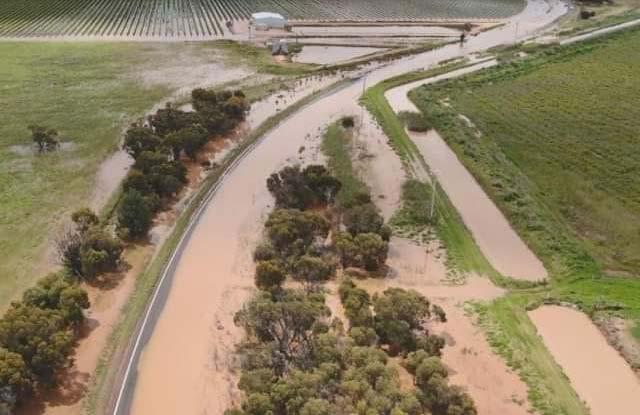
While some vineyards were completely flooded, others were more impacted by
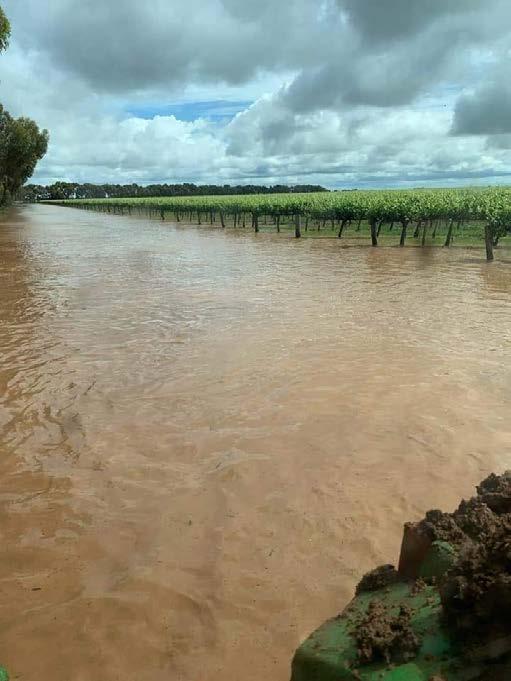
March – Issue 710 www.winetitles.com.au Grapegrower & Winemaker 75
Parts of the NSW Riverina were heavily impacted by wet conditions and flooding in the lead up to vintage.
disease due to operators not being able to get out into the vineyard and spray when the time was right.
Cass explained that the approach to this vintage was very much ‘a mixed bag’ in the Riverina.
“We have got some growers that right from the outset, decided that they weren’t even going to try and grow grapes this year,” he explained.
“They’ve managed it several different ways to try and get through the year and to then bring them back into production in the next year.
“We have seen some growers also exit the industry. So we’ve seen some substantial sized plant-ings have actually been pushed out.
“Other guys have gone right to the other extent, there have been some guys out there that have been diligently spraying nearly on a weekly basis to try and keep the disease under control.
“Those guys have been hoping that their efforts would be rewarded and through the losses of others they might get a bit of a price rise, but that hasn’t been the case at this stage.
“And even the most diligent of growers at this stage have just lost some of their fruit, although they might have only lost 10-15%.”
Dent in the Murray Valley, a grower himself, said decision making at the start of the season was challenging as growers wanted to prune their losses.
“It was a strange decision to make but I’ve been comfortable with it ever since. We’re not seeing any relief from the freight issues or oversupply. With the pricing that has been bandied around, it feels like I’ve made the right decision,” Dent said.
“I made the decision pretty early and had the discussion with the winery I was contracted to. I was thinking it was in my best interest but obviously it was helping them out because they’re not sure they can take everything anyway.”
It is worth mentioning that while the inland regions continue to struggle with low value grapes, premium regions are largely unaffected.
Margaret River saw a rise in value for its top varieties, Cabernet and Chardonnay, with Cabernet in particular observing an increase in value of roughly 3%.
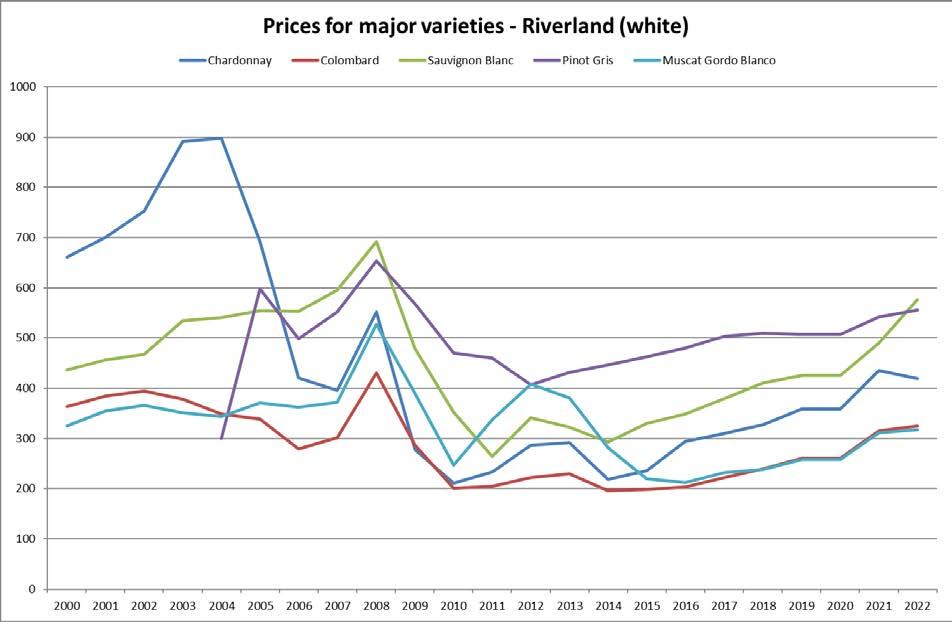
76 Grapegrower & Winemaker www.winetitles.com.au March 2023 – Issue 710
It’s compounded with some other factors like the global shipping crisis which means that wineries are chock-ablock full. They can’t fit the next vintage in.
business & technology
Chris Dent
Prices for the major white winegrape varieties in the Riverland. Source: Austwine
Prices for the major white winegrape varieties in the Riverland.
Source: Austwine
Prices for the major red winegrape varieties in the Riverland.
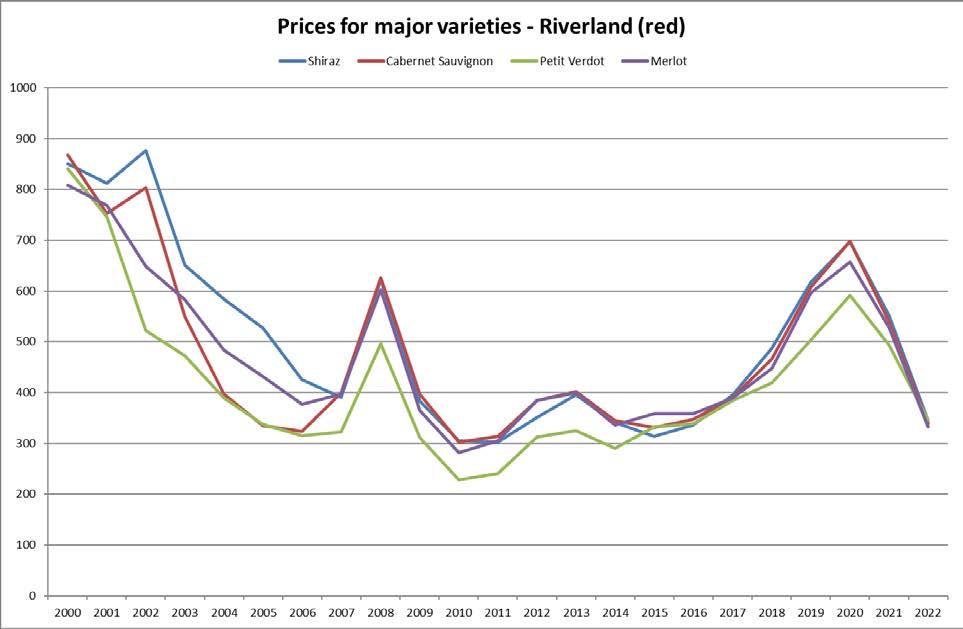
Source: Austwine
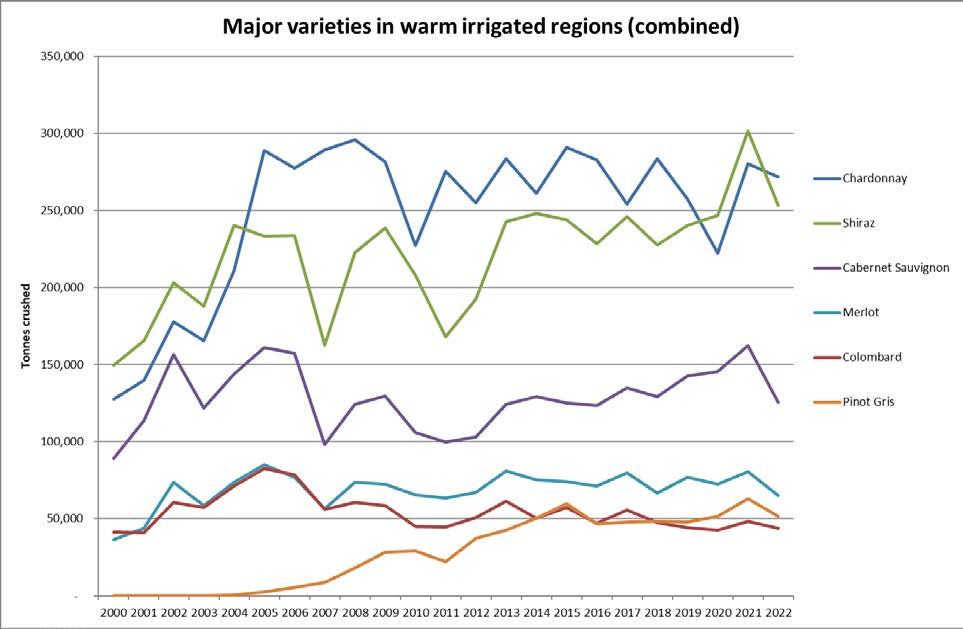
March – Issue 710 www.winetitles.com.au Grapegrower & Winemaker 77
Margaret River Wine Association CEO Amanda Whiteland said that forces influencing the value of winegrapes in other regions had not directly affected Margaret River producers in the lead up to 2023.
“Like last year, there is strong demand, particularly for the Chardonnay, Sauvignon Blanc and icon reds,” Whiteland said.
“More vineyards in the region are now contracting their fruit for a number of years, reducing the grapes for sale on the bulk market.
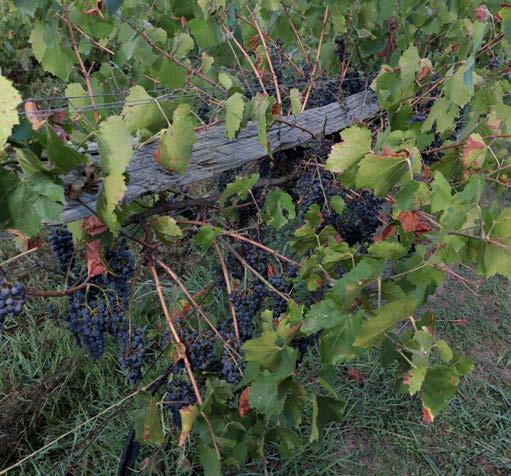
“In 2022 the average price per tonne in Margaret River, Cabernet Sauvignon increased 3% to $1,965 and Shiraz increased 8% to $1,419
Continuing excess of wine
A glut of leftover red wine remains the largest downward pressure on winegrape pricing.
The result of this glut has meant that Australian winegrapes are seeing low demand.
In Ciatti’s global market report for January, the group recognised a series of cold, wet summers in Australia as well as a surplus of wine from previous vintages as being the major factors contributing to pricing.
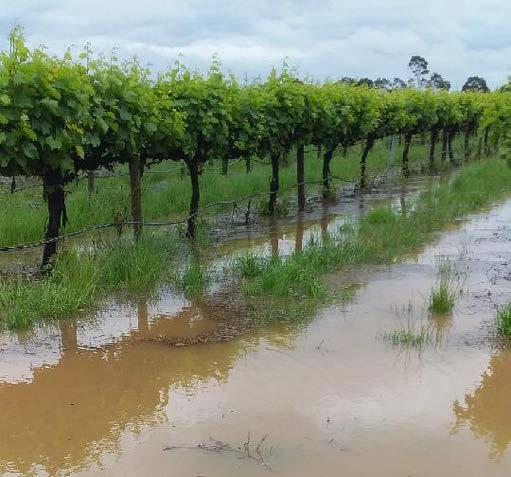
Conversely, due to the surplus of red wine, the group identified Australia as
“the most price-competitive red wine supplier in the world” and described prices for major varieties like Shiraz, Cabernet, Merlot as well as a generic dry red as “aggressive”.
“Australia expects another sluggish year for sales as suppliers continue to move slowly through large inventories of red wine,” the report stated.
“Restricted tank capacity and the lack of sales to China will lead to a larger volume of red grapes being left on the vine this year as wineries attempt to reduce their intake of material.
“A significant reduction in red winegrapes coming from the 2023 crop is required for the industry to ‘reset’ and move towards a balanced supplydemand ratio.
“The further softening of prices for red material has not necessarily resulted in a sale of stock, as we see buyers/ importers struggling with shipping constraints, gas and glassware shortages, and price hikes in general amid the inflationary pressure.”
The Ciatti report also referenced the fact that almost every other wine producing country in the world could supply a demand for red wine, creating a daunting task for Australian wine sellers look-ing to offload some of the surplus.
“I can’t see any spot market activity that’s going to be happening,” Dent said.
“It’s compounded with some other factors like the global shipping crisis which means that wineries are chock-ablock full. They can’t fit the next vintage in.
“When they’re prioritising what varieties they do and can take into their winery, obviously they’re going to put more emphasis on the things they know they can sell, which are mainly white varieties and some less mainstream red grape varieties.”
Cass said that growers looking to put fruit up for sale following the vintage may turn a loss due to the high costs of sprays, logistics and handling.
“I think the other thing to note is that you know that the guys that really did try to put on a lot of sprays, a lot of those sprays have been fairly expensive,” he said.
“I would suggest that there’ll be some guys out there that won’t make the returns at all to satisfy the cost of production for this year. So they’ll come away with a net loss.
“Unfortunately, that was to be expected by the outlook that we were given by the wineries. But yes, it’s just a tough space to be in at the moment.”
78 Grapegrower & Winemaker www.winetitles.com.au March 2023 – Issue 710 business & technology
Wet conditions across inland Australia could result in some winegrape producers in the Riverina losing 30-50 per cent of their crop.
Some Riverina vineyards were affected by flooding following heavy rainfall.
Endeavour Group appoints new chief financial officer
Harrison Davies spoke with incoming Endeavour Group CFO Kate Beattie about her new appointment.
Endeavour Group Limited has announced Kate Beattie will be appointed as chief financial officer (CFO) from 26 June 2023 as current CFO Shane Gannon steps back from executive roles.

Beattie has held finance leadership roles within Woolworths and Endeavour Group for the past five years, commencing as finance director for the retail drinks division of Woolworths, prior to becoming interim CFO of Endeavour Group, leading preparations for its demerger, and deputy CFO following the demerger.
While with the Group she has also led the BWS retail business as interim managing director.
Prior to joining Endeavour Group, Beattie had spent 20 years in roles across retail, technology, banking and professional services in blue-chip ASX-listed and international companies such as Commonwealth Bank, Macquarie Bank and Oracle.
She has worked across all stages of the company life cycle including start-up, rapid growth, restructure, merger and demerger.
Beattie said she was looking forward to being at the centre of the company’s growth and seeing the company interact with social moments across the country.
“We know Australians are inherently social people, and we are firmly focused on giving our customers great value products, offerings and experiences to suit all occasions. In doing so, we will keep providing good returns for our shareholders as well,” Beattie said.
“Importantly, I also look forward to working alongside CEO Steve Donohue and our team of senior leaders to ensure Endeavour Group is a leader in responsibility across all its businesses, whether that relates to the responsible service of alcohol, addressing modern slavery, or the role we play in communities more broadly as an employer and producer.”
In her role with Endeavour Group, Beattie has overseen the purchases of premium wineries from across Australia
to be brought within Endeavour Group’s ‘Pinnacle Portfolio’. Since demerging from the Woolworths Group, Endeavour has bolstered its presence in the production side of the drinks industry.
Beattie said these acquisitions were an indicator of the company’s growth and also its strength in the market.
Winery acquisition
“Recently we announced our acquisition of Cape Mentelle, which will shortly join the Paragon Wine Estates stable of brands,” she said.
“We are really proud to be the custodian of some incredible Australian wineries and wine brands, and while we now feel we have a strong portfolio of brands in each of the key winegrowing regions across the country, we always pay close attention to what’s happening in the market.
“I think there is a really significant role for the Australian drinks industry to play in being an advocate for homegrown producers, not just in Australia, but overseas too, and that’s something top of mind for us as we look to the future.
“Above all else, as an industry, we have an important role to play in keeping people connected, and at Endeavour we are focused on creating a more sociable future, together.
“This positions us well to navigate future challenges, as humans are social beings, and in uncertain times connection is more important than ever.”
Beattie and Gannon will continue to work together as deputy CFO and CFO respectively over the coming months, ensuring a smooth transition.
“I am thrilled to be taking on the role of CFO of Endeavour Group, a company that has proven its resilience and potential for growth since its demerger,” Beattie said.
“I would like to thank Shane for his leadership and wise counsel over the last two years, and I look forward to this new challenge.”
Gannon will finish at Endeavour Group in June, concluding a decorated career
across multiple industries and public companies, including Mirvac Property Group, LendLease, Goodman Fielder and CSR.
“Today’s announcement is a testament to both Kate and Shane and their executive leadership in establishing Endeavour Group as a standalone company,” Endeavour Group CEO and managing director Steve Donohue said.
“I would like to pay special tribute to Shane Gannon for the enormous contribution he has made to the company, bringing his wealth of experience during such a formative period, embedding best-inclass strategy, governance and fostering an exceptional culture.”
“I feel incredibly fortunate to have spent the past two years at Endeavour Group: a company that has weathered the pandemic well and has a bright future ahead due to the exceptional calibre of its 30,000 people working across its extensive portfolio of stores, hotels, wineries and specialty businesses. I look forward to watching Endeavour go from strength-tostrength in the months and years ahead,” Gannon said.
March – Issue 710 www.winetitles.com.au Grapegrower & Winemaker 79
I think there is a really significant role for the Australian drinks industry to play in being an advocate for homegrown producers, not just in Australia, but overseas too.
Kate Beattie
Incoming Endeavour Group CFO Lauren Beattie.
Photo: Abril Felman
A glass act
As premiumisation continues to be a trend in wine markets globally, there is growing demand for packaging products that can lift product appeal and help bottles stand out from their competitors. One unique approach is sourced from a manufacturer using a material for closures not generally associated with wine bottles at all.
The region of Bohemia, located in the Czech Republic near the German and Polish borders, is famously known for its luxury glass and crystal products made in a relatively small area known as ‘Crystal Valley’. While the area’s manufacturers are best known for high-end glassware and jewellery, one producer has become ensconced as a supplier of glass closures for wine bottles. Radan Haiblik, from Vinolok, says that glass had long been used to close bottles but that historically the material didn’t allow for effective sealing. This was far from ideal for the packaging of wines that require hermetic conditions to maintain product quality and integrity. Haiblilk explained that this was eventually overcome by adding sealing rings using newly available materials.
Although the product has been available for nearly two decades, demand for it has been growing quickly as more producers
embrace more alternative solutions for packaging.
“It was first introduced in 2003. Basically, the idea behind this closure was to offer an alternative material for wines because at that time, people were complaining about TCA and the problems associated with spoiled wines. So there was always a though about alternative materials for winemakers and [our] idea was glass,” Haiblik said.
He explained that the glass product was initially started purely as a technical closure for wine, but under the influence of the local Bohemian jewellery industry, design too became a focus of the product and the bottles it would fit.
Because we are from the jewellery industry – for example, Swarovski comes from our town before they moved to Austria some time ago – we use a lot of techniques and we developed also the design side of the closure.
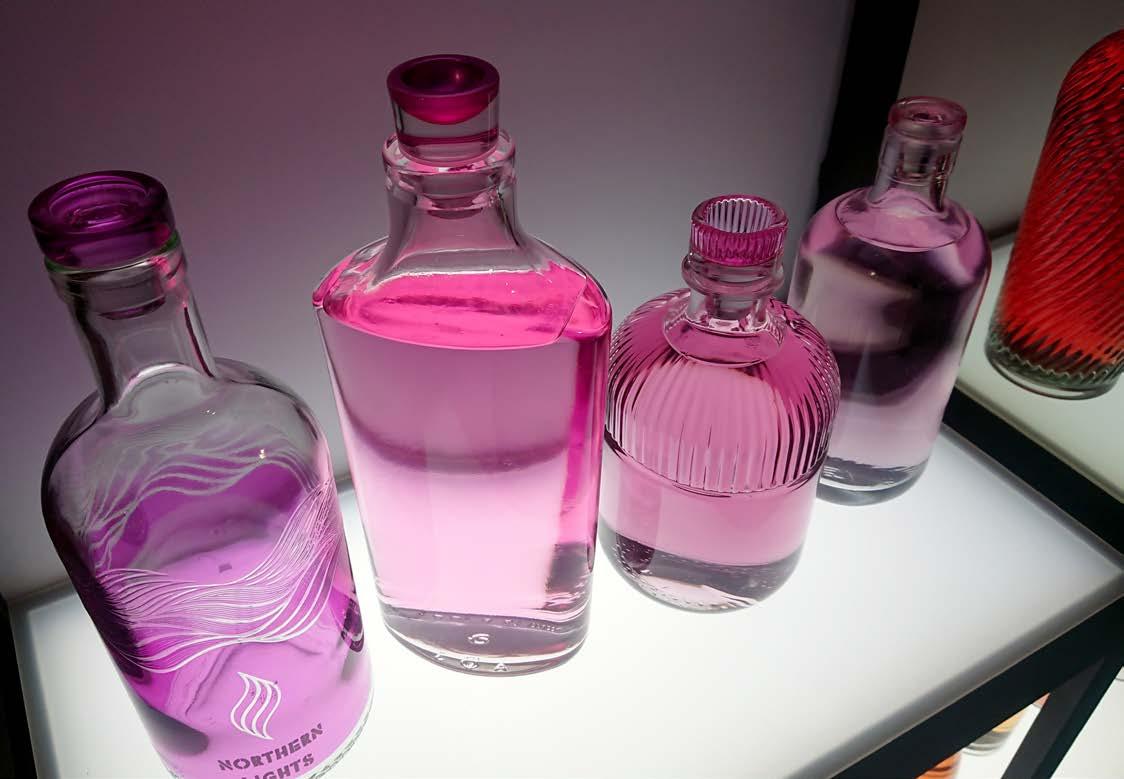
80 Grapegrower & Winemaker www.winetitles.com.au March 2023 – Issue 710 sales & marketing
Bottles & Closures

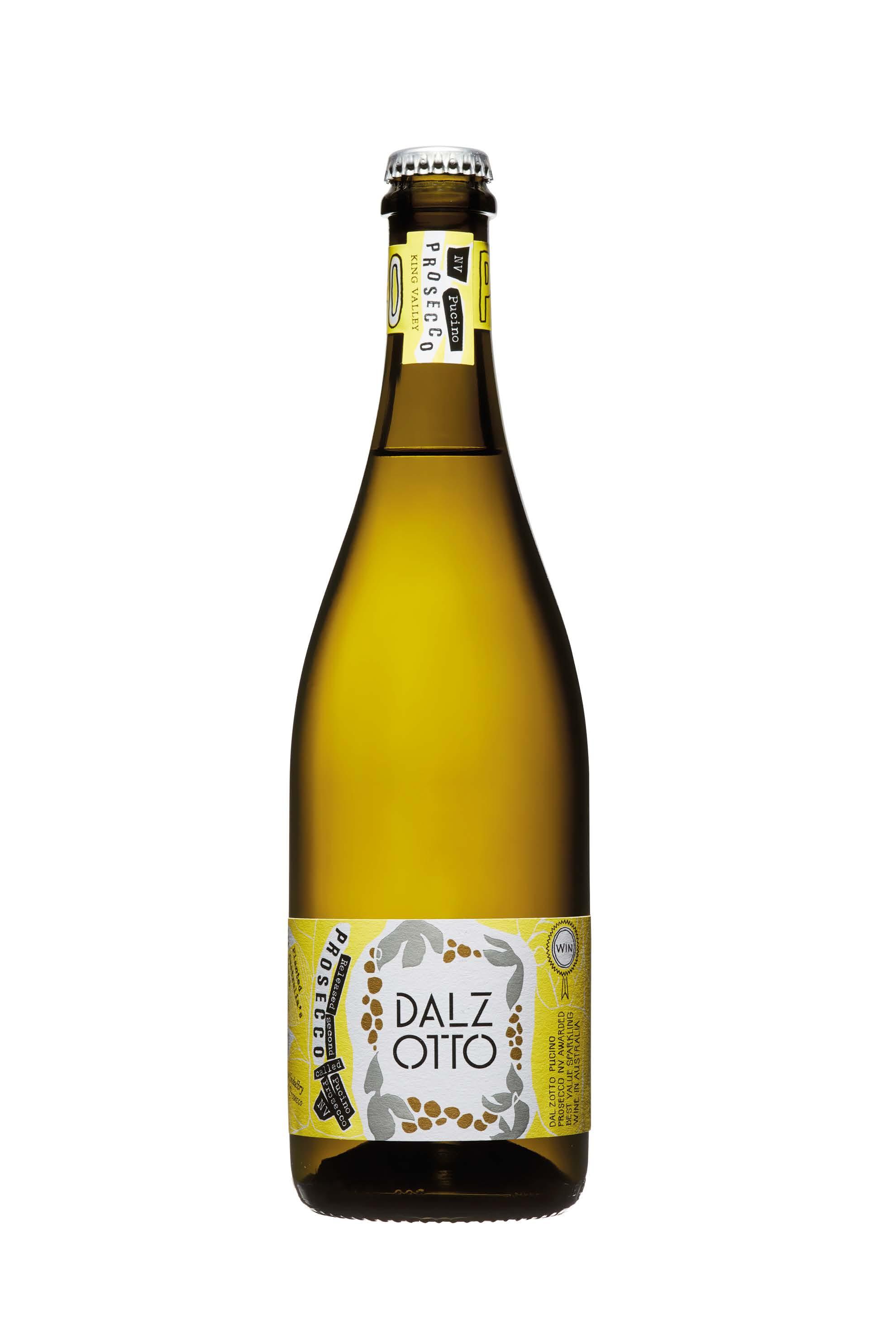
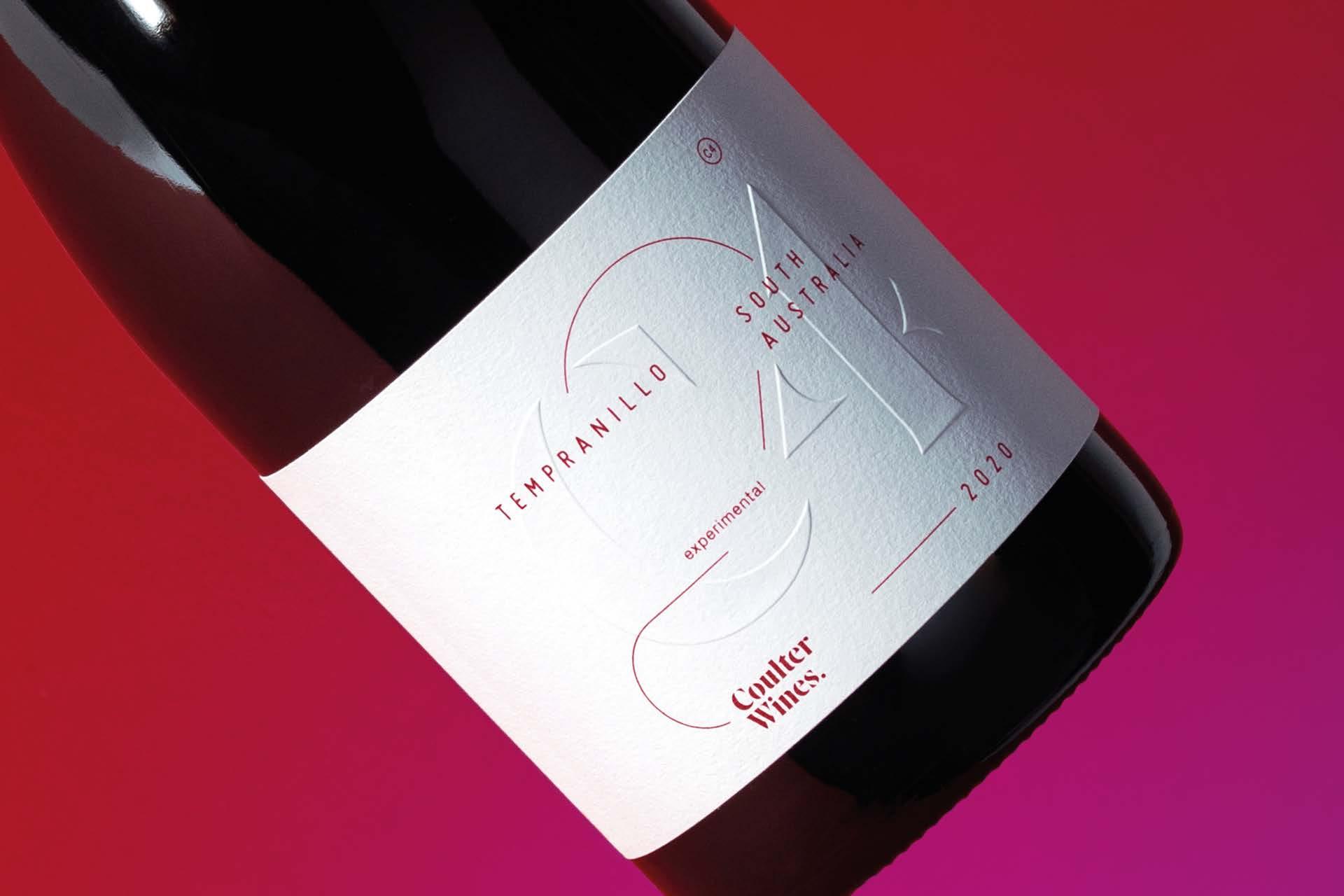
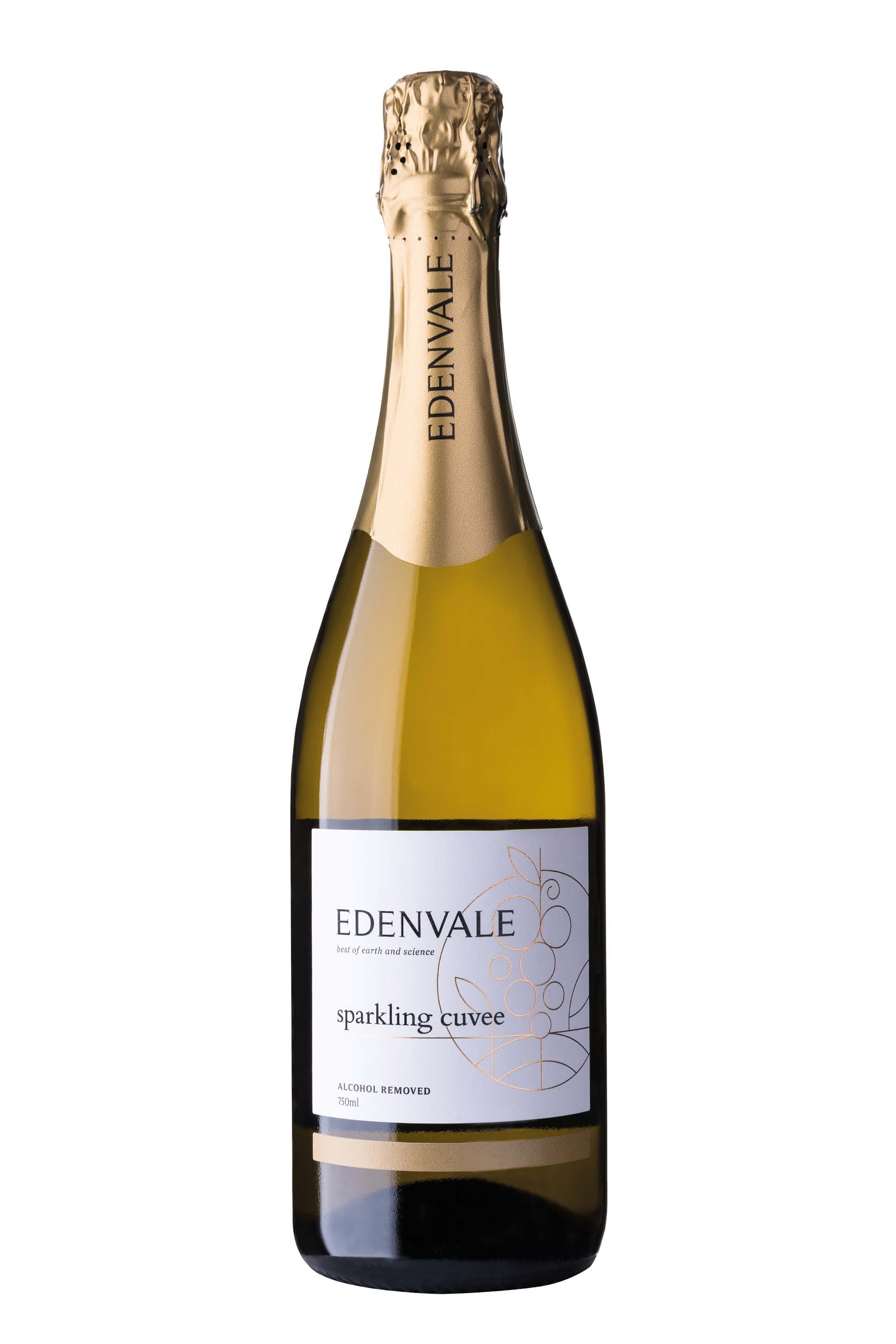
“We started to play with the colours, with the shapes, different techniques for how to decorate a closure and this has become very popular.”
He said although the majority of Vinolok products are still made for the global wine industry, there’s been rapid recent expansion also into the spirits category, which he says has a greater focus on adopting new packaging.
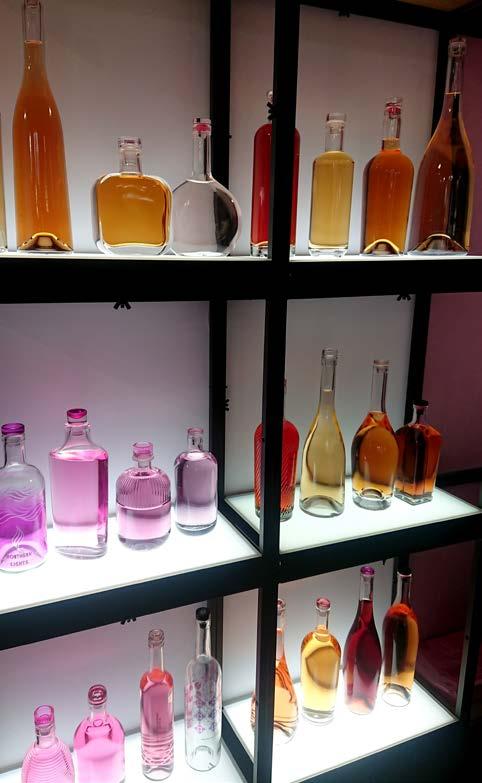

The products are currently sold to producers in around 60 countries.
“France is for us very important,” Haiblik said, “But also other markets including Australia, Italy, Spain and in North America.”
He noted that the Australian market had been important for the growth of the product and that comparative testing has been undertaken by the Australian Wine Research Institute to measure its technical attributes.
Comparative tests
“We have five years of comparative tests and the comparison is always between screwcaps, Vinolok and natural cork.”
Haiblik proudly proclaims that these official results have shown the product in a positive light for the packaging of wine, meaning that producers are choosing it not only for its aesthetic appeal but for its technical properties.
“It’s OTR (oxygen transmission rate) is somewhere between a screwcap and natural cork; it has more microoxygenation than a screwcap but less than cork. So it’s basically 1.3 milligrams per year which is a good feature because it keeps primary tones for longer. At the same time the wine can develop.
“Because it has good OTR properties and it’s also very [stable], after 10 years you can open a case of wines and each one would be the same, so that’s great.”
Haiblik visited Australia last year and reveals that one of the product’s “best references” is South Australian producer Henschke, which was one of the very first customers for the glass product in 2004. Henschke has utilised the Vinolok closure for its red wines, such as Shiraz and Cabernet Sauvignon, and has used it to seal bottles of its icon wine Hill of Grace.
Ultimately, Haiblik says that the unique attributes of his product is helping many producers with the premiumisation of their products and to enhance product differentiation in crowded markets.
“If somebody wants to be different, it they want to work with a special design, then that’s when our product comes into place,” he said.
82 Grapegrower & Winemaker w ww.winetitles.com.au March 2023 – Issue 710 sales & marketing
We started to play with the colours, with the shapes, different techniques for how to decorate a closure and this has become very popular.
Radan Haiblik
Vinolok sales director Radan Haiblik
Vinolok glass closures have being utilised to create unique designs for wine and spirits bottles.
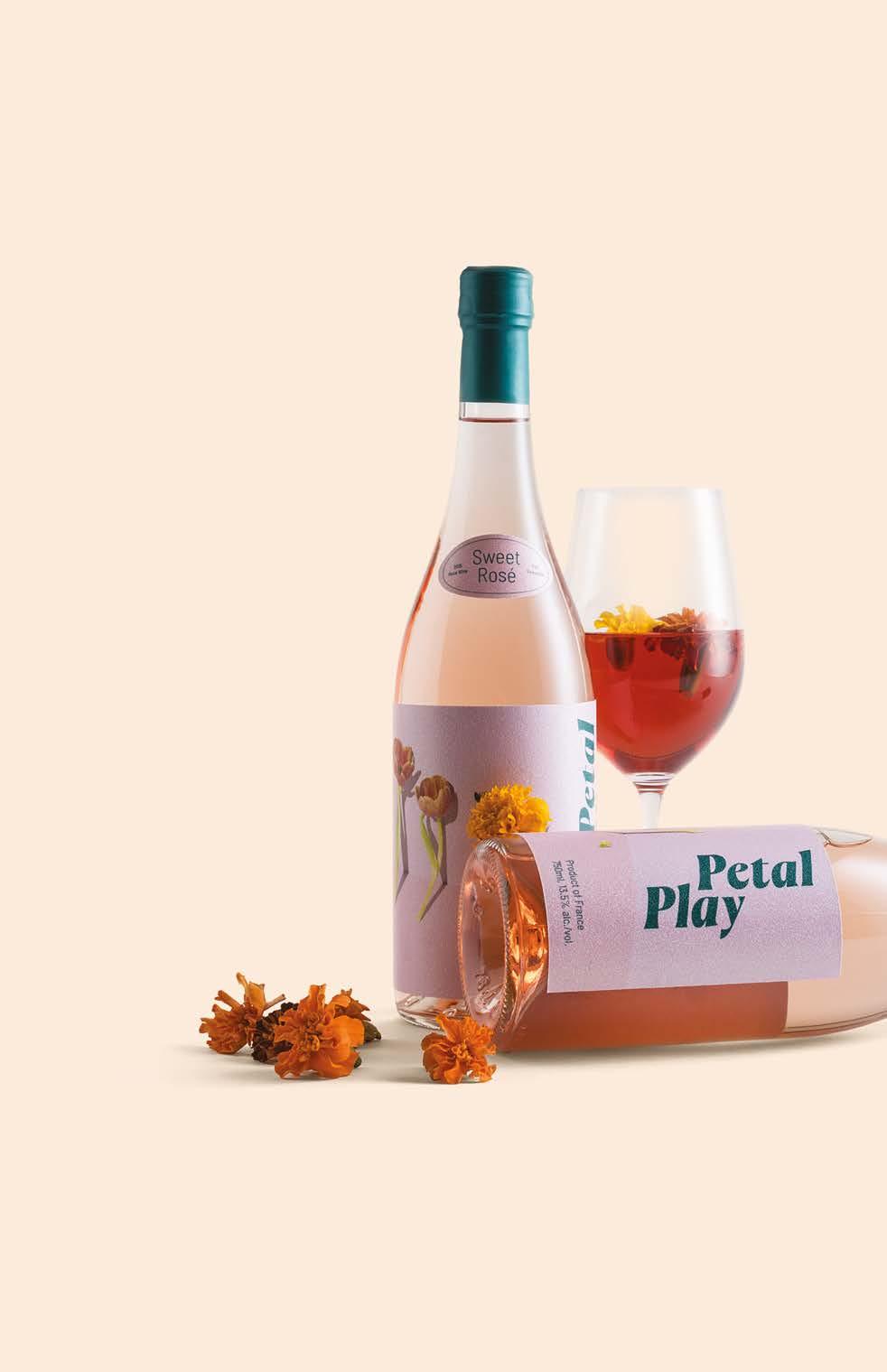
March – Issue 710
The Australian Ark is a mammoth new multi-volume set capturing the full backstory of wine growing and production in Australia. It captures the many twists and turns of Aussie wine, and its unique characters, since the beginning of European settlement. Grapegrower & Winemaker asked author Andrew Caillard MW about the challenges of this massive undertaking and how this unique publication came about.
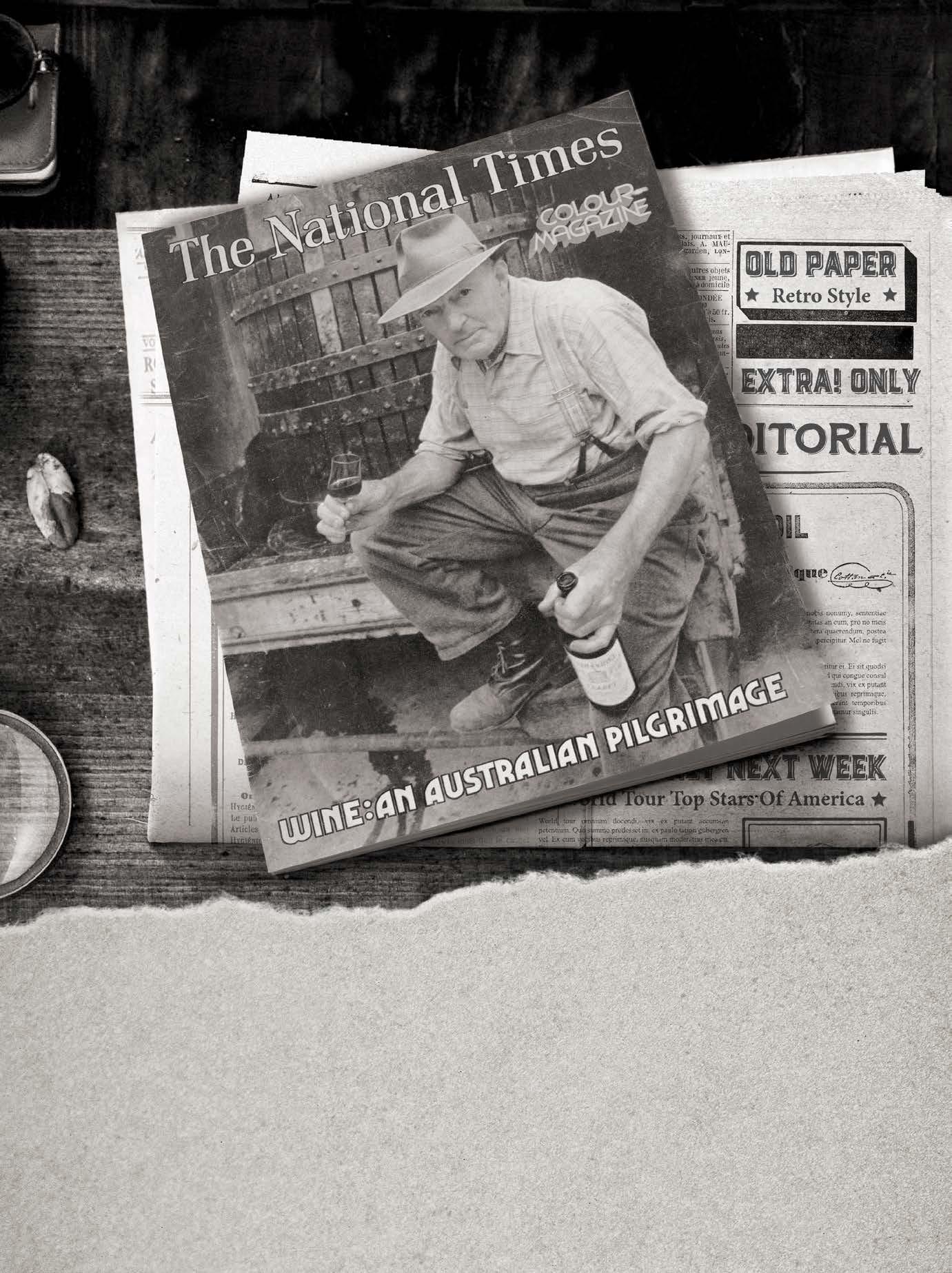
84 Grapegrower & Winemaker www.winetitles.com.au March 2023 – Issue 710
sales & marketing
The flow of Australia’s rich wine history revealed in forthcoming publication
What is The Australian Ark?
The Australian Ark: A History of Australian Wine 1788 onwards is a three volume, 1400 page, 350,000 word, fully-illustrated book that covers first settlement right through to the current day. It documents not only key individuals, wineries and events but also the deeper stories behind them.
The Australian Ark is more than a simple historical text. The work brings in social and political context as well as highlighting the imagination, strength and foresight of Australia’s fine wine pioneers. The third volume also tracks my time in Australia since 1982 where I have been privileged to observe and now document an exciting time in Australian wine history. Throughout my 40 years in Australia I have known many of the key players during their careers and seen the rise of our modern fine wine scene.
The Australian Ark is clearly an immense project that has taken many years. When and how did it start?
Back in 2006, I began working on a project to document Australia’s historic wines. It was in some respects an homage to Max Lake’s charming Classic WInes of Australia (1966), but also a vision to further the cause of Australian wine in the secondary ultra-fine wine market. I have always been interested in Australian wine history as John Reynell, an Australian ancestor of mine, planted one of the first vineyards in South Australia.

Work commitments got in the way after the acquisition of Langton’s, but I restarted the project in 2016 after working on Penfolds Rewards of Patience and Langton’s Classification of Australian Wine. At this stage I was not thinking of writing what has transpired,
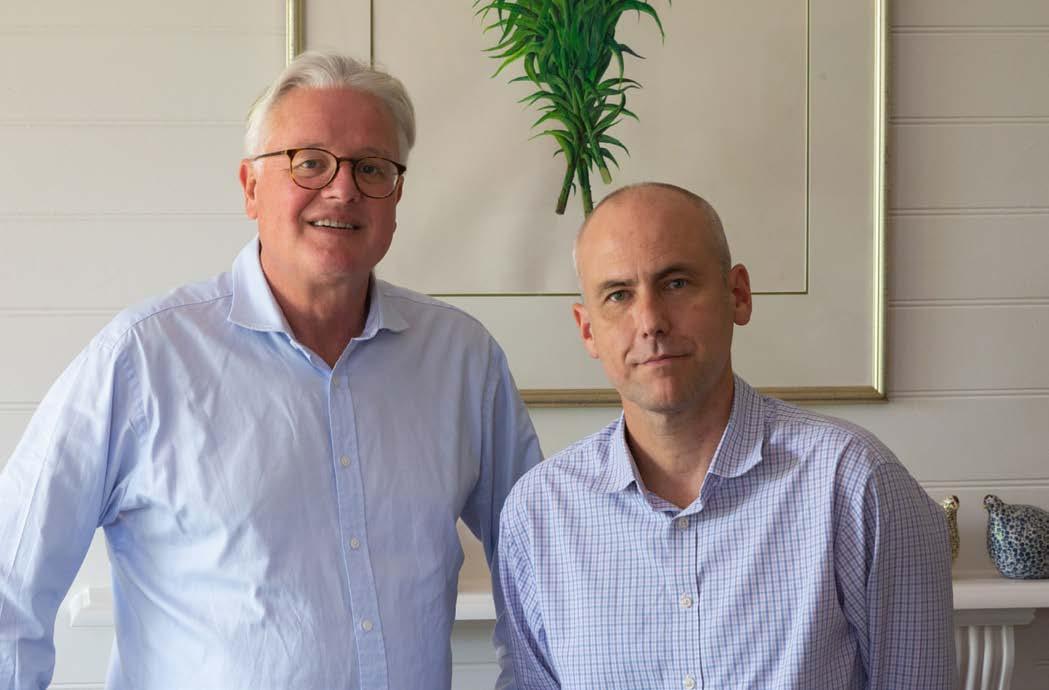
March – Issue 710 www.winetitles.com.au Grapegrower & Winemaker 85
Throughout my 40 years in Australia I have known many of the key players during their careers and seen the rise of our modern fine wine scene.
Andrew Caillard MW
An extensive library of historic photographs and illustrations have been assembled for inclusion in The Australian Ark. Here we see Roly Birks of Wendouree on the cover of the National Enquirer.
Andrew Caillard MW and Angus Hughson
but digital libraries have opened up new avenues of research. These new online resources, particularly the National Library of Australia’s Trove, have completely changed what is available to researchers. As I dug deeper I found an incredible and romantic history that is largely unknown. The size of the book consequently expanded into something much larger than anticipated.
We understand there have also been plenty of challenges in getting The Australian Ark into print. Yes, absolutely. We all know the difficulties in publishing and book sales, particularly for niche books of this magnitude. Two years ago I was quite disheartened with the glacial progress happening with the project. I feared, as a result, that The Australian Ark might get lost in a cupboard. When I bumped into Angus Hughson at an event in Adelaide, I shared my frustrations. After receiving a copy of the manuscript he responded by saying that he thought the work would be better published by us in Australia. And
together we came up with an ambitious plan that would turn The Australian Ark into reality. But Angus has really driven the project forward with amazing energy since that moment.
It involved us taking complete creative control over the project and putting together a small team, including David Longfield from Longueville Media, to manage the production, printing, sales and distribution. The project would also be funded by Foundation Members who shared our vision and its value. In return we will honour their support, in the same way as 18th Century publishers acknowledged their subscribers, by printing their names in every copy of The Australian Ark as well as in any future publications that transpire in the future.
To be quite honest, I was a little anxious to begin with, thinking that it would be difficult to raise hundreds of thousands of dollars for a large wine book. But a range of prominent and incredibly generous Australians, wineries and
wine collectors have come together and supported us to bring The Australian Ark to fruition.
We are also drawing on help from our wider friends and colleagues

86 Grapegrower & Winemaker www.winetitles.com.au March 2023 – Issue 710
sales & marketing
A 1980 article featuring Keith Mugford of Moss Wood Wines in Margaret River.
I wrote The Australian Ark, because I want my children and grandchildren to understand and to be proud of their Australian heritage. The history of Australian wine is really the story of Australia.
Andrew Caillard MW
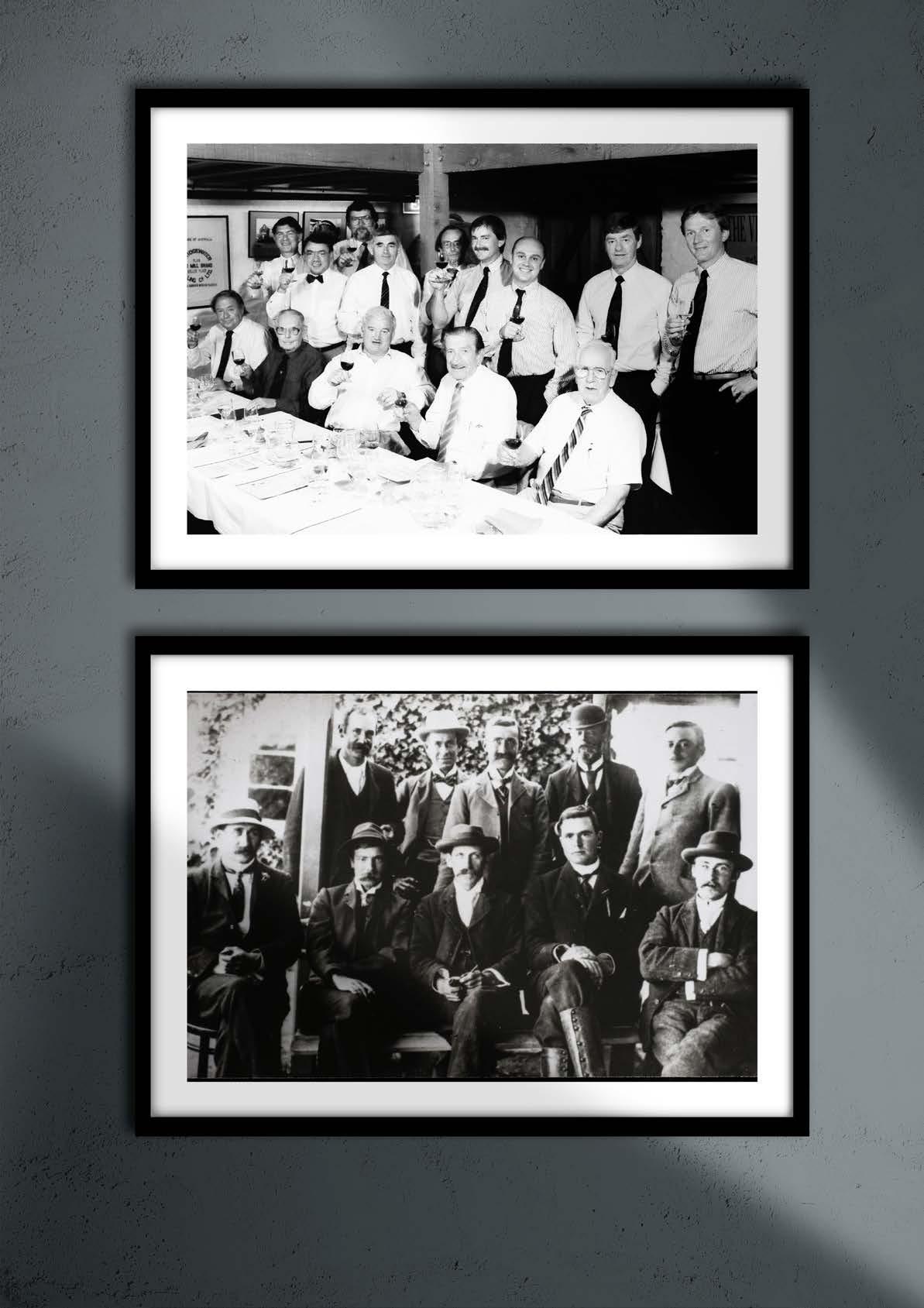 A dinner with Max Schubert, Lens Evans and other wine industry luminaries in 1990
Photo taken at a luncheon held at Wirra Wirra in McLaren Vale c.1900. Shown are (standing L-R) Alexander Campbell Johnston, founder of A.C. Johnston Pty Ltd and Pirramimma Vineyards; Herbert Kay and Frederick Kay, co-founders of Kay Brothers and Amery Vineyards; Frederick Wilkinson, founder of Ryecroft Winery and Fred Shipster, McLaren Vale grapegrower. (Sitting L-R) and Walter Bagenal, managing director of the Emu Wine Company; Robert Wigley, founder of Wirra Wirra Winery & Vineyards; Bob Russel, founder of Katunga Winery & Vineyards, Cuthbert Burgoyne, director of wine merchants and importers Burgoynes of London; and Cyril Pridmore, owner of the Wattles Winery (now Southern Vales Winery).
A dinner with Max Schubert, Lens Evans and other wine industry luminaries in 1990
Photo taken at a luncheon held at Wirra Wirra in McLaren Vale c.1900. Shown are (standing L-R) Alexander Campbell Johnston, founder of A.C. Johnston Pty Ltd and Pirramimma Vineyards; Herbert Kay and Frederick Kay, co-founders of Kay Brothers and Amery Vineyards; Frederick Wilkinson, founder of Ryecroft Winery and Fred Shipster, McLaren Vale grapegrower. (Sitting L-R) and Walter Bagenal, managing director of the Emu Wine Company; Robert Wigley, founder of Wirra Wirra Winery & Vineyards; Bob Russel, founder of Katunga Winery & Vineyards, Cuthbert Burgoyne, director of wine merchants and importers Burgoynes of London; and Cyril Pridmore, owner of the Wattles Winery (now Southern Vales Winery).
from the wine industry and beyond to help with various elements of the project. This has included sending the unedited manuscript to a handful of trusted industry friends, academics and historians for their feedback. Our foundation members also have access to the manuscript and they have been very helpful with feedback and advice.
In addition, we plan that the eventual profits will fund projects to research and share Australian wine history, as well as future updated editions of The Australian Ark. With industry buy-in and support, we believe that The Australian Ark will contribute positively to the long-term impact on Australian wine stocks, both here and abroad.
Where does The Australian Ark currently stand?
We are close to the end at last! Most chapters are complete and edited but there are some minor revisions. The team has also collected a huge library of photographs and illustrations, commissioned maps and started on the design so everything is on track for publication in October and November this year. Geoffrey Robertson AO KC has also generously written a perfect forward to the book. I have great admiration for his work and I couldn’t think of anyone better for this task.
The Australian Ark is now available for pre-order with special trade prices so that the industry can share The Australian Ark and profit from it.
Will the publication be made available to industry and trade operators?
This project is independently funded and published so we do not have the backing of a large publisher to carry significant volumes of stocks. On the other hand the quality will be so much better, as we are publishing it without compromise. So we are now selling The Australian Ark via a pre-sales campaign at australianark. com, which closes on 15th this month (March). Trade discounts are currently available and we are taking a 20% deposit on all orders with invoicing for the remainder plus delivery later in the year. Our early timing for pre-sales is to guarantee production timelines and delivery in late 2023.
We think this is the key opportunity to purchase The Australian Ark with only limited volumes available from bookstores later in the year. The presales campaign will also be the only opportunity to purchase a highly limited run of linen and leather bound Collector’s Editions of The Australian Ark , or bespoke tailored hard-back editions.
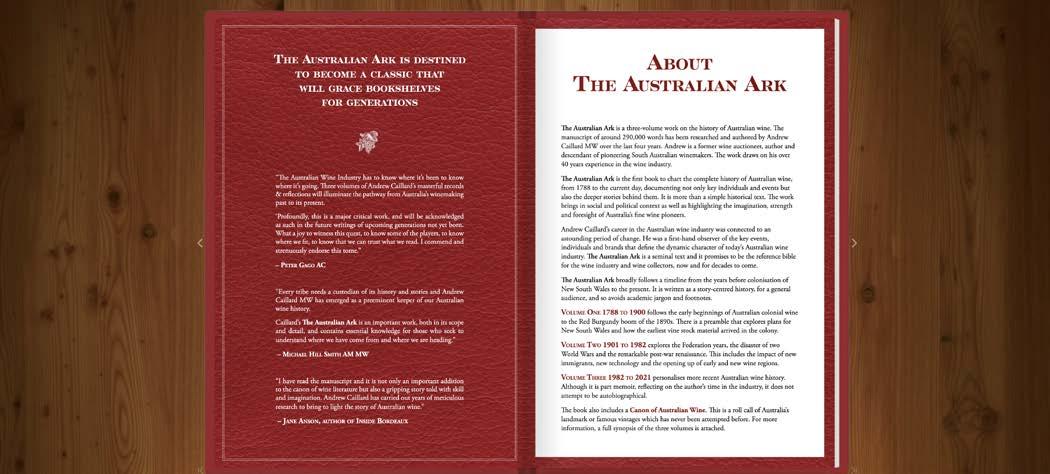
For the trade, The Australian Ark is available to purchase both in small numbers but also with larger volume options so that wineries, exporters, retailers as well as trade and regional organisations can gift or sell The Australian Ark to their databases and customers. Many observers have said that the industry and trade needs a book like this, so hopefully this translates to wide support from all sectors of the wine industry and trade.
Individual tailored editions with bespoke/ branded covers and slipcases are also
available. We believe these personalised hard-back editions will offer the wine trade a unique opportunity to promote Australian wine, regions and brands. By supporting this project as pre-release buyers, the trade will help us achieve our goal of making a big difference to the awareness of Australian wine and its history at home and overseas.
What are your plans for The Australian Ark after publication later this year?
I am hoping The Australian Ark will start a conversation and build momentum for Australian wine. There will be some initial book launches in key destinations and markets during 2024, but I am hoping the release of The Australian Ark will start a new chapter in Australian wine writing as well. This is all about preparing the ground for the next generation and steering the conversations away from ephemeral noise towards something more substantial and lasting. I wrote The Australian Ark, because I want my children and grandchildren to understand and to be proud of their Australian heritage. The history of Australian wine is really the story of Australia.
The Australian Ark is available to prepurchase at australianark.com until March 15 with trade and wholesale discounts applicable.
88 Grapegrower & Winemaker www.winetitles.com.au March 2023 – Issue 710 sales & marketing
How did you get your start in wine?
Growing up in the late ‘80s/early ‘90s, New Zealand wine was starting to get some international attention. My Dad became quite interested in wine as a result and so I bought him a copy of the Cuisine New Zealand Wine Annual for his birthday. I think he flicked through it and left it on the coffee table whereupon I picked it up, started reading and well and truly got the bug. I visited wine regions any chance I got, did wine appreciation classes and bought as much as my meagre student budget would allow. Eventually I chucked in an accounting degree and moved to Hawke’s Bay to study wine science. My first paying job in the industry was a summer job in Church Road vineyards. I never really left after that.
What is the best thing about working in the wine sector?
It’s an incredibly engaging occupation that becomes a vocation for many and that creates a fantastic community of creative, hard-working and passionate people. It’s a lot of fun, it’s very rewarding and goes beyond the wine industry itself. The fine wine scene in Hawke’s Bay was the catalyst for the whole region becoming a more interesting place. It was a key driver of higher value tourism, it drove demand for an amazing accommodation and a decent dining scene, and that all brings in and inspires more creativity and it starts to snowball. When I moved here in 1995 it felt a little bit sad and old fashioned. There wasn’t a lot going on and it felt very conservative. In the last 28 years, that has changed a lot.
What have been some of the highlights of your career in wine?
Definitely the quality progression of Church Road wines and seeing that reflected in the run of incredible international accolades we’ve had over the last few years. We’re always learning, always trialling and always evolving the wines. There have been many small incremental gains as we get older and wiser, and the occasional giant leap forward, for example with greatly improved vineyard resource and major changes to winemaking philosophy and methodology.
What are some characteristics of New Zealand wine that help it stand out from other countries?
To lump all of New Zealand’s wine regions together is similar to lumping all of France together. It becomes a bit of a blunt analysis that doesn’t reflect the richness and diversity our wine scene. Sub regional variation is huge. I think what sets New Zealand apart is that we’re an island nation a long way away from any continental influence. We get low dust pollution and therefore exceptional light quality, and we’re strongly maritime in most regions, with the moderating effect of the sea keeping days cooler and nights warmer. The ripening curve is long and gentle and this delivers exceptional vibrancy. The best New Zealand wines balance ripeness and depth of concentration with structural elegance and aromatic freshness.
What are some of the challenges involved with being a part of the winemaking industry?
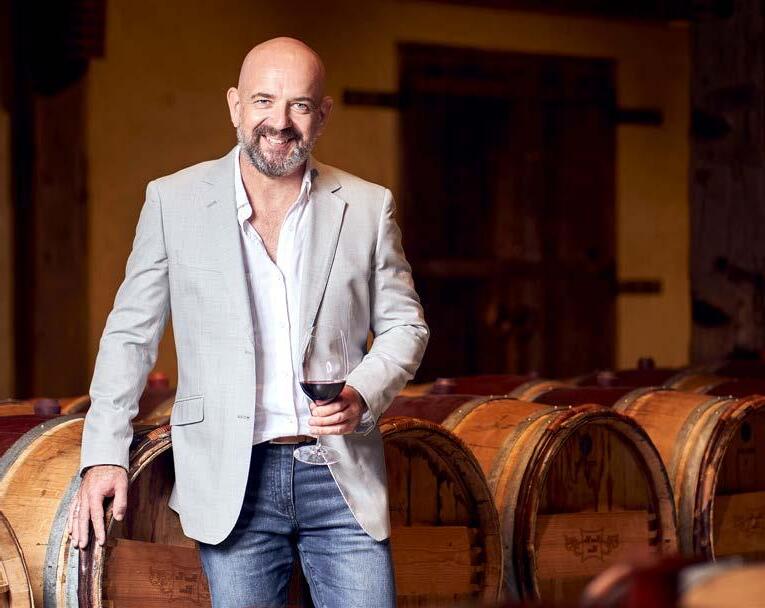
Juggling commitments. I’m sure most
winemakers would love it if they could spend 100 per cent of their time focussed on winemaking. Of course, that’s not the reality but it’s important to find a balance. It’s also a crowded market. Even I get overwhelmed by choice when I have my consumer’s hat on. We’re incredibly lucky to have such a strong and established name, and we aim to maintain that position by protecting and evolving the quality of the wines.
What would be your advice to someone just entering the industry?
Train your palate. And I don’t just mean wine, though of course that’s important. Learn good food, learn good cooking, learn about balance, always try to taste consciously and learn the science of how we taste and what influences our perceptions. Your palate is your most important tool and if you want to make great wine, it should be relied on above lab analysis or theory or prevailing winemaking trends of the day.
What place do alternative varieties have in the New Zealand wine industry?
It’s great fun exploring alternative varieties and styles too and while many of them don’t ever end up being a huge commercial success, they do add colour and interest and news to a brand and the cellar door allows us an outlet for small volumes and to test consumer response. Marzemino, a little known Italian red variety has been a huge hit with our regulars. It ages amazingly well too. Who knows which of the alternative varieties planted now might become part of the fabric of the region in years to come.
Location:
March – Issue 710 www.winetitles.com.au Grapegrower & Winemaker 89
producer profile
CHRIS SCOTT
Chief Winemaker, Church Road
It’s been a fantastic resource. I remember it even as a student as being an incredibly insightful and practical publication.
- Chris Scott on the Grapegrower & Winemaker
Napier, Hawke’s Bay New Zealand
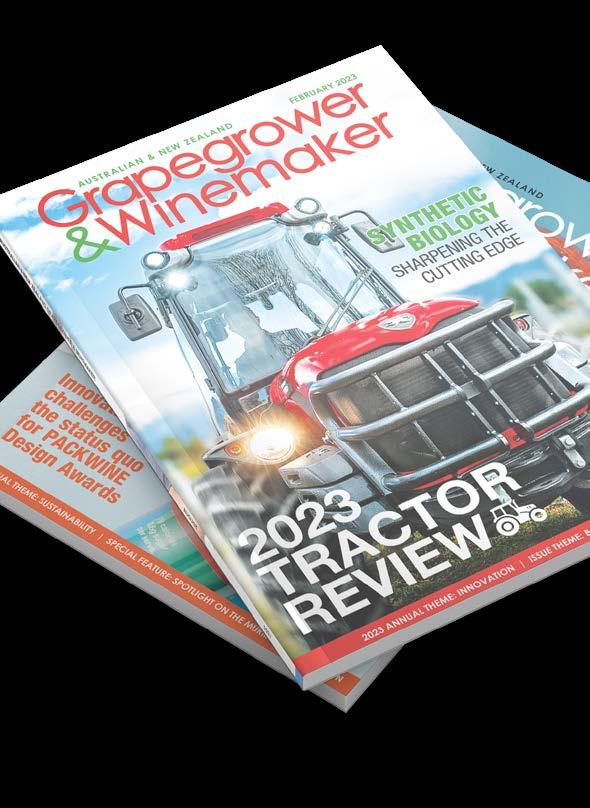
90 Grapegrower & Winemaker www.winetitles.com.au March 2023 – Issue 710 India’s wine market is growing rapidly from its low base Separator Technology Solutions www.sts-la.com 22 Agnova Technologies Pty Ltd www.agnova.com.au 33 Avery Dennison www.averydennison.com 83 Amorim Australasia amorimcork.com.au 41, 42, 43, 44 Aussie Wine Group www.aussiewinegroup.com.au 25 Bahco www.bahco.com 40 Braud Australia www.braud.com.au 29 BSI Group bsigroup.com/en-au 9 Bruce Gilbert Vine Grafting www.brucethegrafter.com.au 93 Della Toffola Pacific www.dtpacific.com Back Cover Fischer Australis fischeraustralis.com.au 11 GH Parts www.ghparts.com.au 92 Global Green www.globalgreen.com.au 23 Grapeworks www.grapeworks.com.au 45, 59 Grochem www.grochem.com 19 Haifa Group Haifa-group.com 31 James Print www. jamesprint.com.au 81 Kauri kauriwine.com 57 Kendon Chemicals www.kendon.com.au 15 Landini Central www.landinicentral.com.au 35 Ocloc ocloc.com.au 21 Orchard Rite orchard-rite.com 39 Plastic Precise Parts ppp@tpg.com.au 92 Rapidfil www.rapidfil.com.au 54, 93 Ryset ryset.com 24 Sumitomo Chemicals sumitomo-chem.com.au 17 Syngenta www.syngenta.com.au 37 VAF Memstar vafmemstar.com.au 52 Vin Wizard vinwizard.com 51 Wine Industry Services wineindustryservices.com.au Inside Back Cover Winequip www.winequip.com.au 2,3 Thank you to all our advertisers in this issue! Call Louise on +61 8 8369 9513 or email l.reid@winetitles.com.au Position your brand in the leading industry magazine that is popular amongst industry decision makers, including SMEs, vignerons, business owners, winemakers, grapegrowers, consultants
& Winemaker?
Why advertise in Grapegrower
Event dates may be subject to change or cancellation. Please refer to event websites for updated information. Travel restrictions may also apply.
International
looking back
19-21 March 2023
3-6 April 2023
ProWein 2023 – Germany, Düsseldorf, Germany www.prowein.com/
WSWA (Wine & Spirits Wholesalers of America) Annual Convention & Exposition, Orlando, Florida, US http://wineindustryadvisor.com/event/wswa-annual-con
vention-2022-wine-spirits-wholesalers-of-america-annual-convention-exposition
16 April 2023
Decanter World Wine Awards-20th, London, UK www.decanter.com/decanter-awards/
17-28 April 2023 International Wine Challenge –Tranche 2, London, UK www.internationalwinechallenge.
We step back in time to see what was happening through the pages of Grapegrower and Winemaker this month 10, 20 and 30 years ago.
March 2013
Mornington Pinot comes a long way
3-6 April 2023
WSWA (Wine & Spirits Wholesalers of America) Annual Convention & Exposition, Orlando, Florida, US wineindustryadvisor.com/event/wswa-annual-convention-2022-wine-spirits-wholesalers-of-america-annual-convention-expositioncom/
8 May 2023
30 May 2023
Asia Wine Challenge, Hong Kong www.asiawinechallenge.org
ASIA AWARDS, Japan
www.theawardsasia.com/2022/en/page/home
See more on the Wine Industry Directory Events calendar at winetitles.com.au/wide
Subscribers to Grapegrower & Winemaker can access back issue here: winetitles.com.au/gwm

Nearly 200 people attended the biennial Mornington Peninsula International Pinot Noir Celebration last month to showcase their wines and hear from experts. Now in its sixth year, the MPIPNC is a two day event that features structured tastings of Pinot Noir from around the world and presentations from wine experts.
March 2003
Corporation studies impact of Coonawarra boundaries appeal
The Australian Wine & Brandy Corporation (AWBC) is reviewing the way its Geographical Indications Committee (GIC) operates following the Federal Court’s decision to allow the appeals against the boundaries of South Australia’s Coonawarra region set by the Administrative Appeals Tribunal (AAT).
March 1993
Wirra ‘missionary’ to Europe
Wirra Wirra Vineyards, at McLaren Vale, South Australia, has taken another step in its export campaign by appointing Henry Rymill as its European marketing and promotions manager. Rymill is based in London and is working closely with Wirra Wirra’s UK agent, Hugh Phillips, of Boxford Wine Co., to boost export sales.
Did you know that your digital subscription to the Grapegrower & Winemaker allows access to archived digital copies of the magazine dating all the way back to 2005?
To download the back issues visit: winetitles.com.au/gwm
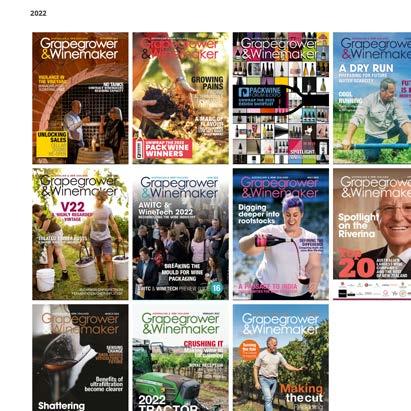
March – Issue 710 www.winetitles.com.au Grapegrower & Winemaker 91
-
calendar
The Power Weeder



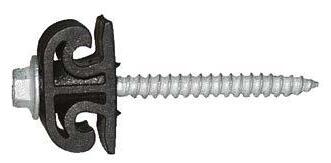
POWERWEEDER PROFESSIONAL and the POWERWEEDER MINI, when fitted to a brushcutter/whipper snipper, are designed to allow the operator to rapidly weed & mulch around valuable plants without damaging them. The unique cutting/mulching action creates an organic “green compost”, more downward pressure results in a “bare earth” finish.The secret is the smooth upturned edges on both weeders and the downward facing rotor blades prevent ring barking.
The Flusher Valve
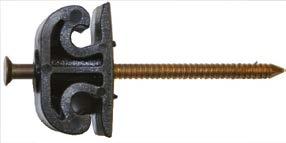
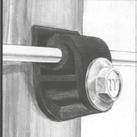
Automatic Flusher Valve for Irrigation Hose Incorporating Spiralfast™ Tension Ties. Available in four sizes to fit 13mm and 15mm, 17mm and 19mm inside diameter dripper irrigation lines.


Now you can allow air to evacuate from the end of your dripper line and automatically shut off when the water reaches the valve. When water pressure is turned off the valve automatically opens, allowing flushing and drainage of lines. Also can be wedged open for power flushing.
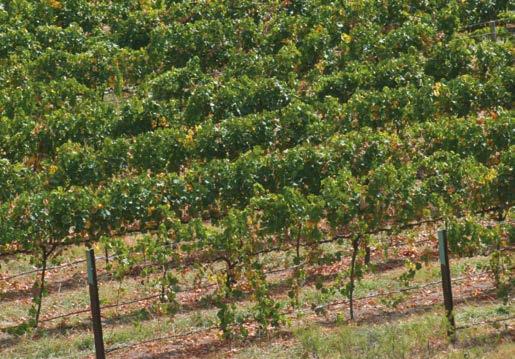
FOR INDUSTRY EMPLOYMENT, TRADES & SERVICES IN PRINT & ONLINE marketplace Cost-effective wire-to-post fastening using the successful Vini Clip System. Specially developed for the viticulture industry to provide positive wire-to-post fastening, will not dislodge with harvesting or pruning, single or double ended.
Clip
61 2 9482 5663 • 0427 476 366 • ppp@tpg.com.au All Products Proudly Australian and available from our warehouse in Sydney PLASTIC PRECISE PRODUCTS Won’t let you down! Double end clip for tension up or down. Screw Clip Won’t let you down! Nail Clip Double end clip for tension up or down.
The Vini
System
61 2 9482 5663 ppp@tpg.com.au All Products Proudly Australian and available from our warehouse in Sydney Water exits here 61 2 9482 5663 ppp@tpg.com.au All Products Proudly Australian and available from our warehouse in Sydney
Tired of paying too much for your grape harvester parts? Where quality meets a ff ordability. info@ghparts.com.au We have a range of parts to suit the following makes of grape harvesters Braud • Gregoire • Pellenc AND MORE... Visit us at ghparts.com.au
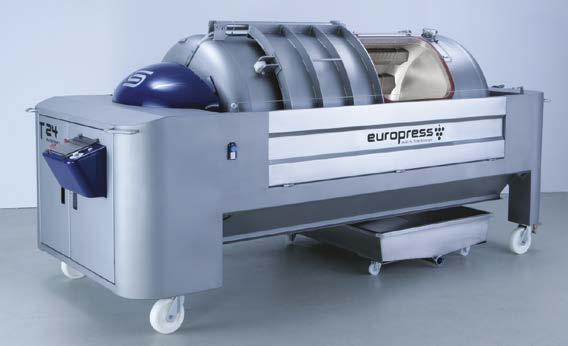

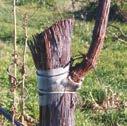
GET INTO THE MARKET PLACE E: l.reid@winetitles.com.au P: +61 8 8369 9513 marketplace Call Louise Reid today on +61 8 8369 9513 l.reid@winetitles.com.au GET INTO THE 13x6 13x3 6x3 Be in the Marketplace for Industry employment, Trades & Services CHOOSE YOUR SIZE INTRO OFFER Don’t miss out on our special introductory offer to be part of the Marketplace! 03 9455 3339 • www.rapidfil.com.au WINE PRESS SERVICING • Preventative maintenance & breakdown repairs for all makes and models. • 24/7 coverage during vintage. • Large inventory of spare parts. • Membrane replacement. • PLC upgrades and design improvements. Electrical & mechanical expertise. GRAFTING VINE brianvic1@bigpond.com www.brucethegrafter.com Brian Phillips 0417 131 764 Bruce Gilbert 0428 233 544 Contact us today to get your vines ready for the next growing season DID YOU KNOW? You can visit our website for comprehensive grafting tips and information on after care Celebrating 25 years in business!





marketplace FOR INDUSTRY EMPLOYMENT, TRADES & SERVICES IN PRINT & ONLINE BUY • SELL • NEW • USED THE online marketplace for ... Grapes, clean skins, bulk wine exchange, new & used equipment, services and real estate. Register and post your ad FREE on www.winetitlesclassifieds.com.au created & managed by Winetitles Classifieds offers direct links between wine and viticulture industry buyers and sellers for various products and services. Wherever you go, we’re with you! Wine Industry news at your fingertips— delivered to your inbox daily. Subscribe for FREE winetitles.com.au/news *excludes weekends and public holidays DWN phone promo with website.indd 1 24/1/19 1:25 pm



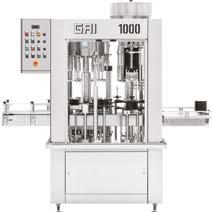
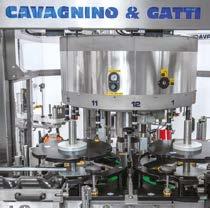
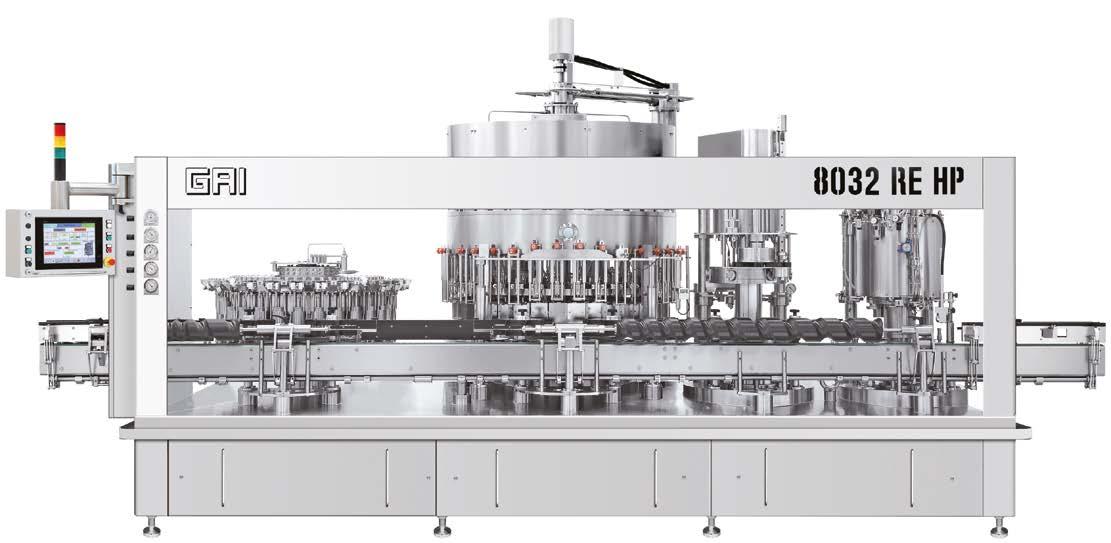

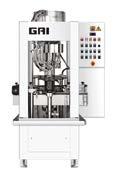
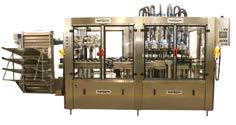
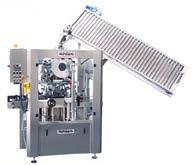
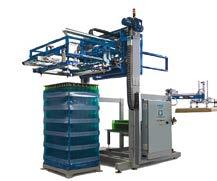
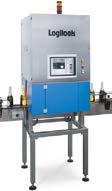
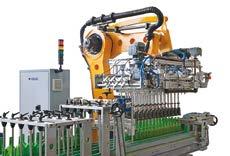

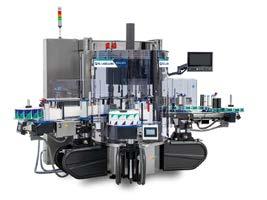
Technical sales, service and backup support for Australian Wine Bottling Lines for over 20 years. www.wineindustryservices.com.au Successfully delivering bottling & packaging solutions to an impressive list of Australian customers for over 20 years. Industry Park 5 Edison Drive, Golden Grove, SA 5125 Australia +61 8 8251 5055 sales@wineindustryservices.com.au sales@wineindustryservices.com.au service@wineindustryservices.com.au spareparts@wineindustryservices.com.au Industry Park 5 Edison Drive, Golden Grove, SA 5125 Australia +61 8 8251 5055 www.wineindustryservices.com.au Depal
Closing Wirehood Labelling
Rinse / Fill / Cap Capsuling
Inspection Packing Palletising
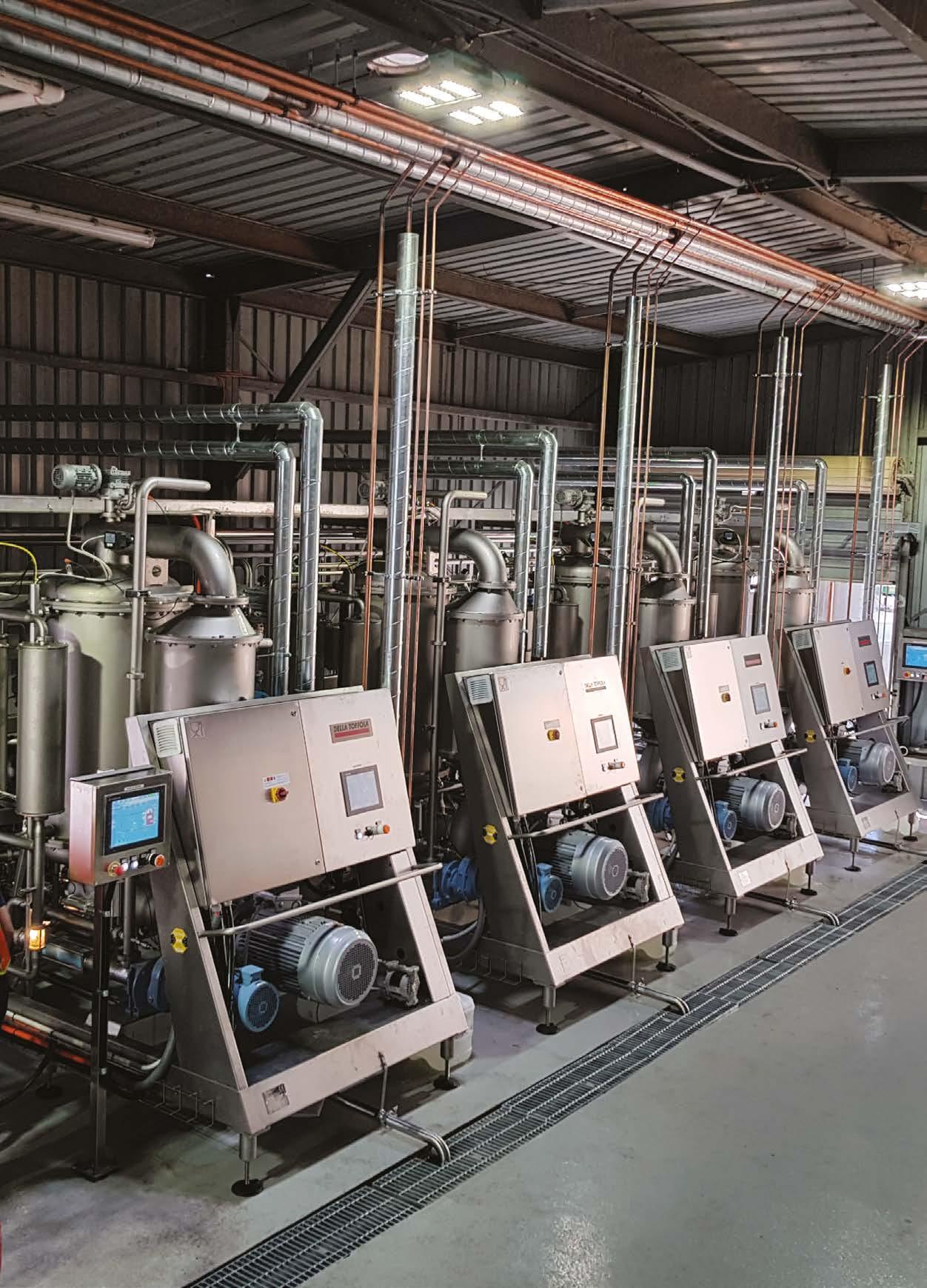



















 Hans Mick Editor
Hans Mick Editor






























 By Richard Smart¹
By Richard Smart¹
































































































































 A dinner with Max Schubert, Lens Evans and other wine industry luminaries in 1990
Photo taken at a luncheon held at Wirra Wirra in McLaren Vale c.1900. Shown are (standing L-R) Alexander Campbell Johnston, founder of A.C. Johnston Pty Ltd and Pirramimma Vineyards; Herbert Kay and Frederick Kay, co-founders of Kay Brothers and Amery Vineyards; Frederick Wilkinson, founder of Ryecroft Winery and Fred Shipster, McLaren Vale grapegrower. (Sitting L-R) and Walter Bagenal, managing director of the Emu Wine Company; Robert Wigley, founder of Wirra Wirra Winery & Vineyards; Bob Russel, founder of Katunga Winery & Vineyards, Cuthbert Burgoyne, director of wine merchants and importers Burgoynes of London; and Cyril Pridmore, owner of the Wattles Winery (now Southern Vales Winery).
A dinner with Max Schubert, Lens Evans and other wine industry luminaries in 1990
Photo taken at a luncheon held at Wirra Wirra in McLaren Vale c.1900. Shown are (standing L-R) Alexander Campbell Johnston, founder of A.C. Johnston Pty Ltd and Pirramimma Vineyards; Herbert Kay and Frederick Kay, co-founders of Kay Brothers and Amery Vineyards; Frederick Wilkinson, founder of Ryecroft Winery and Fred Shipster, McLaren Vale grapegrower. (Sitting L-R) and Walter Bagenal, managing director of the Emu Wine Company; Robert Wigley, founder of Wirra Wirra Winery & Vineyards; Bob Russel, founder of Katunga Winery & Vineyards, Cuthbert Burgoyne, director of wine merchants and importers Burgoynes of London; and Cyril Pridmore, owner of the Wattles Winery (now Southern Vales Winery).


































